34 marvelous hidden gems in Portugal
This post may contain affiliate links. If you use these links to buy something I may earn a small commission at no extra cost to you! Thank you for your support!
Come with me to discover the most wonderful hidden gems in Portugal! From magical medieval churches and lost places in the mountains, to charming villages hidden from the summer crowds, Portugal has plenty of gems to discover off the beaten path.
We have spent several months traveling around Portugal and exploring everything this captivating country has to offer, so read along if you want to get to know a quieter side of Portugal. Including some unique places you definitely won’t find in most Portugal travel guides.
In this blog post, you will find the secret spots and best hidden gems in Portugal with descriptions, photos, and locations on the map, so you can choose your favorites and add them to your Portugal travel itinerary! Happy exploring!
1. Portugal’s most colorful church: Igreja Matriz de Válega
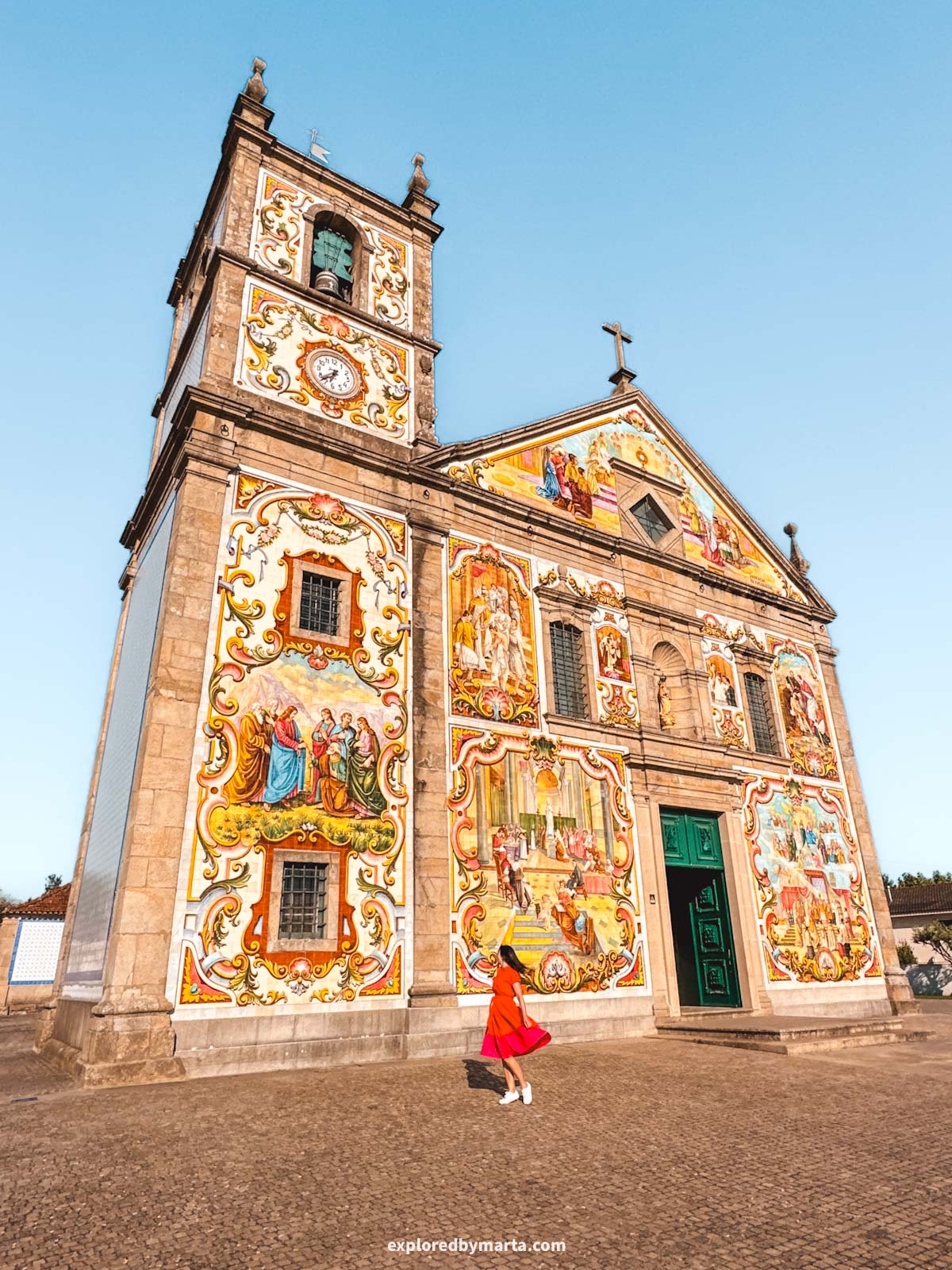
Honestly, Igreja Matriz de Válega is not only the most colorful church I’ve seen in Portugal, but it is the most colorful church I have seen in the world. And I’ve seen a considerable number of churches while traveling around the world!
This unique church is one of the most beautiful hidden gems in Portugal, and a favorite of mine, for sure. Both, exterior and interior of this church are covered with colorful tiles depicting different biblical illustrations.
The best part? You can visit this absolute marvel for free!
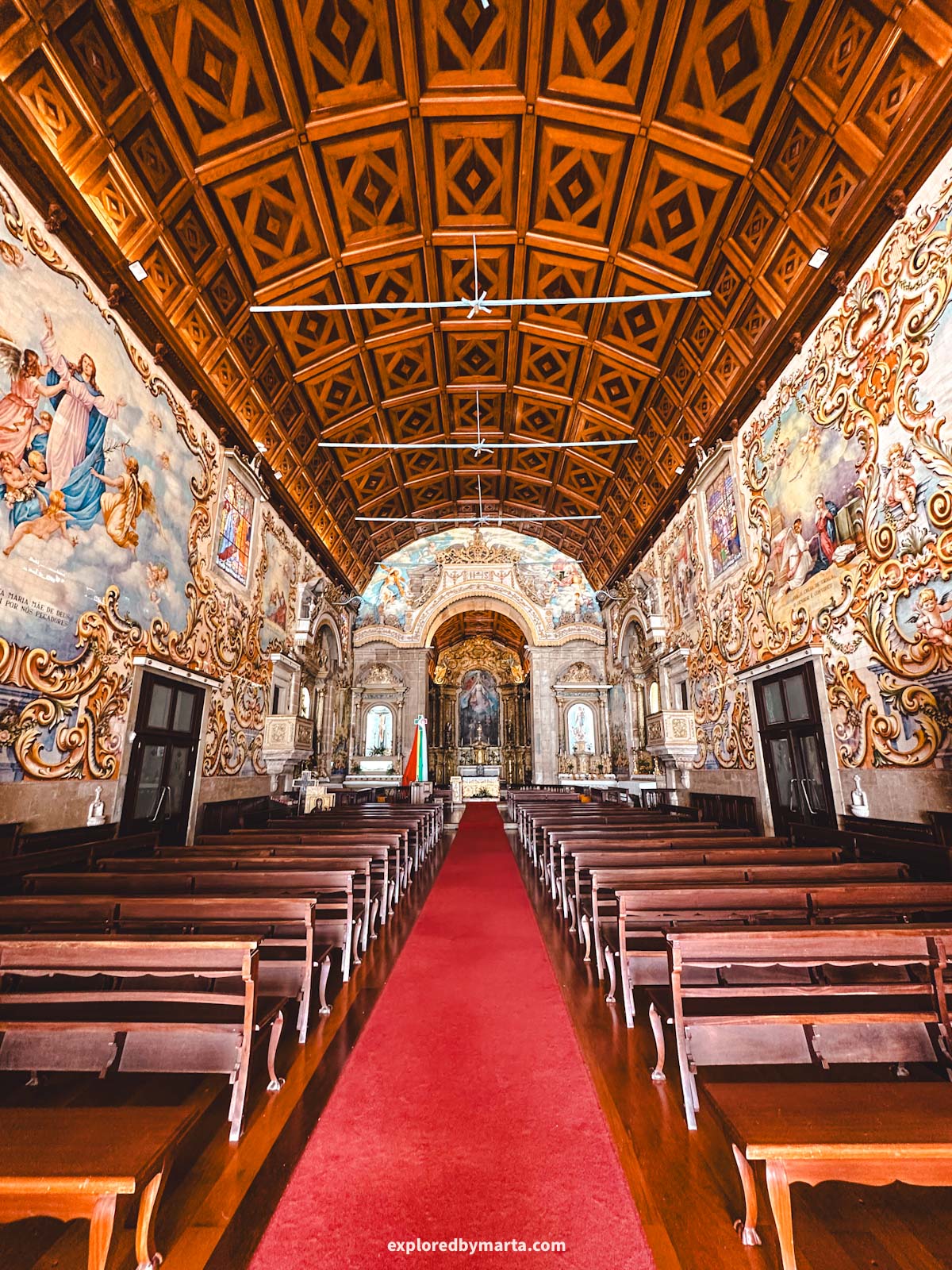
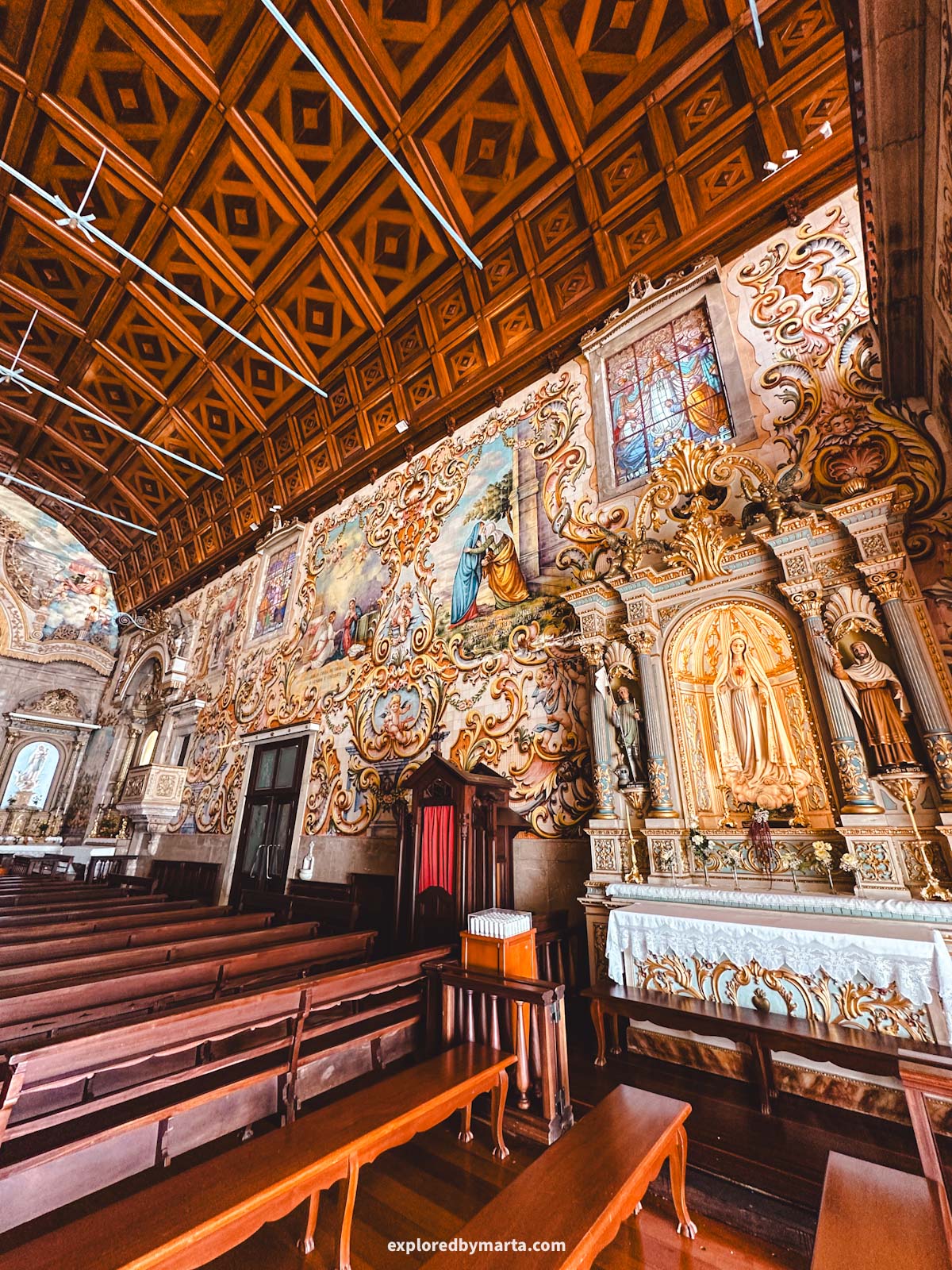
The church is located in Válega, a small town in the Aveiro district, not really known to the regular traveler, and is only a 40-minute drive South from Porto.
Do you think this church is a good reason to make a stop in this town? I definitely do.
While this church dates back a thousand years, the construction of Igreja Matriz de Válega, as we see it today, started in the middle of the 18th century and lasted for a hundred years.
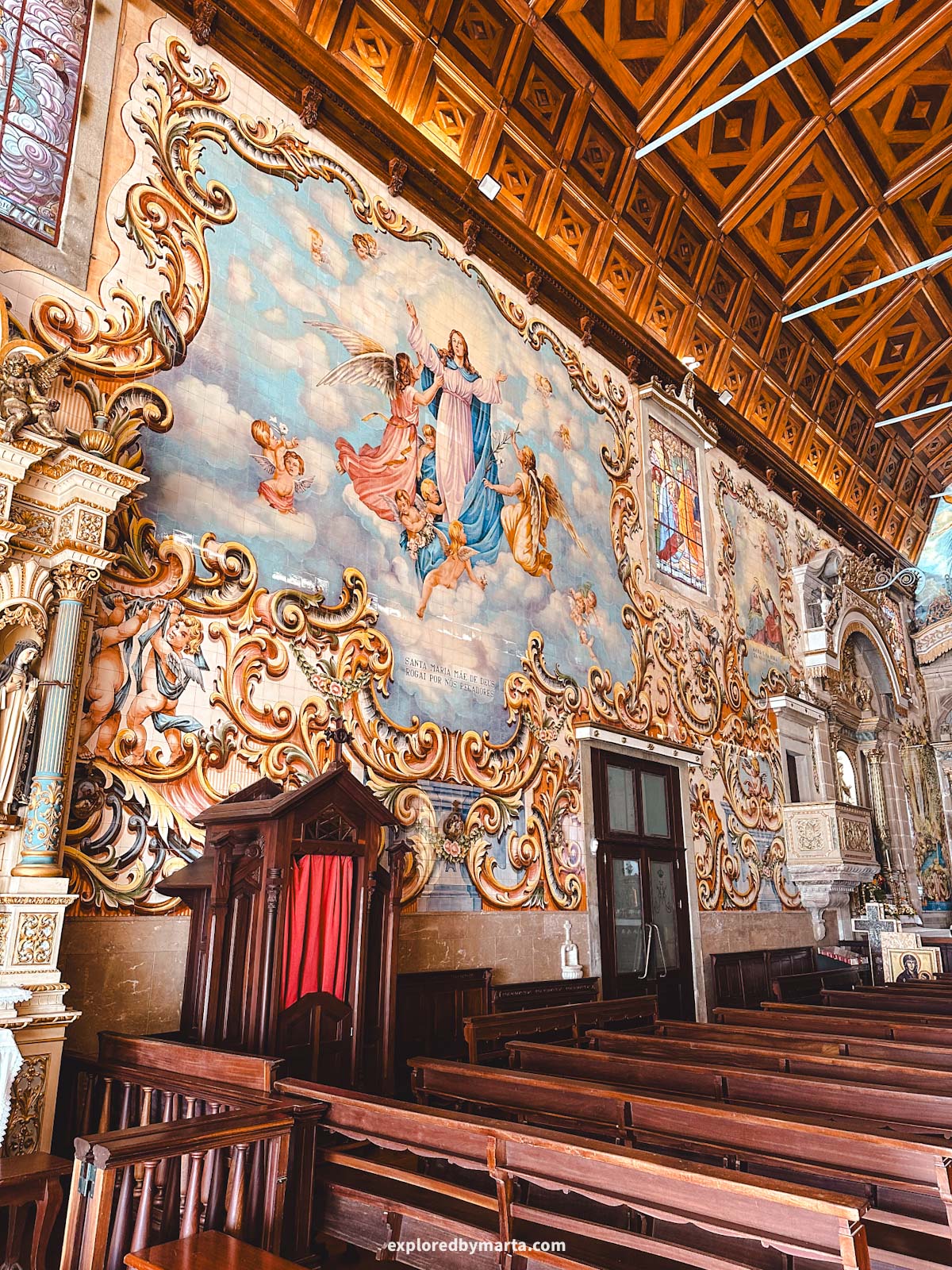
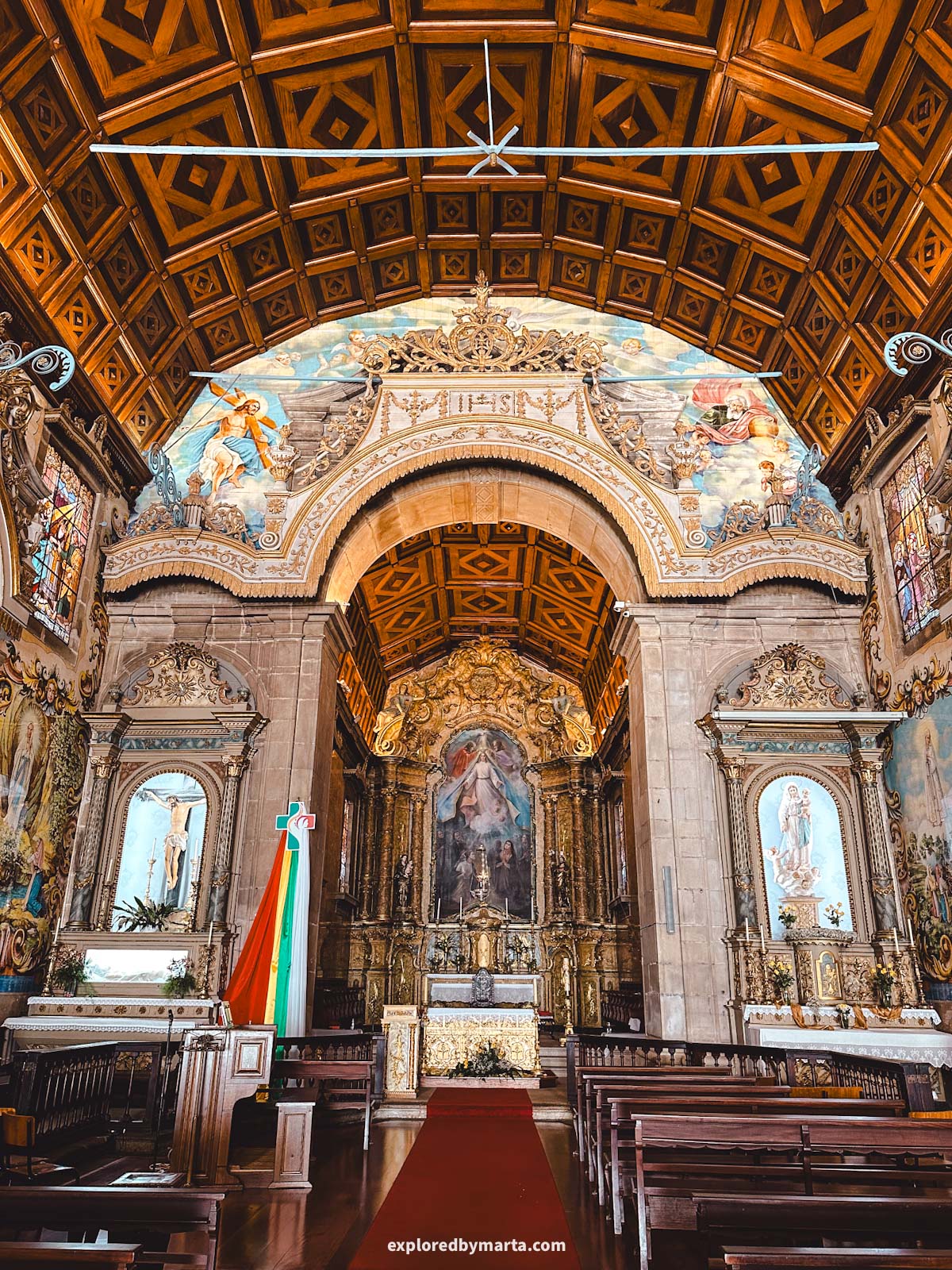
However, the colorful tiles were added back in the middle of the 20th century. They cover the whole church, but the colorful part is on the main facade as well as inside it.
The church is freely accessible, and you can even visit the interior during its working hours. But even seeing it from the outside is a whole experience!
The sides of the church are covered with typical blue and white tiles. There is also a small cemetery right next to the church. See if it is open; you can quietly observe some beautiful architecture there as well!
Location: Igreja Matriz de Válega
2. The Eye of Portugal: Covão dos Conchos spillway
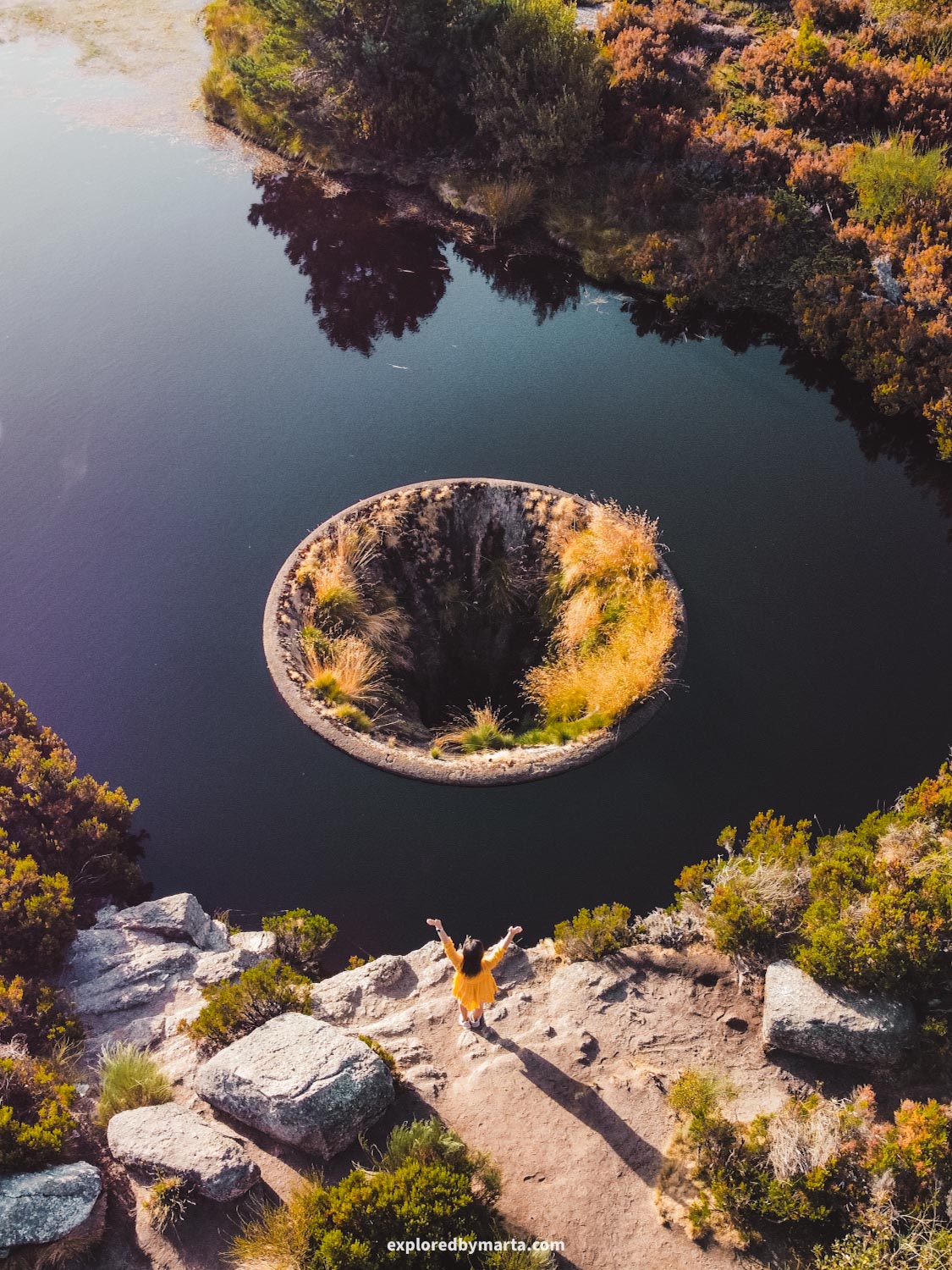
Deep in the Serra da Estrela mountains, just 10 kilometers from the highest point in continental Portugal, is one of the most unusual hidden gems in Portugal: the bell-mouth spillway in an artificial lake, Covão dos Conchos.
The spillway was built in 1955 as a way to divert water between two bodies of water and is part of the hydroelectric dam system of Serra da Estrela.
However, from the looks of it, the circle with the black hole looks like a mouth to the center of the Earth! For others, this looks like an eye, so they call it The Eye of Portugal!
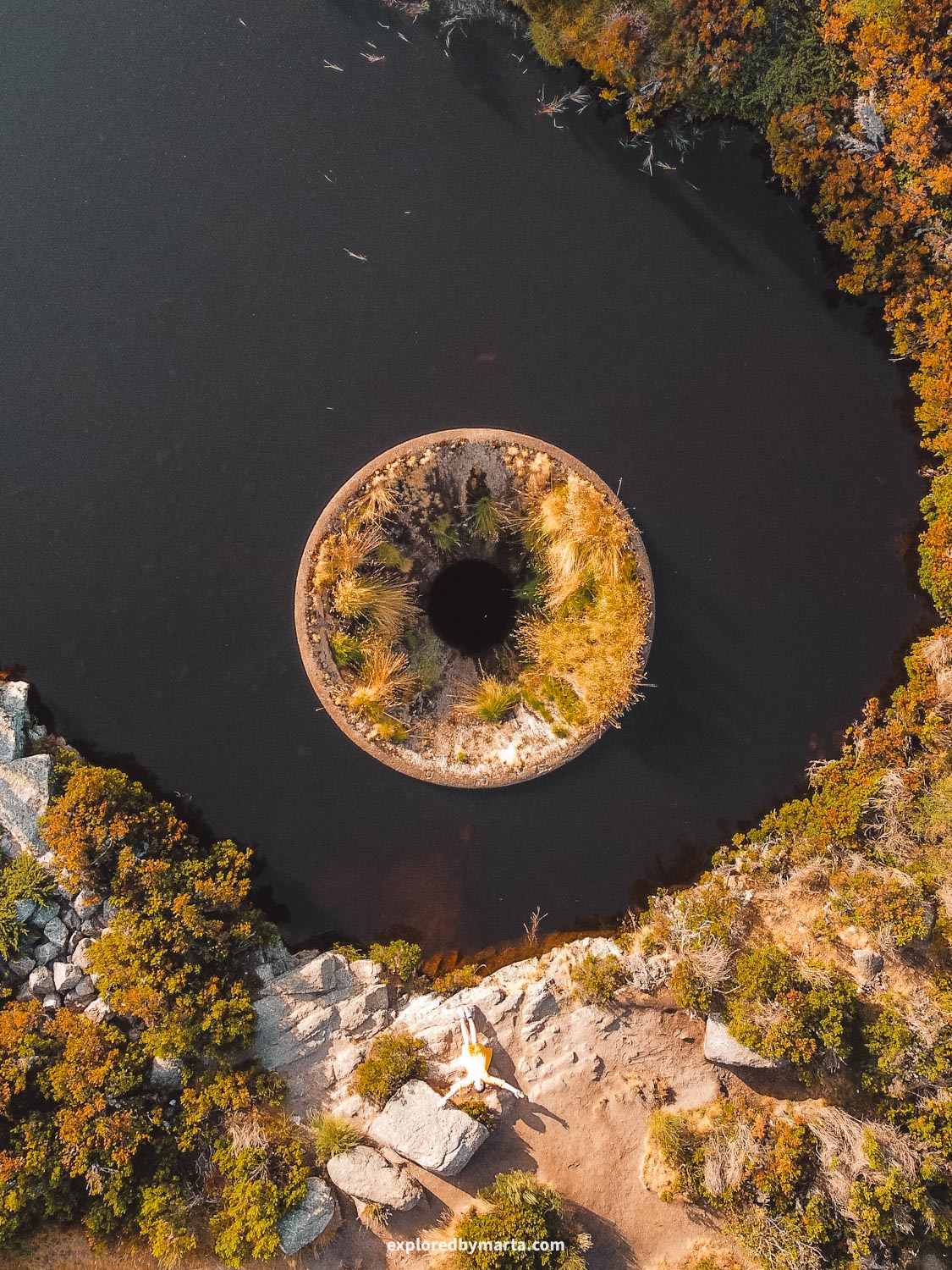
Visiting this spillway is not a quick adventure, but if you’re somewhere in the mountains, then you can consider taking a trip to this place.
To get there, you need a car. Then you have to park your car next to the water dam (location below) and then embark on a 4.5-kilometer hike to the spillway. That’s one way.
The hike is quite easy and goes along a dirt road. Because of large potholes and big stones, the road is not really drivable, so don’t attempt it. We did the round-trip hike in around 2 hours, but we ran a couple of kilometers, so prepare for a half-day adventure.
Location: Covão dos Conchos – Parking lot
3. Praia da Ursa, Portugal’s most breathtaking wild beach

Praia da Ursa or Ursa Beach is easily one of the most beautiful places I have visited in Portugal! With its golden-sand shores and astonishing rock formations, this wild beach completely mesmerized me when I finally got to see it.
The beach got its name thanks to the large sea stacks – one of them is named ‘Roca da Ursa’ or the ‘Rock of Bear’.
The beach is located near Cabo da Roca, one of the most iconic destinations in Portugal. It is the westernmost point of Portugal and Continental Europe, so tons of people visit this place every day, especially around sunset hours.
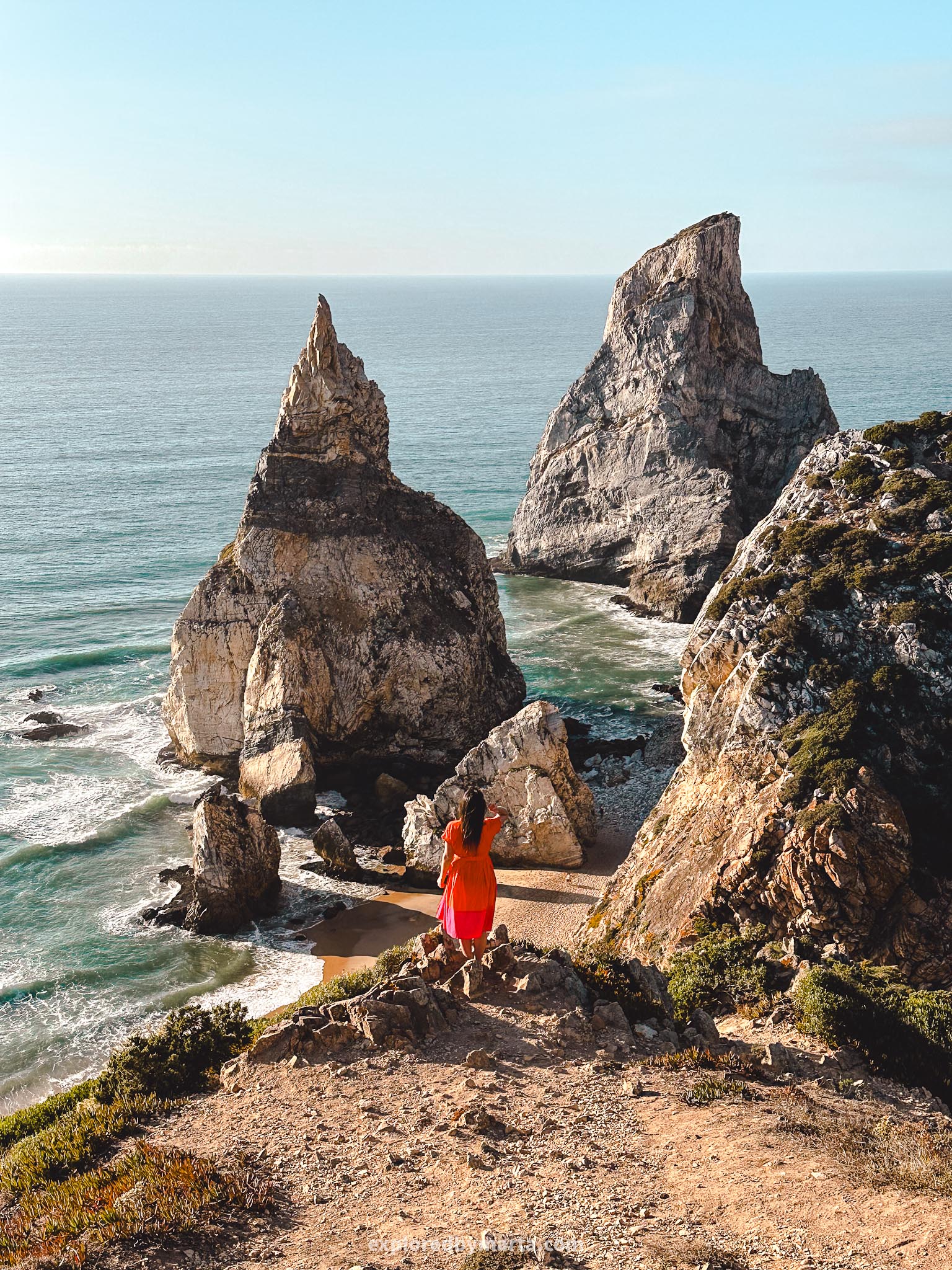
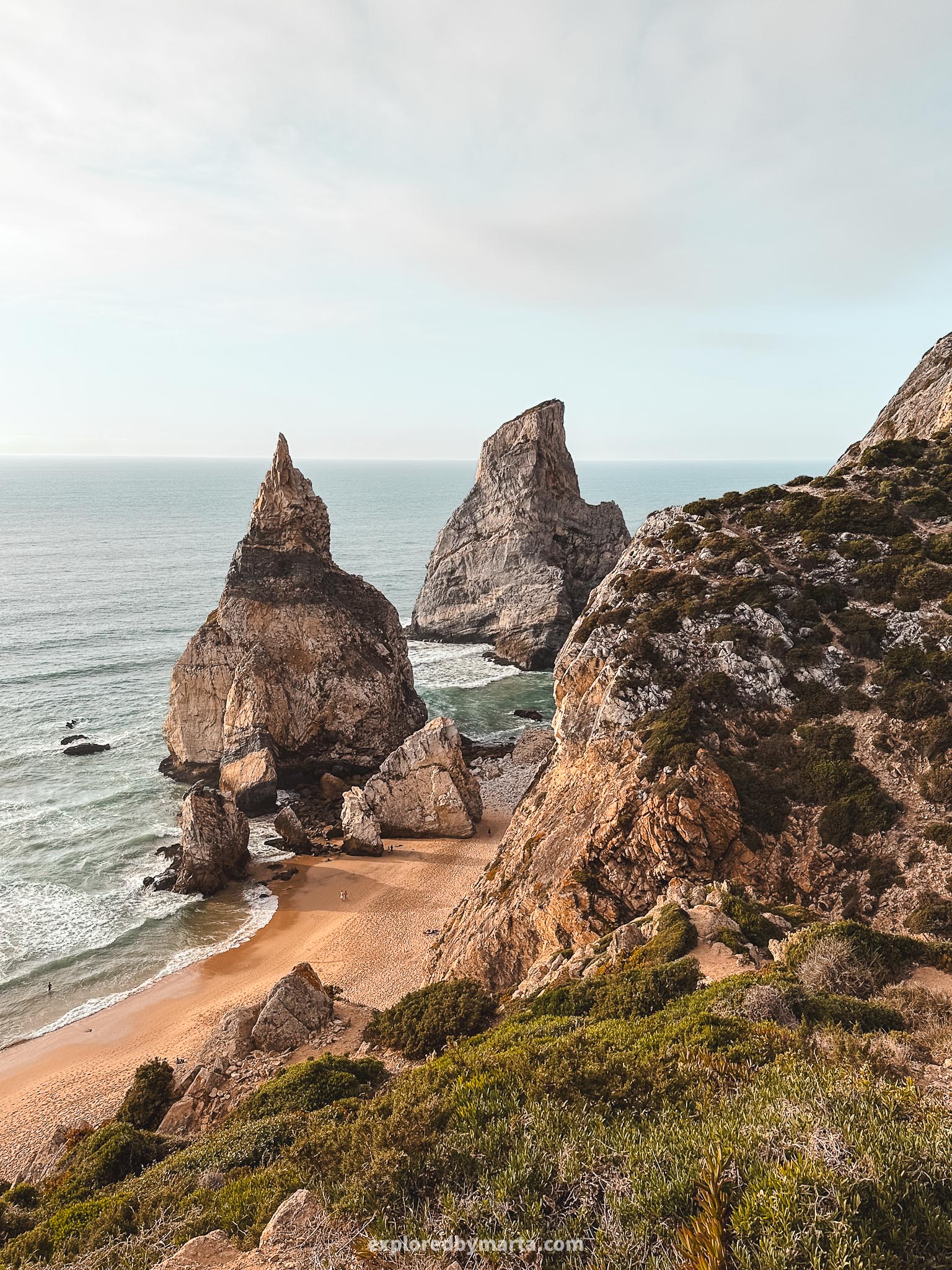
If you go to Cabo da Roca and have some time to spare, I highly recommend walking over to this beach. It is a 20-minute walk to the top of the cliff and will take an extra 10 minutes of steep descent if you want to go down to the water.
We decided to descend only halfway down to the beach, because that spot seems to have the best perspective of the massive rocks. I think the photos turned out great, don’t you think?
In case you are looking for a scenic place to visit a short distance from Lisbon (it is a 45-minute drive), then this is the perfect place to go. You can get there by car or by bus, which stops at Cabo da Roca lighthouse.
Location: Praia da Ursa
4. Piódão, one of the Historical Villages of Portugal
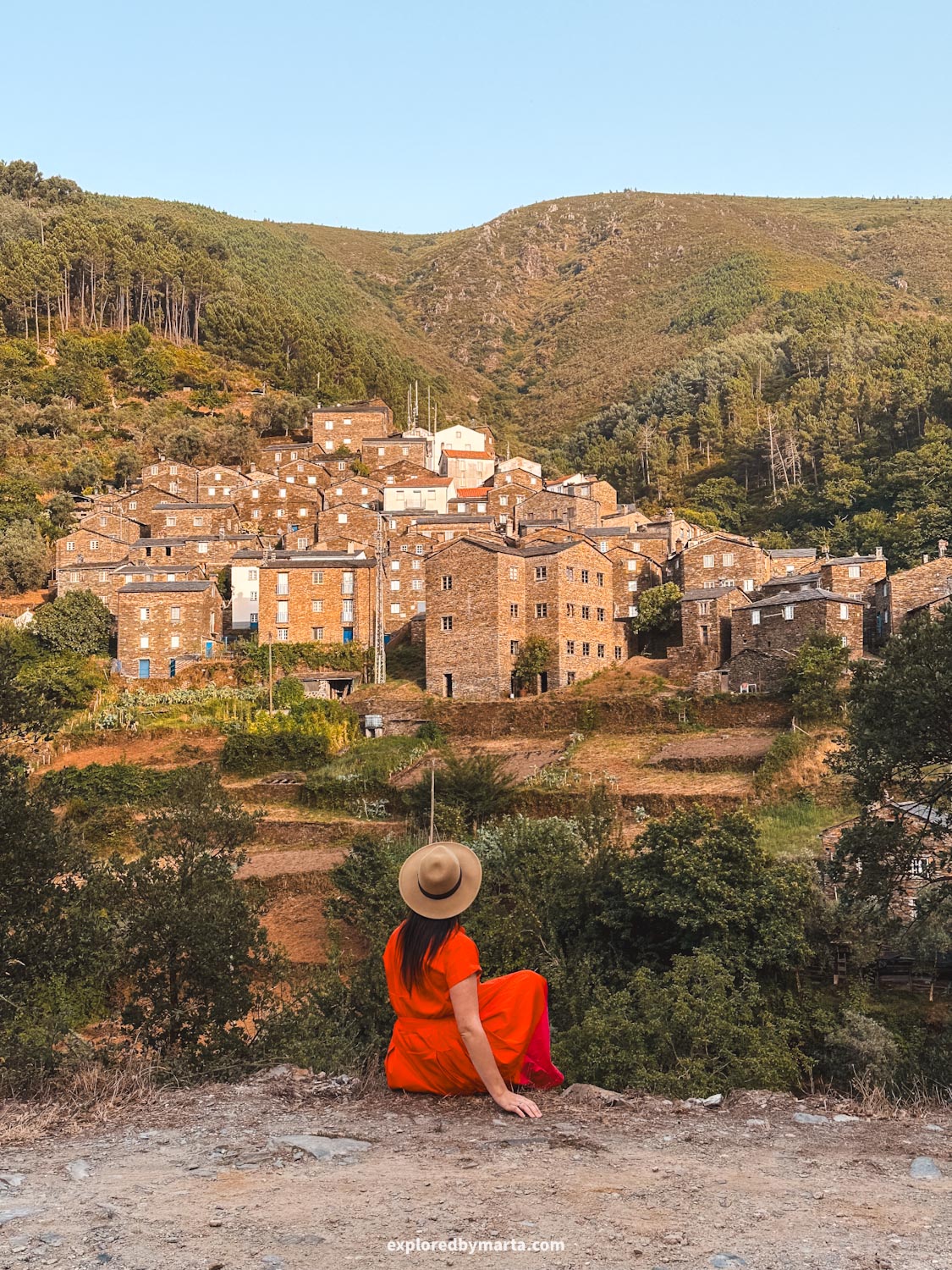
Piódão is a small village hidden in the Serra do Açor mountain range in central Portugal, and one of my favorite hidden gems we visited in Portugal.
Piodão, with its 120 permanent residents, is labeled as one of the historic villages in Portugal – unique ancient urban areas that were founded before the Portuguese nation itself. Needless to say, this village has experienced a lot over the centuries.
Piódão is also known as one of the schist villages in Portugal. Schist is a form of metamorphic rock typical of the Serra do Açor mountains. Every house, every wall, and every narrow street in this tiny village is made of small pieces of schist! So unique!
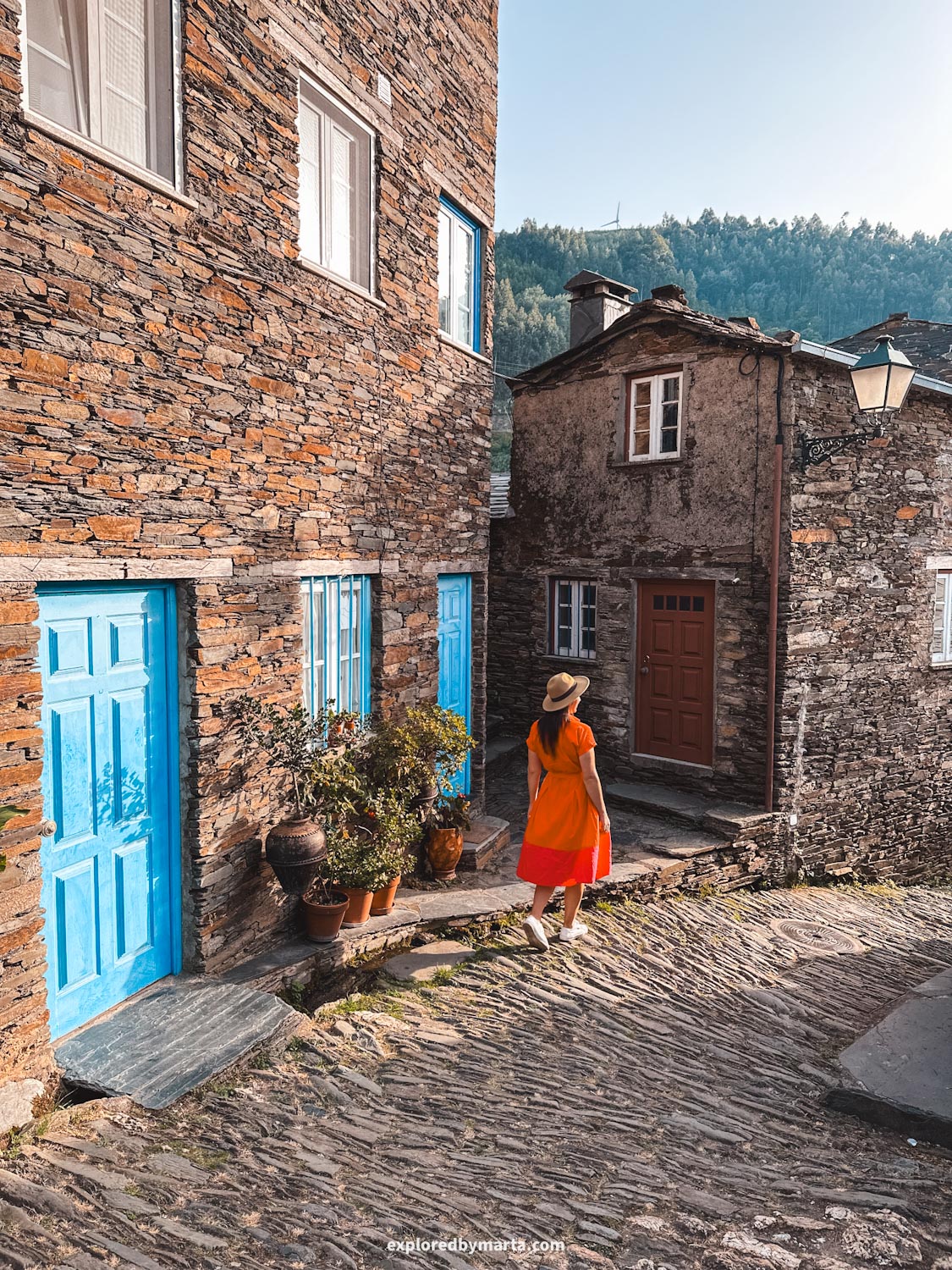
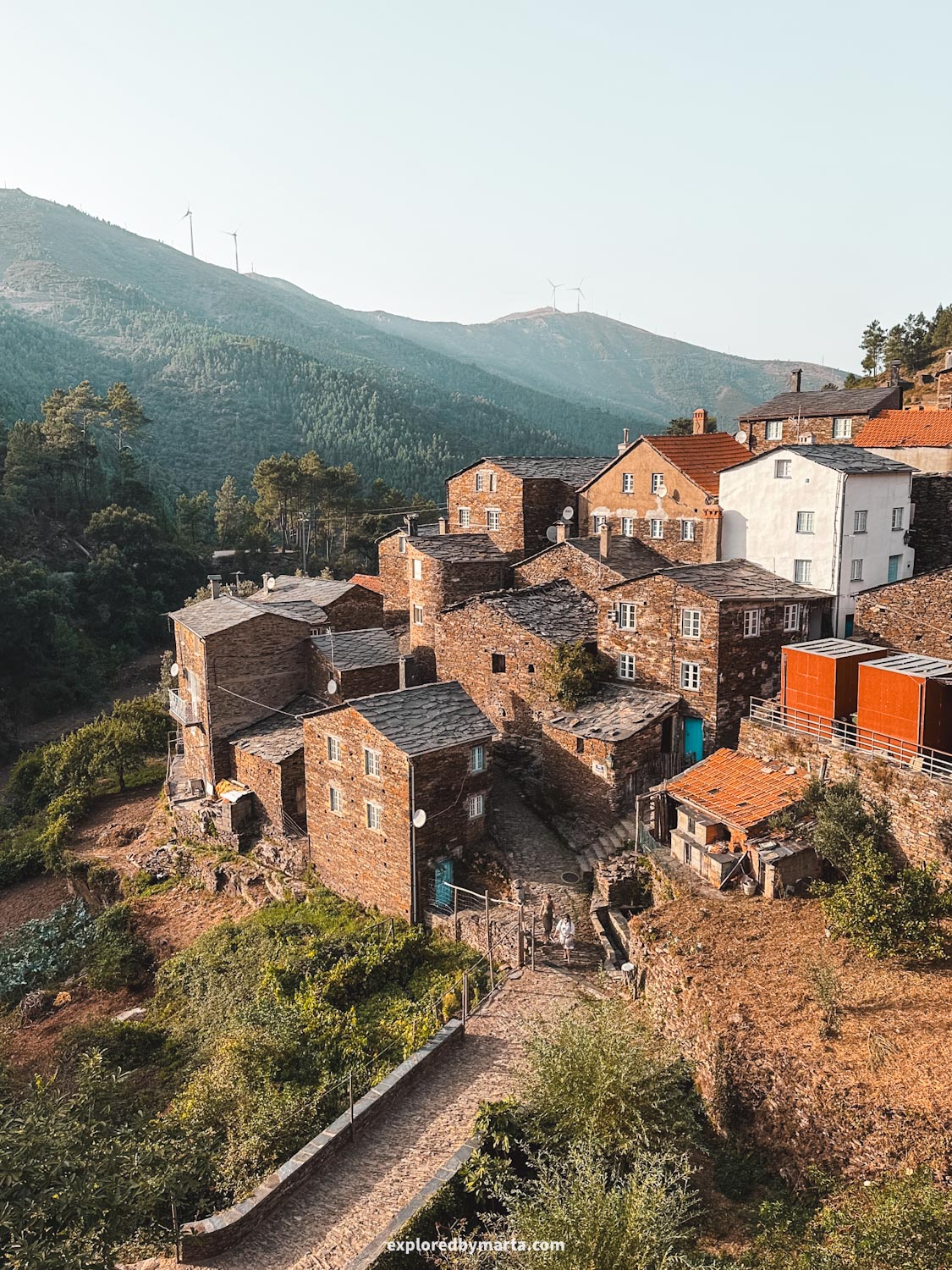
There are a couple of schist villages in Portugal in this area, but Piódão is probably the most famous one of all. Schist was used as it was a cheap option – the abundance of this material that was available for free was enough of a reason to use it everywhere!
And if you ever visit and explore the magical Piódão, you’ll understand what I’m talking about.
Piódão is very small and you only need an hour to see everything this place has to offer. It is perfect for nature lovers as its scenic access roads lead through the mountains. If you seek lost places and unique experiences, this is the place for you. We loved this place!
Location: Historical Village of Piódão
5. Fort of São João Baptista in Berlengas Islands
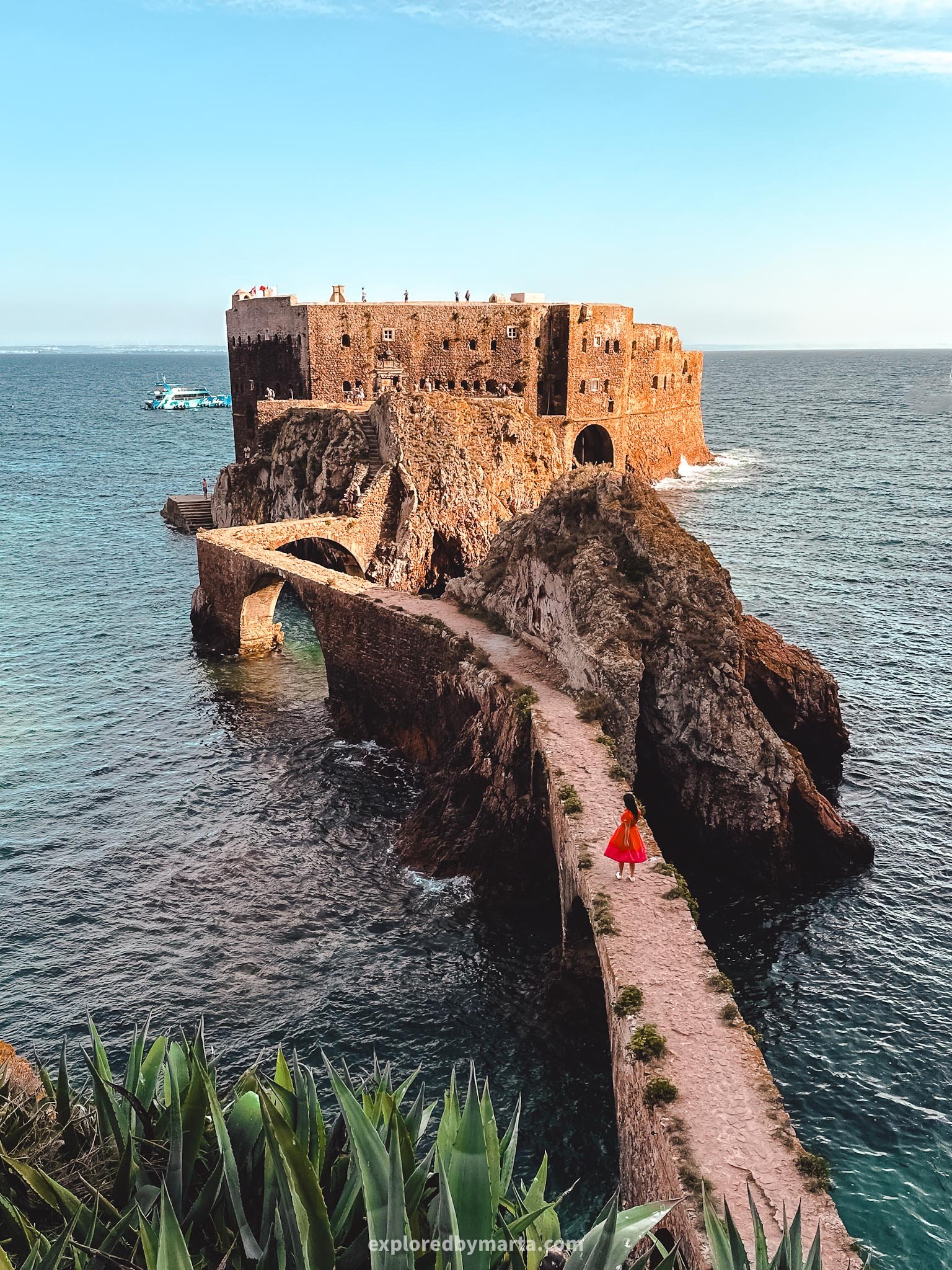
One of the bucket list things to do in Portugal is to take a boat trip to the Berlengas Islands. It is a small archipelago just off the coast of Portugal near Peniche, a seaside town just a 1h 15min drive away from Lisbon.
The Berlengas Islands are known for crystal clear waters, so people come here to enjoy the beaches as well as cliff jumping. But the most iconic tourist attraction on the Berlengas Islands is the Fort of São João Baptista.
This fort is a military defensive structure. The octagon-shaped fort was built from the remains of an old monastery that was abandoned due to regular pirate attacks. It was constructed during the 17th century.

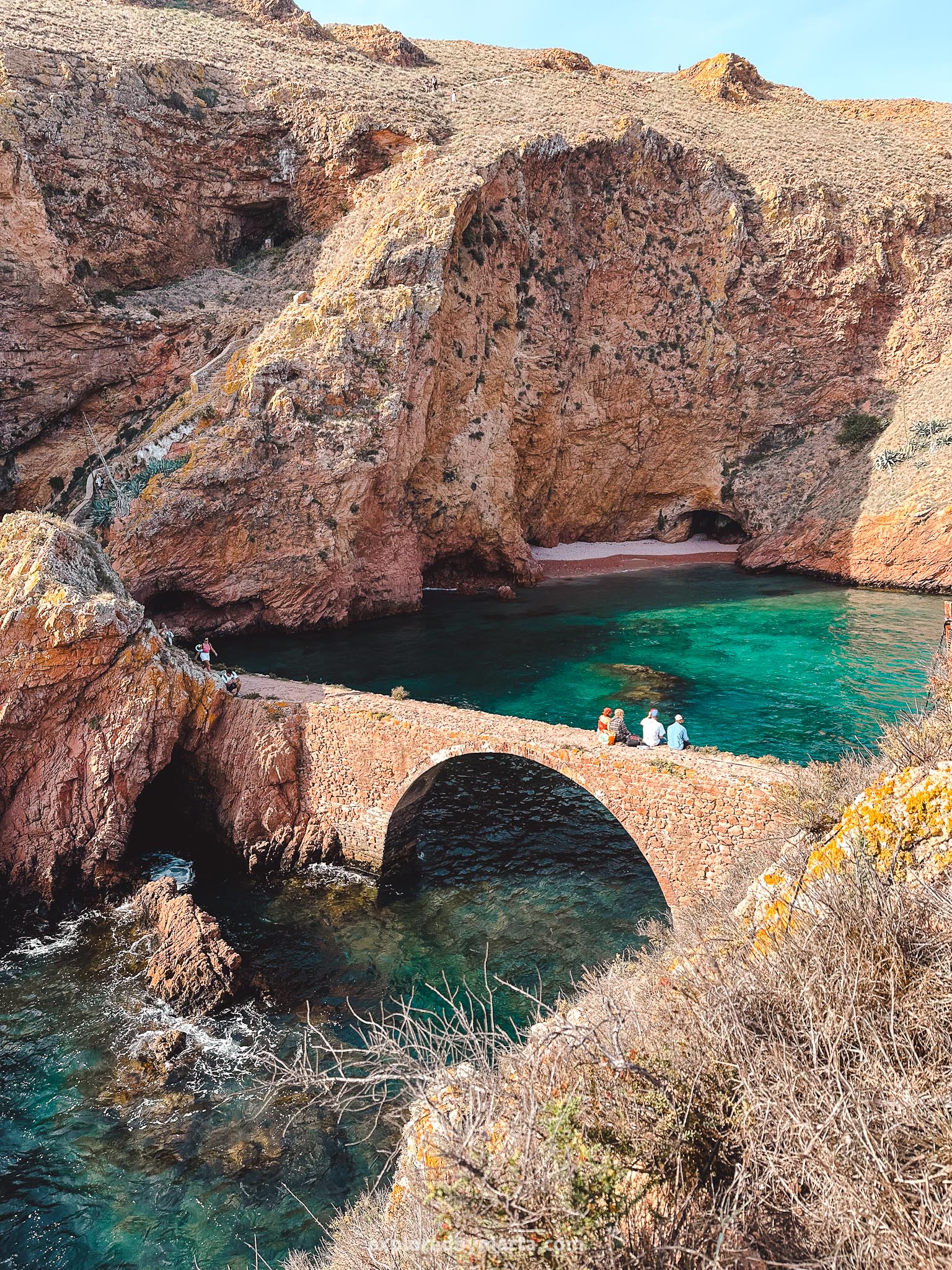
Today, it is no longer functional, and you can explore the fort for a symbolic entrance fee. You can get there by one of the regular ferries from Peniche. It takes you to the island, then you have about 3 hours to explore, and then it will take you back to Peniche.
Before the trip, you have to register on berlengaspass.icnf.pt and obtain a Berlengas Pass by paying a tourist tax for visiting the archipelago. It costs 3 EUR per person, but you must do it before your trip.
On the day of your trip, you have to drive to the port of Peniche. They have a paid parking lot right next to the ferry that goes to the Berlengas Islands. You have to arrive about 30 minutes before departure.
Bring some snacks, drinks, comfortable shoes, and sunscreen. There is very little shade on the island. Some of the paths are not paved. The fort is located 1 kilometer from the port, so it will be a bit of a hike with some vertical meters to get there. Worth it!
Location: Forte de São João Baptista
6. Heart-shaped rock at Praia da Marinha
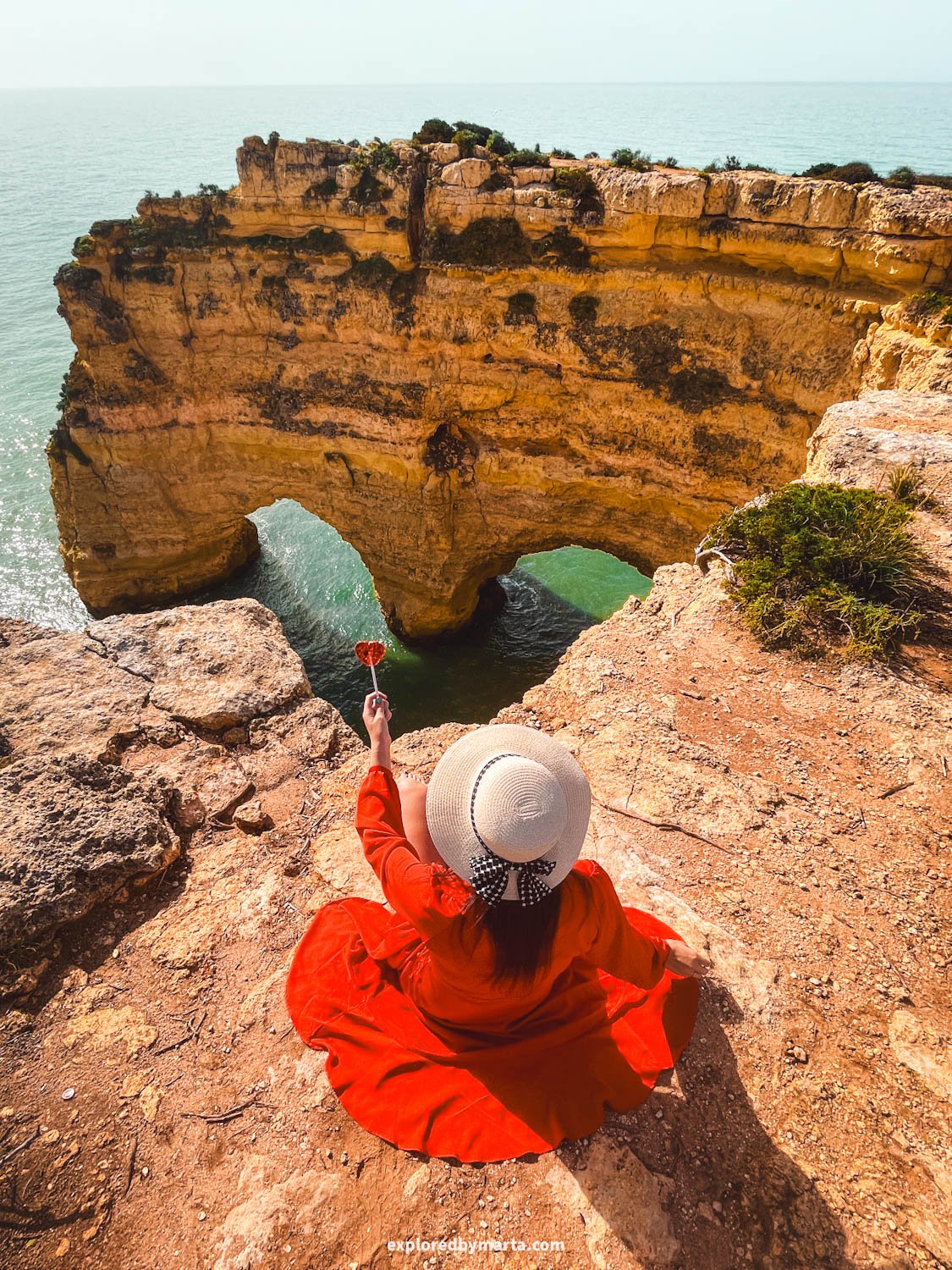
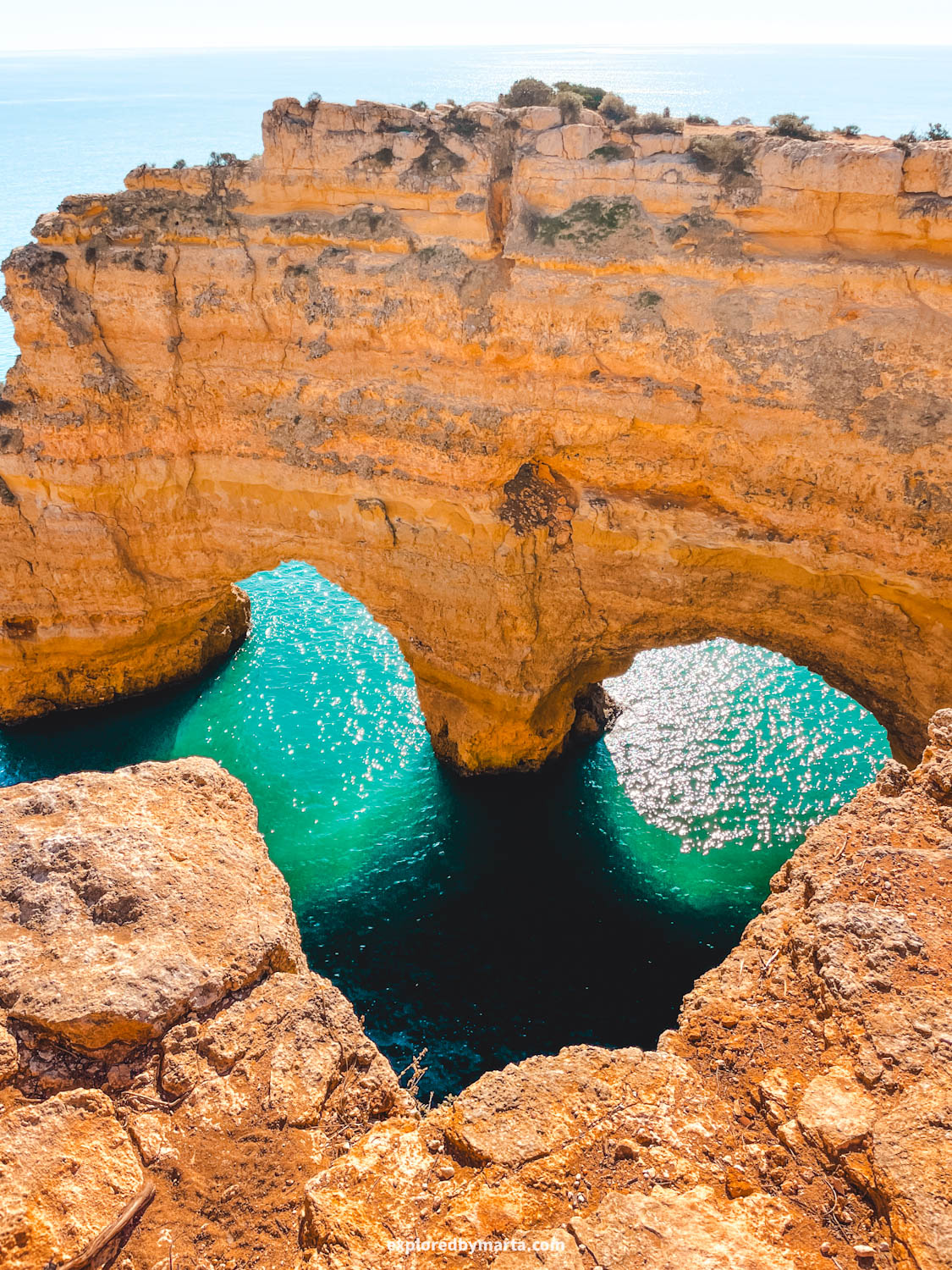
Another one of the hidden spots you can find along Portugal’s coastline is the heart-shaped rock in the Algarve, Portugal’s southern region. We loved finding hidden spots along the Algarve’s coastline, and this was one of my favorite spots there!
You have probably seen this kind of photo on social media, right? But did you know that the heart-shaped rock is actually not a single piece of rock that has a hole in the shape of a heart? Well, you can probably tell it from the photos, haha!
In reality, there is a coastal cliff with two arches that forms the upper part of the heart, and then you combine it with a narrow gap on a different coastal cliff that forms the bottom part of the heart. In a specific place at a specific angle, these two different cliffs form the shape of a heart!
It is an unusual sight for sure, so if you ever visit one of Portugal’s most beautiful beaches, Praia da Marinha, take a walk along the coastal cliff, and try to find this hidden marvel! But be careful around the cliffs!
Location: Heart-shaped rock
7. Azenhas do Mar
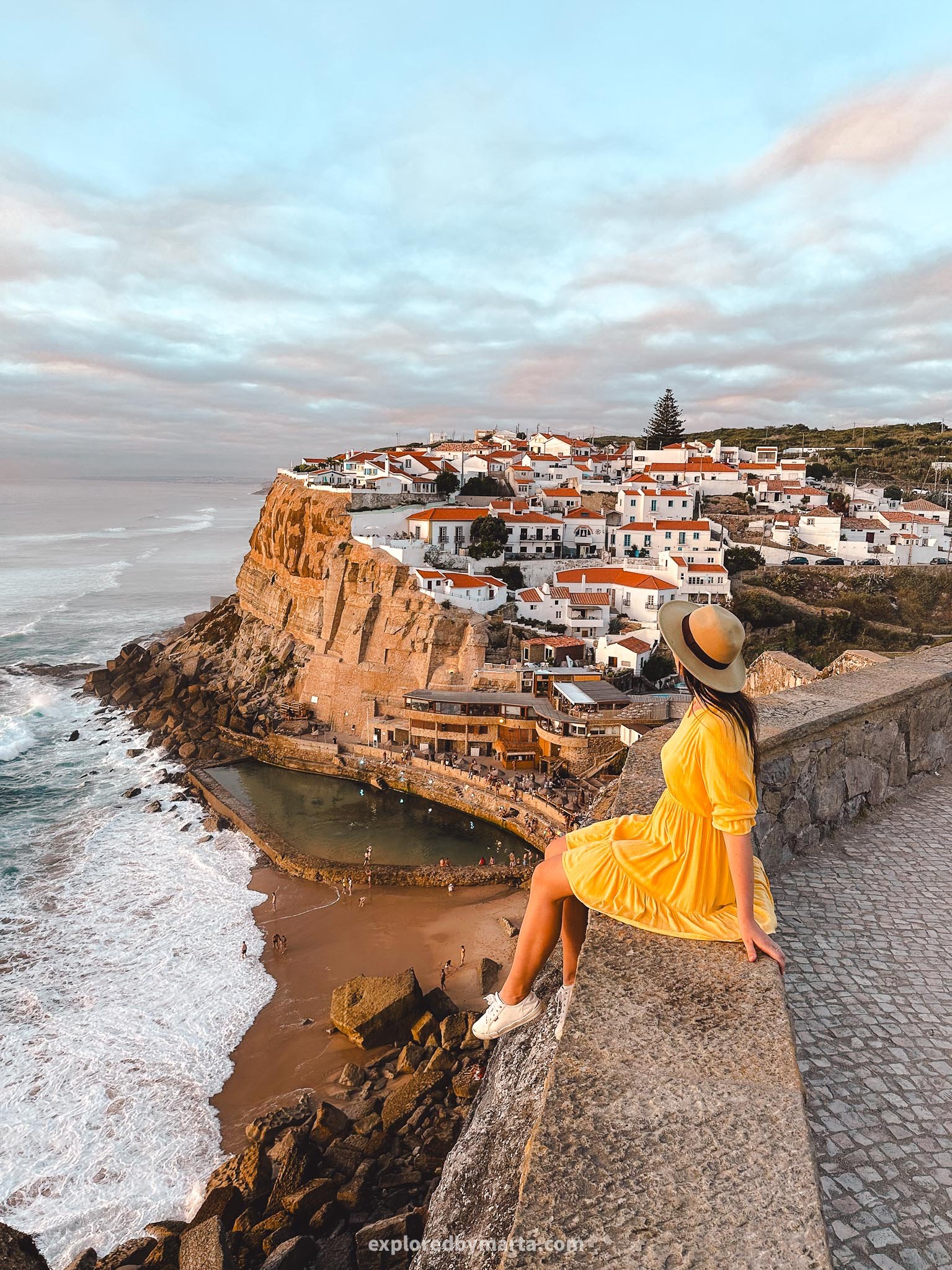
This iconic view of Azenhas do Mar, one of the most beautiful towns in Portugal, is an unforgettable place you have to experience and see with your own eyes! The town is located just a 40-minute drive from Lisbon.
The name of Azenhas do Mar translates from Portuguese as ‘Watermills of the Sea’. The magical town is the perfect place for watching the sunset, which is exactly what we did when we visited this place.
The town that originated as a fishing village has now grown into a seaside resort featuring Mediterranean-style whitewashed houses with terracotta roofs.
It is now famous for its picturesque landscape with houses sitting on the majestic seaside cliff and a rock pool down by the beach, where people enjoy swimming while avoiding the crashing ocean waves at the same time. I absolutely loved this place!
We stopped by Miradouro das Azenhas do Mar viewpoint on a seaside cliff to see the breathtaking views and wait for the sun to set (location below). We had the best view of the town, the beach, and the Atlantic Ocean. If you’re looking for a scenic sunset spot, look no further!
Location: Miradouro das Azenhas do Mar – Parking lot
8. Castelo de Leiria
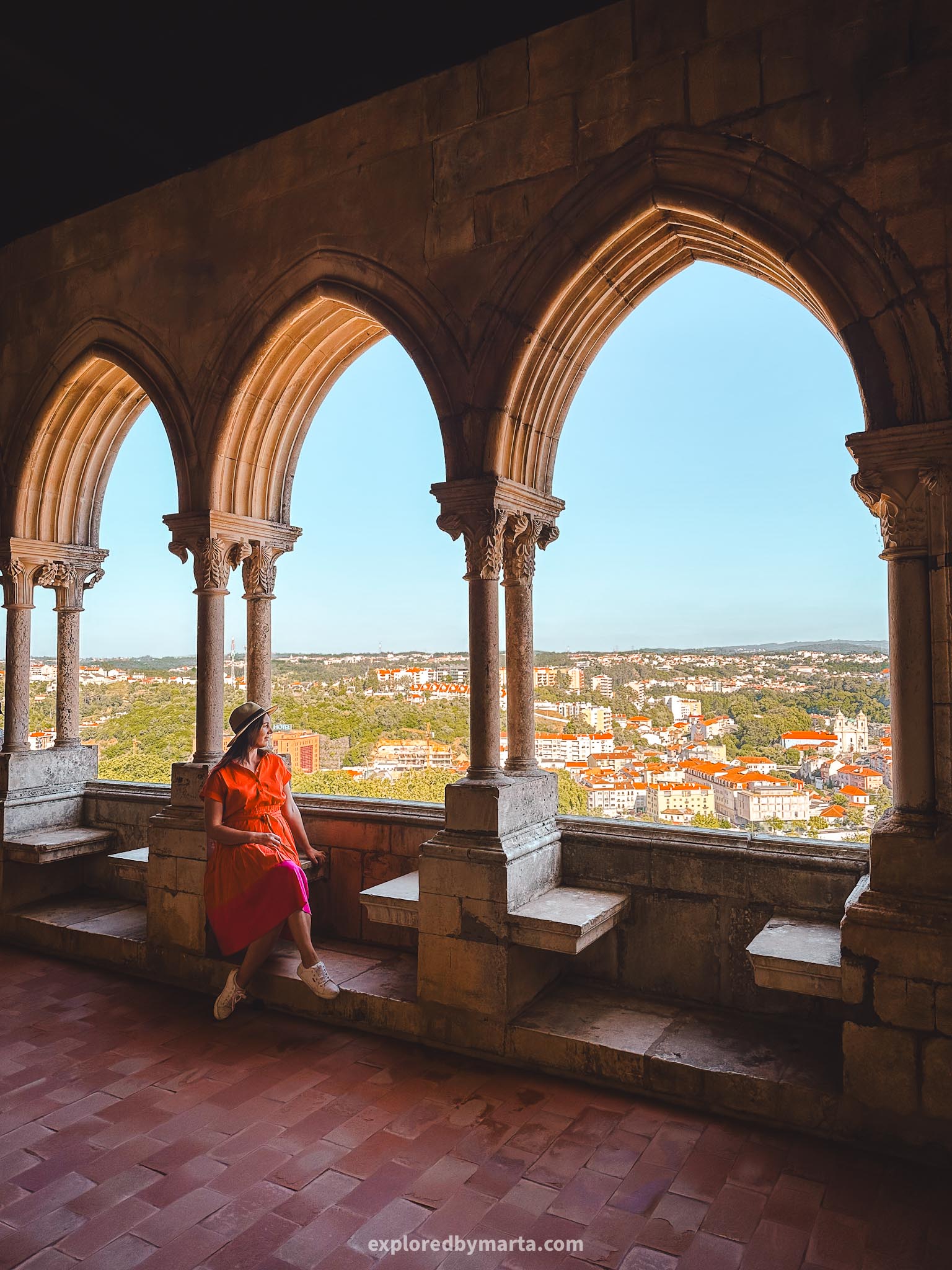
Leiria Castle is a beautiful and picturesque medieval castle built in the 12th century by the order of King Afonso I, the first king of Portugal, to protect, at that time, the Southern border of his country.
It is also, in my opinion, the most beautiful of all the medieval castles in Portugal.
I will never understand how other medieval castles like Guimarães Castle and Óbidos Castle get so much recognition, but this marvelous castle doesn’t get nearly the attention it deserves.
Throughout the centuries, it has served as the residence for Portuguese monarchs and played a strategic role in the defense of the country.
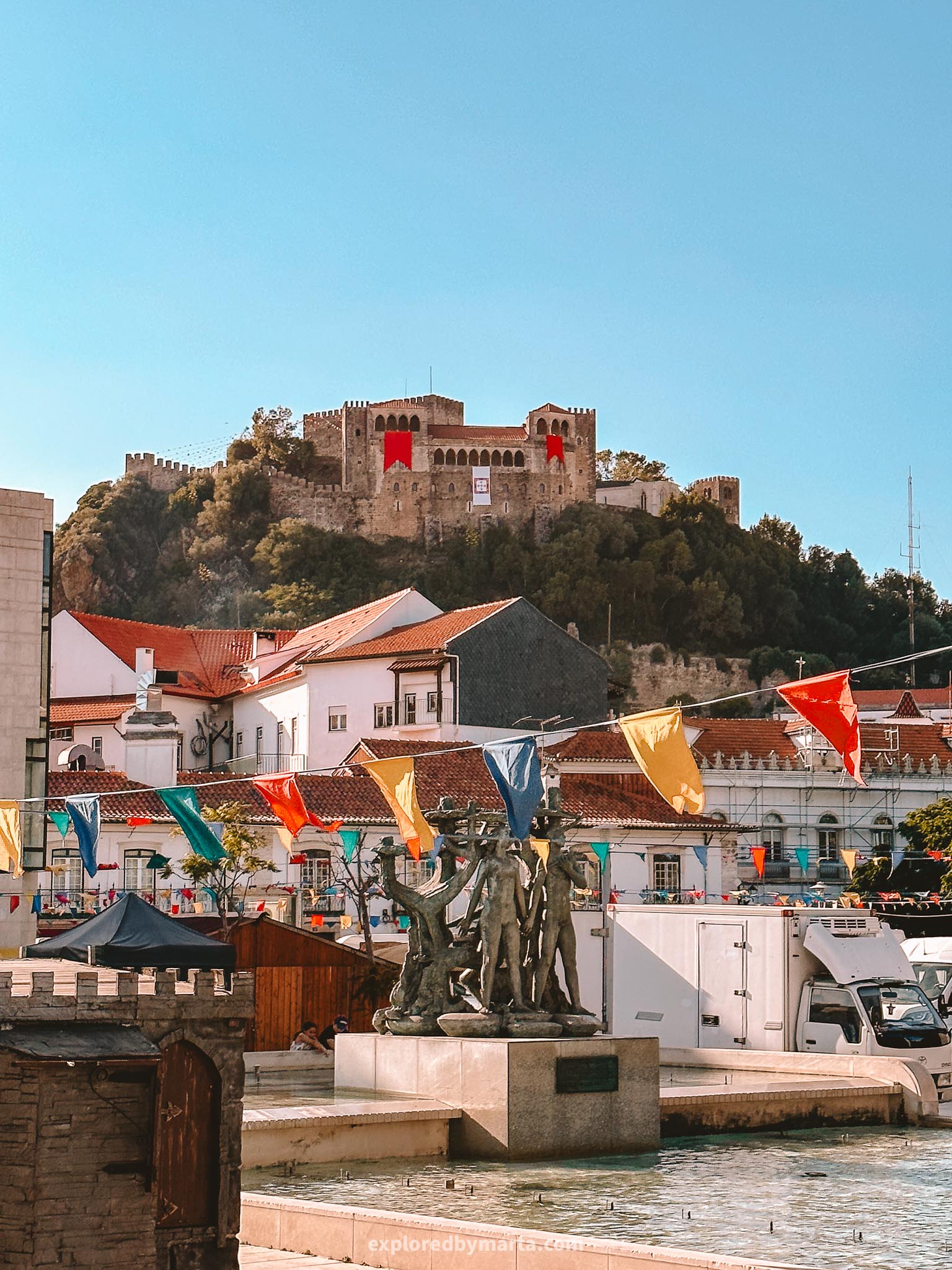
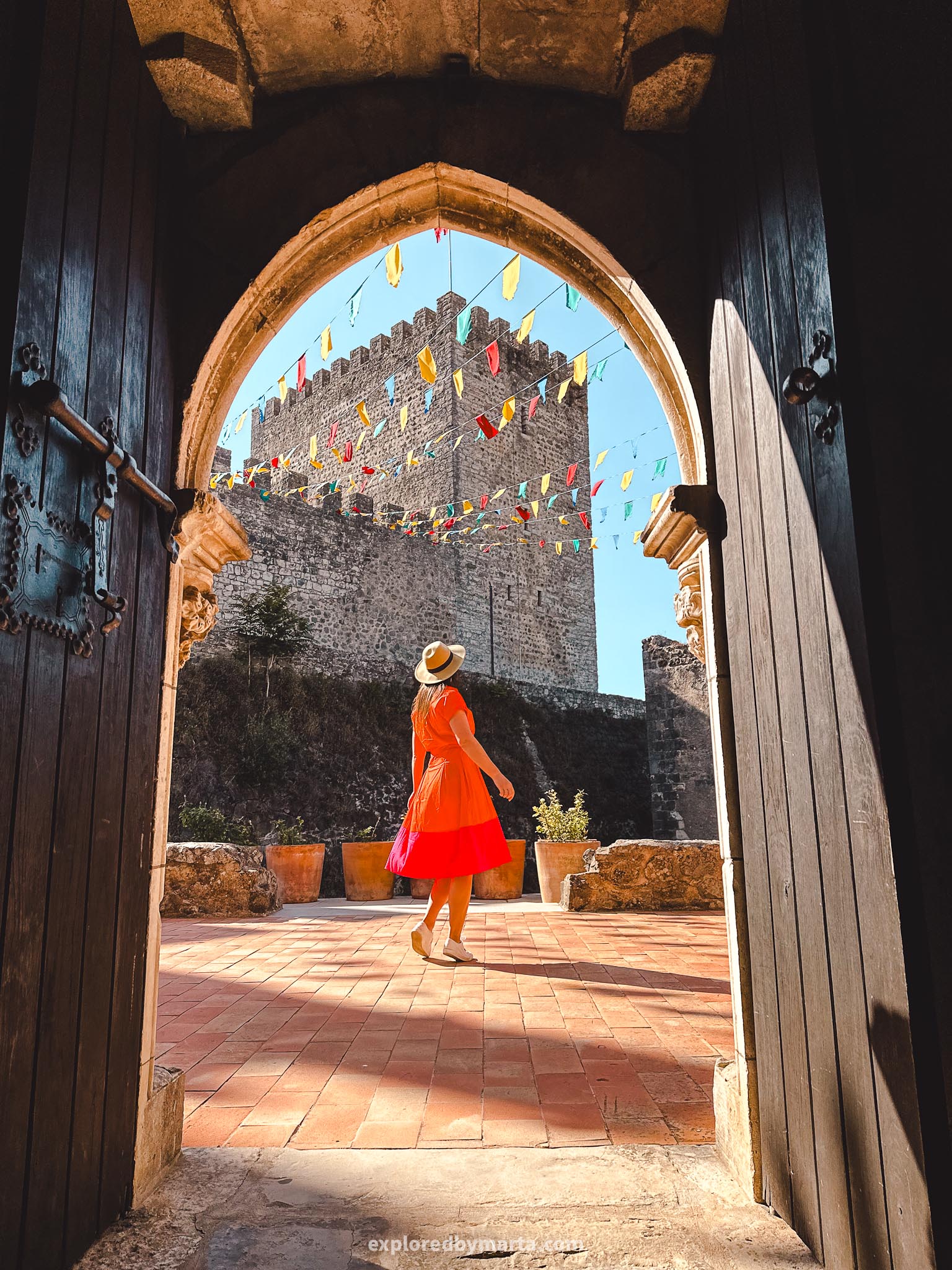
The Castle of Leiria is located in Leiria city, a 1h 30min drive from Lisbon, making it a perfect day trip destination from the Portuguese capital.
Each year, Leiria hosts a Leiria Medieval Fair – a big medieval festival where the whole city is turned into a medieval-themed playground. One of the best places to be for history lovers!
If you happen to be around during those days, I highly recommend paying a visit to Leiria and the castle, as everything will be beautifully decorated and there will be medieval celebrations throughout the city.
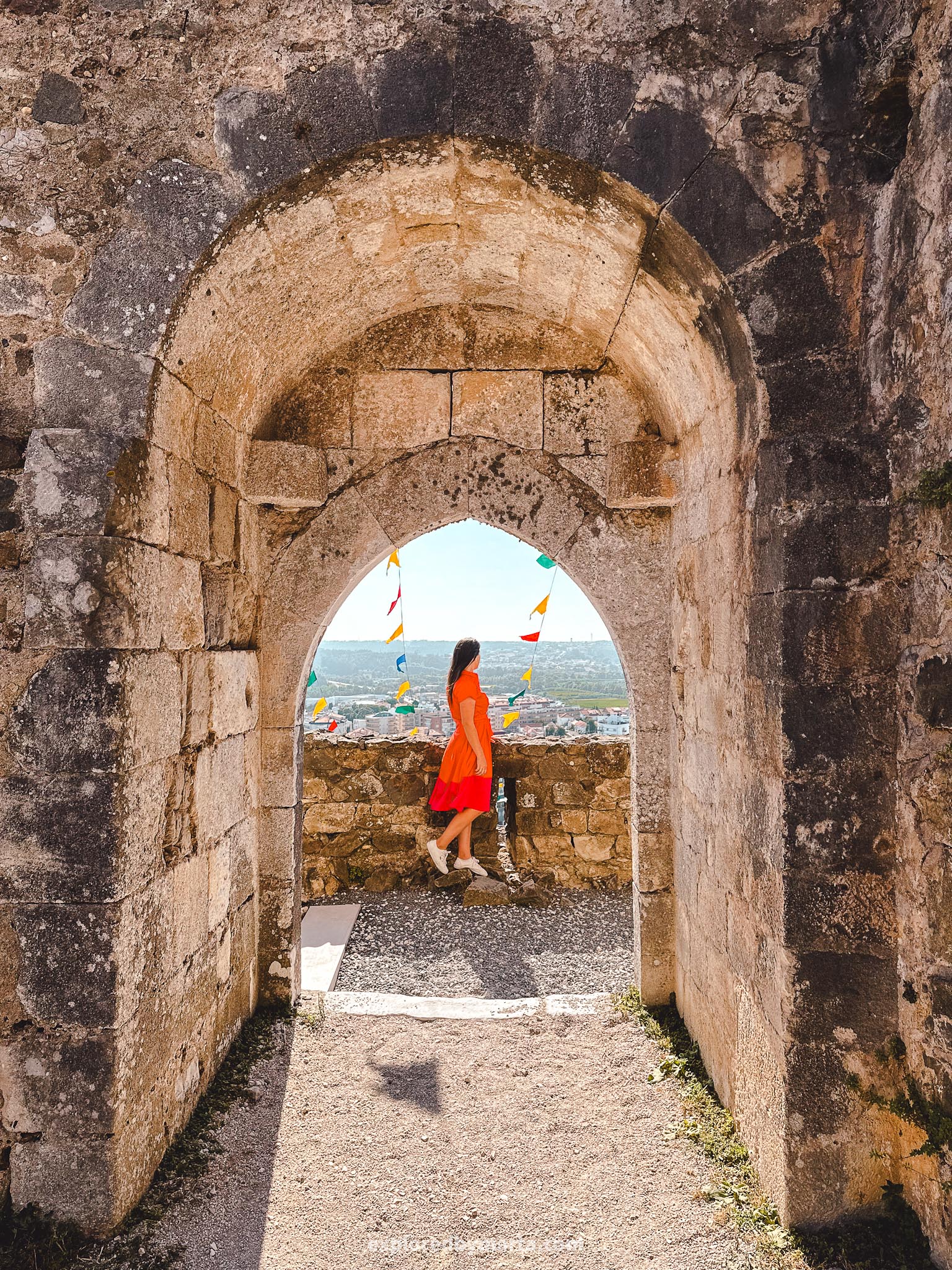

We happened to be there a day before the festival started, so we saw different performances, everything in festive colors, and a city full of medieval markets and street food stands.
Sadly, we could not stay longer, but it definitely looked quite fun.
However, we did explore the castle! It is really well maintained, and you can walk around the walls, explore the halls and towers, and admire the panoramic views over the city below.
There is a small entrance fee, but it is so worth it! My favorite place was the balcony room with the beautiful arcade and with the views of Leiria city. So picturesque! It really felt like stepping back in time.
Location: Castelo de Leiria
9. Sanctuary of Our Lady of Remedies in Lamego

Santuário de Nossa Senhora dos Remédios, or Sanctuary of Our Lady of Remedies, located in Lamego town in Northern Portugal, was one of my favorite hidden gems we found in Portugal.
The sanctuary sits on top of Santo Estêvão Hill and was built between the 18th and 20th centuries.
It can be accessed from the town by a long Baroque staircase of 686 steps, but you can drive up there by car as well. It is one of the best churches you can visit in Portugal!
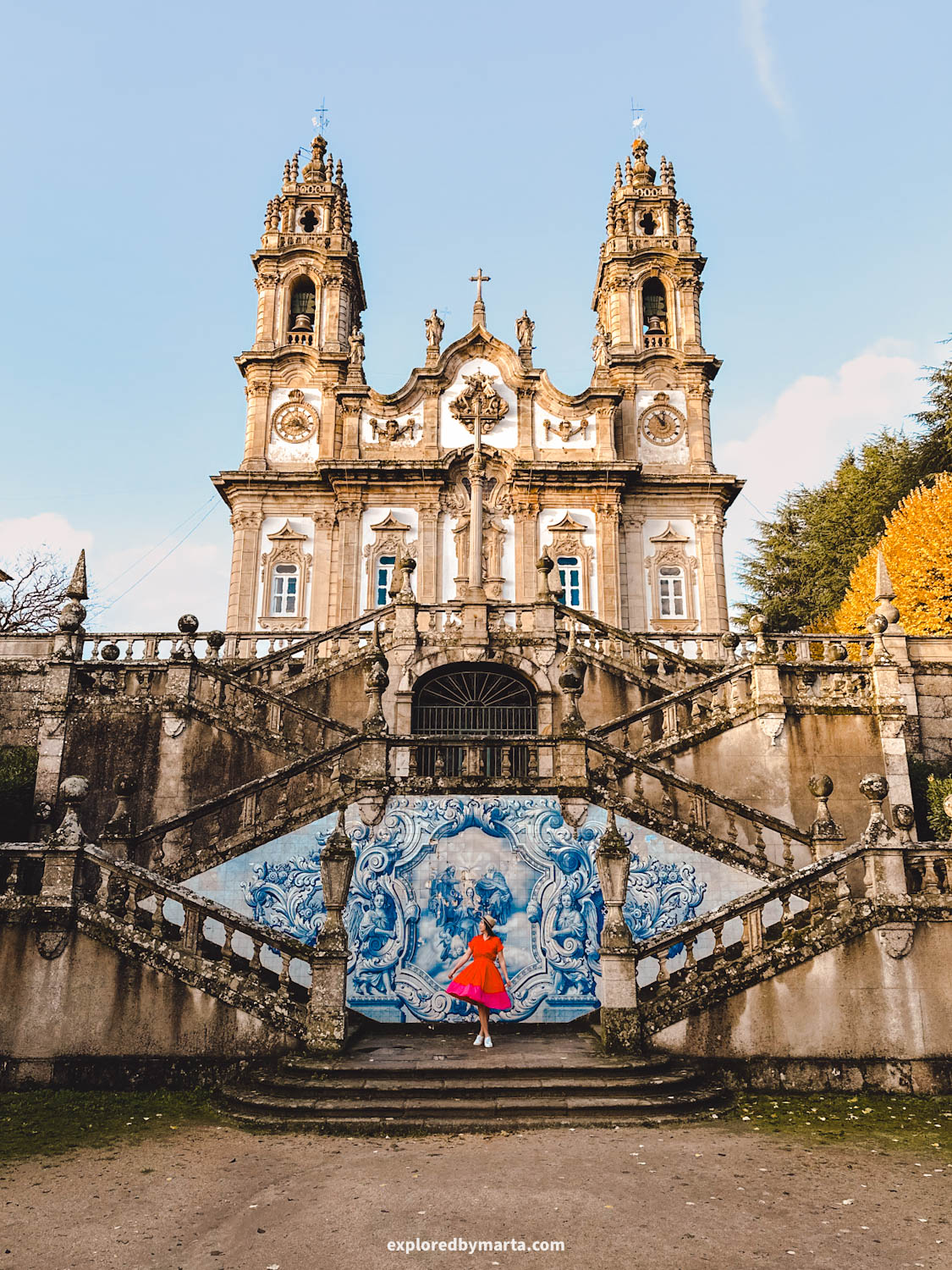
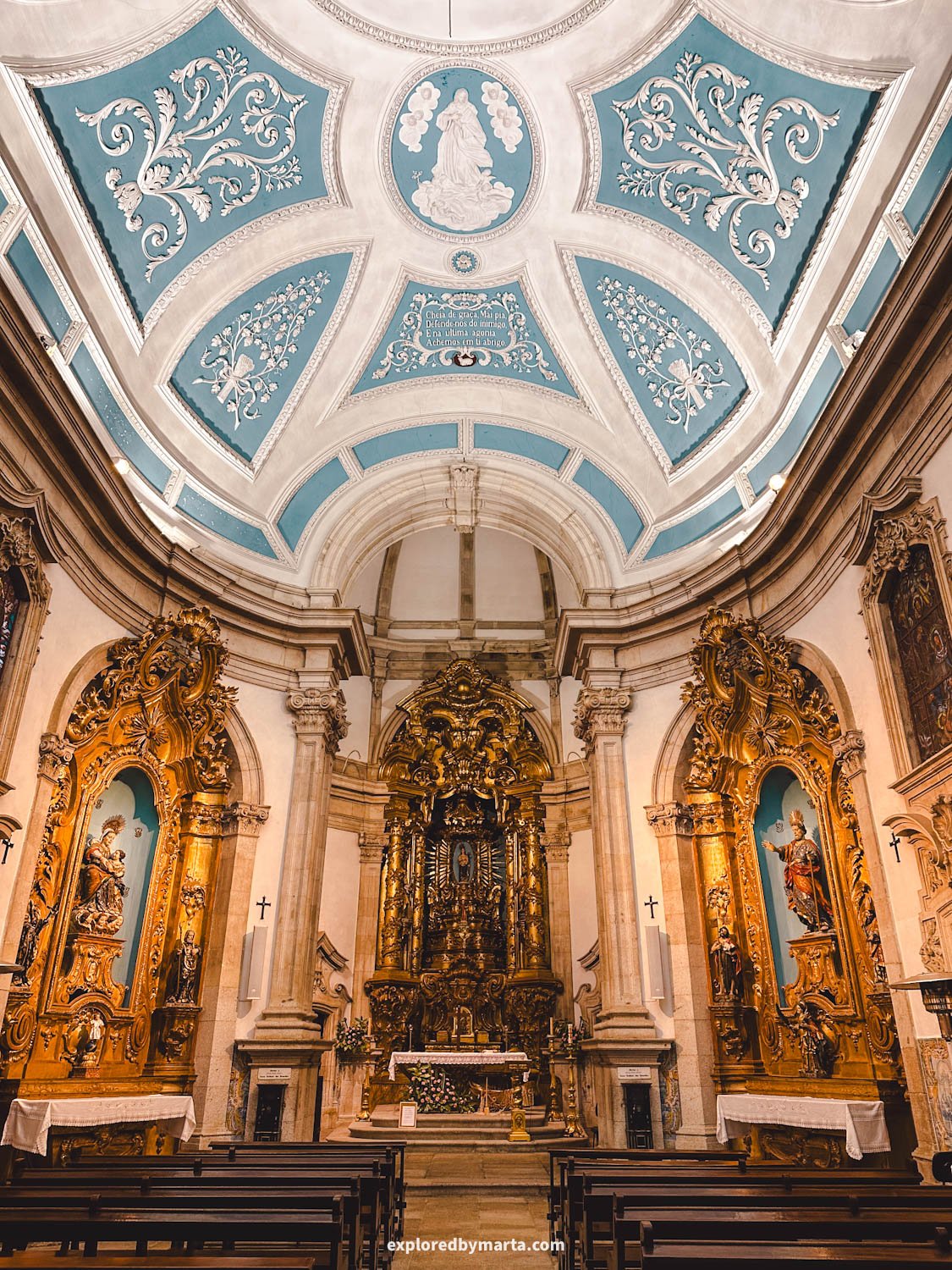
If you are able, I highly recommend climbing the stairs. To me, it was the best part of the experience. We climbed all the way up there, explored the sanctuary, and then climbed back down.
Building sanctuaries on top of hills and then adding majestic, long staircases up to them is not uncommon in Portugal. We found a couple of similar spots around Portugal.
But this iconic staircase in Lamego with statues and azulejos tiles was my favorite of them all!
Location: Santuário de Nossa Senhora dos Remédios
10. Palace Hotel of Buçaco
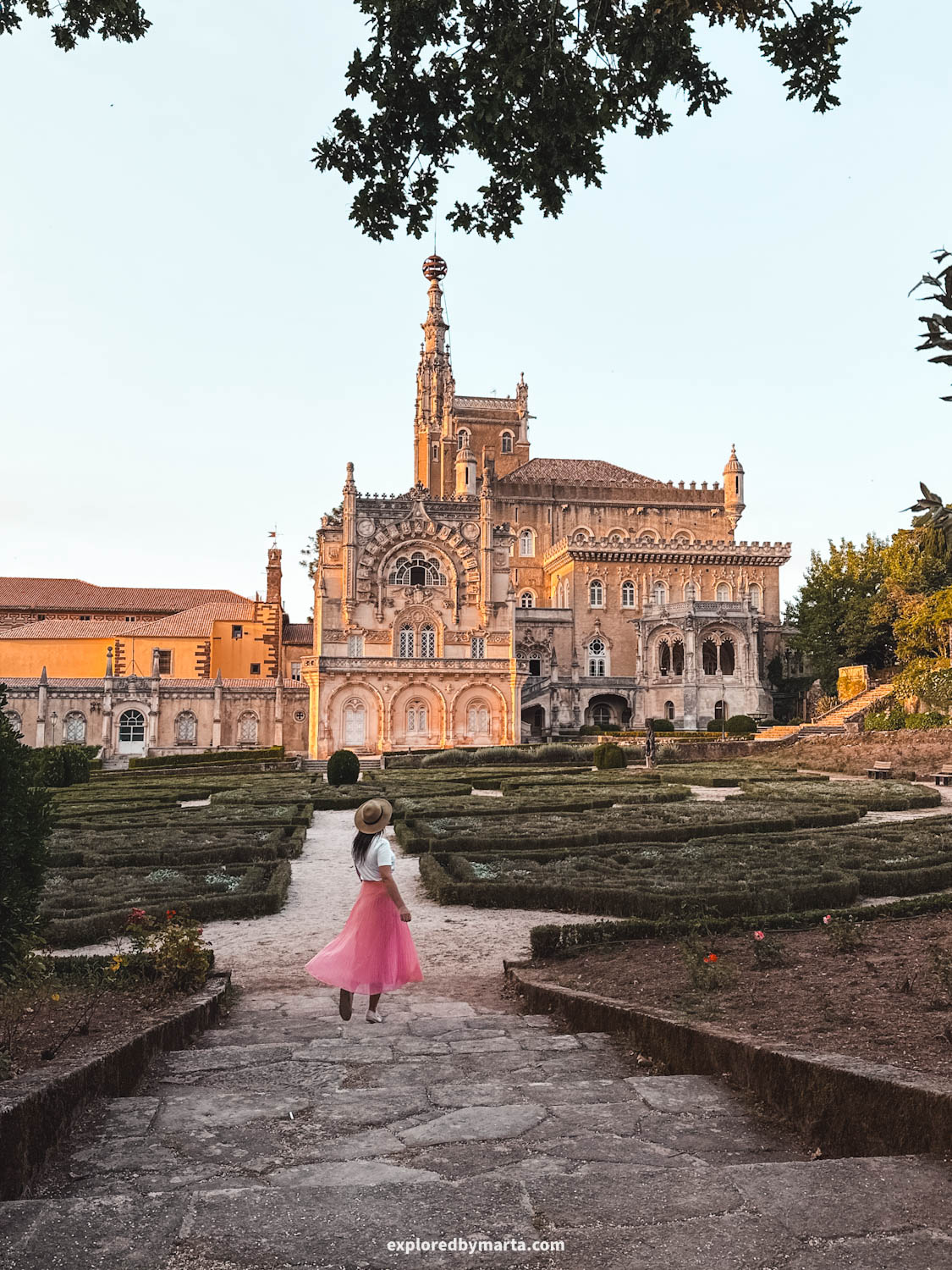
Now here’s a hidden gem that is actually hidden!
Located in an old, lush forest, the Buçaco National Forest, is a wonderful gem – the Buçaco Palace. While it looks like a palace, it actually is a former convent, and today it houses a luxury hotel.
However, in order to visit the palace, you don’t have to book a stay there – the property is accessible to the public for free, and we used this opportunity to explore this architectural marvel in the Aveiro district.

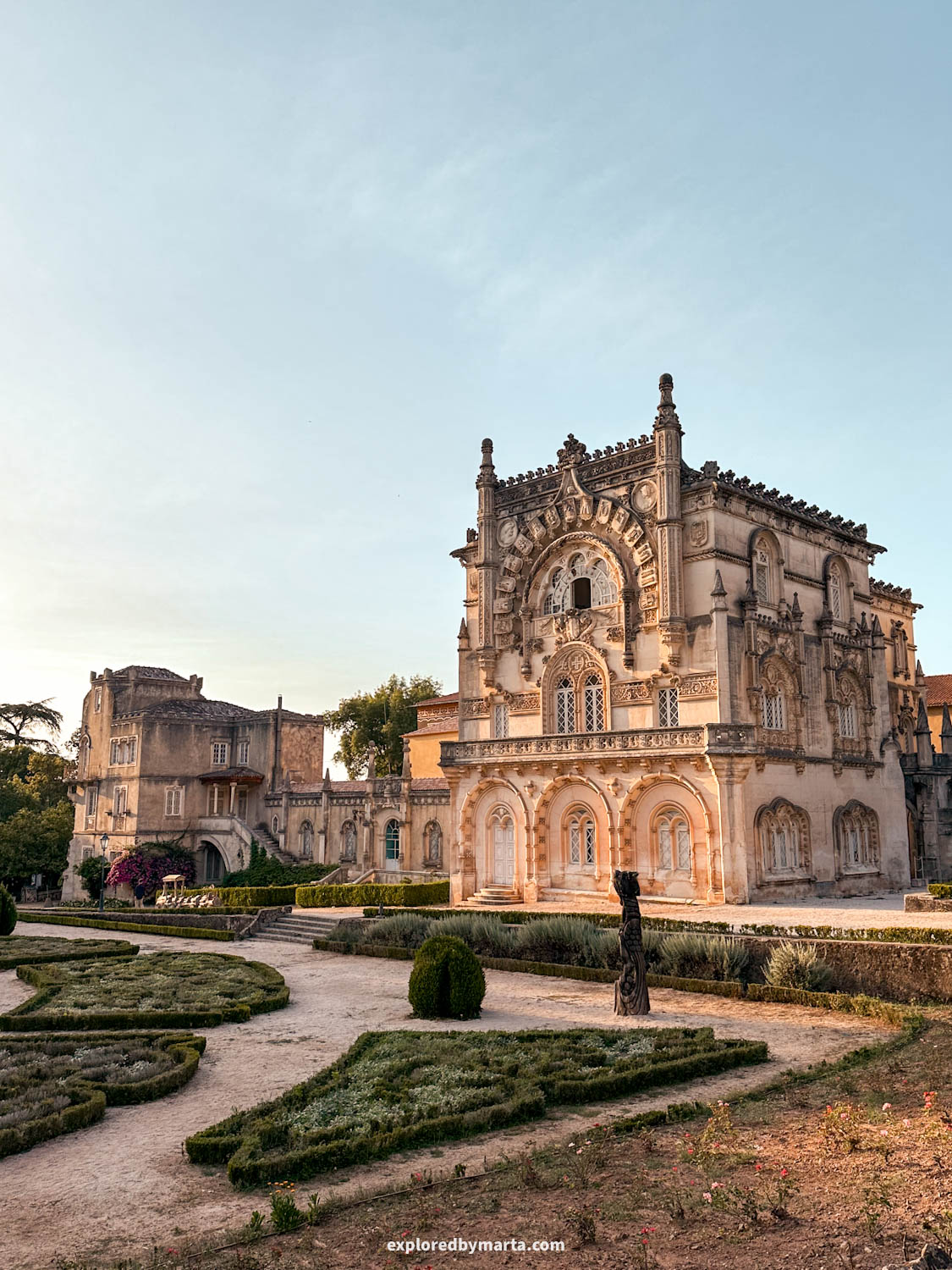
This secret convent, along with the luxurious garden with countless species of trees, was built in the 17th century. Part of that convent, as well as a church, is still preserved beside the palace to this day, but much of it was rebuilt.
The Palace Hotel of Buçaco, as we see it today, was finished in 1907. The palace proudly boasts a Neo-Manueline architectural style (a style born in Portugal). It is definitely one of the most beautiful buildings in Portugal!
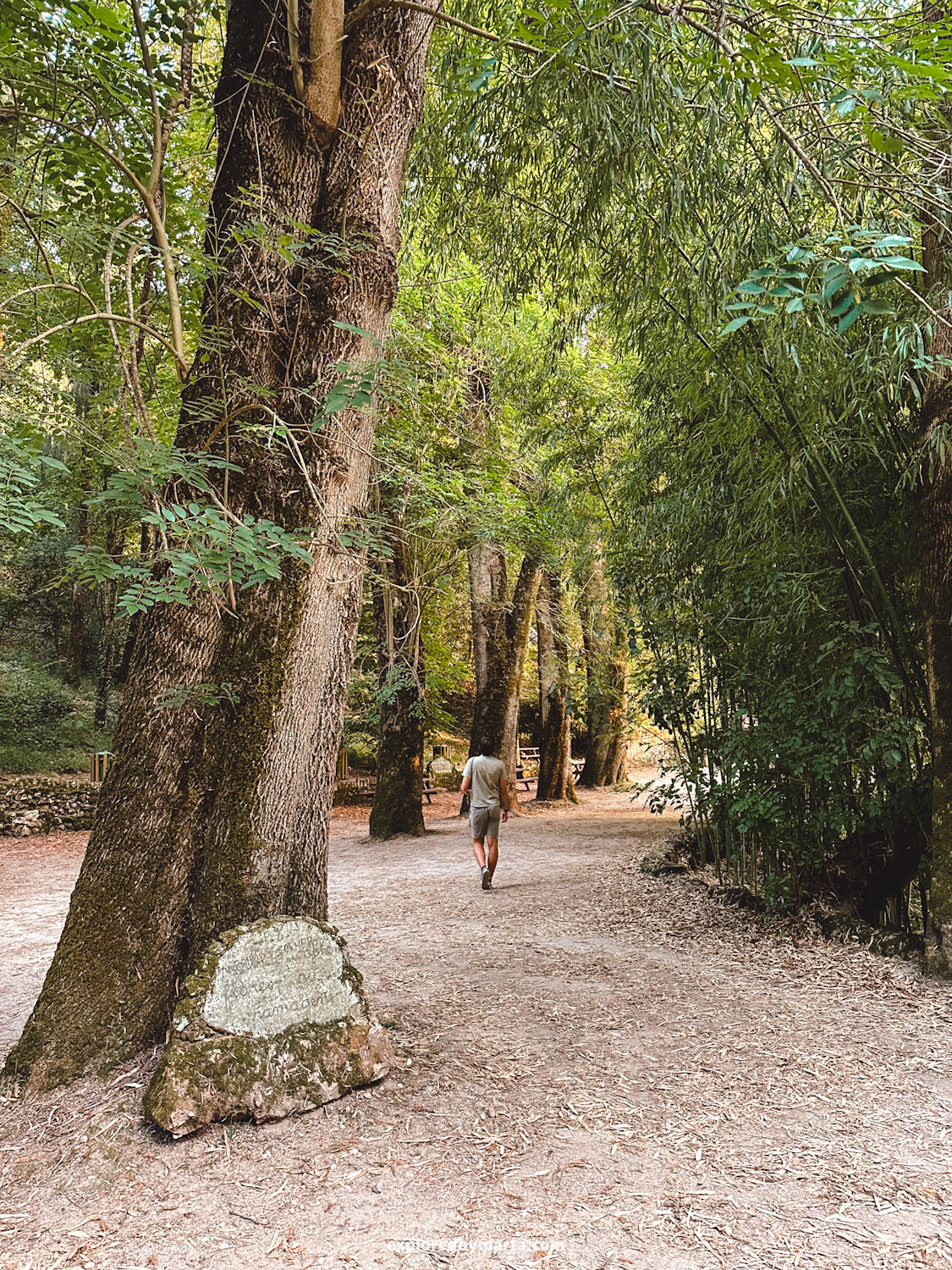
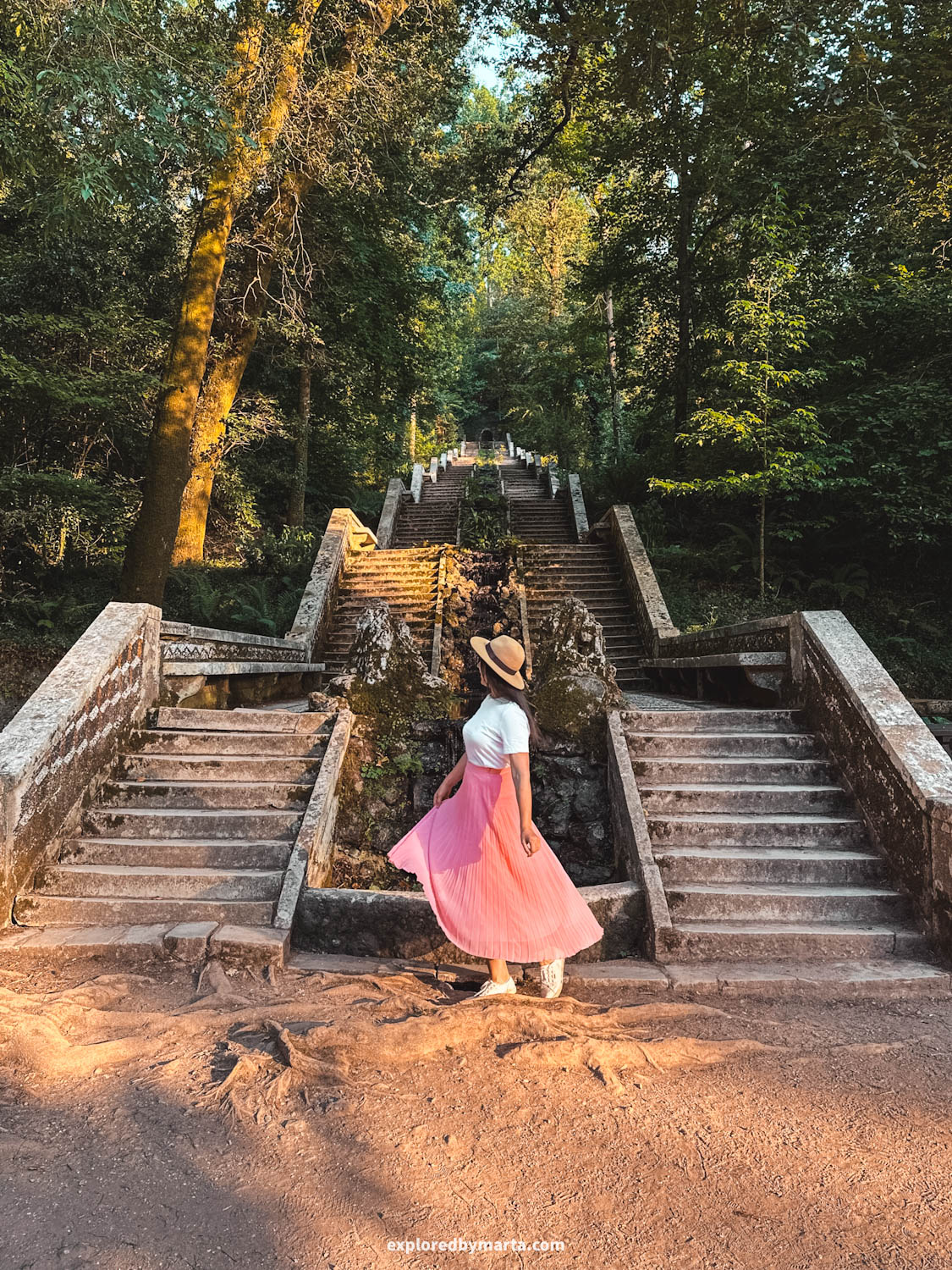
You can freely walk around the surroundings of the palace, the spectacular garden, and the forest with its 250 plant species. It is also possible to peek inside the palace, however, we did not have time to do that.
Adding to a long list of iconic staircases in Portugal, Buçaco National Forest also hosts a 19th-century stairway right by the Fonte Fria cold water fountain. By the way, this area also sources my favorite water brand in Portugal – Luso (Luso town is next to this forest).
I loved exploring this place! The ancient arboretum, with its thick vegetation, pathways, stairs, and fountains, only added to the beauty of the palace hotel. If you are in the area, definitely stop by this hidden place!
Location: Buçaco Palace – Fonte Fria fountain
11. Yellow Submarine
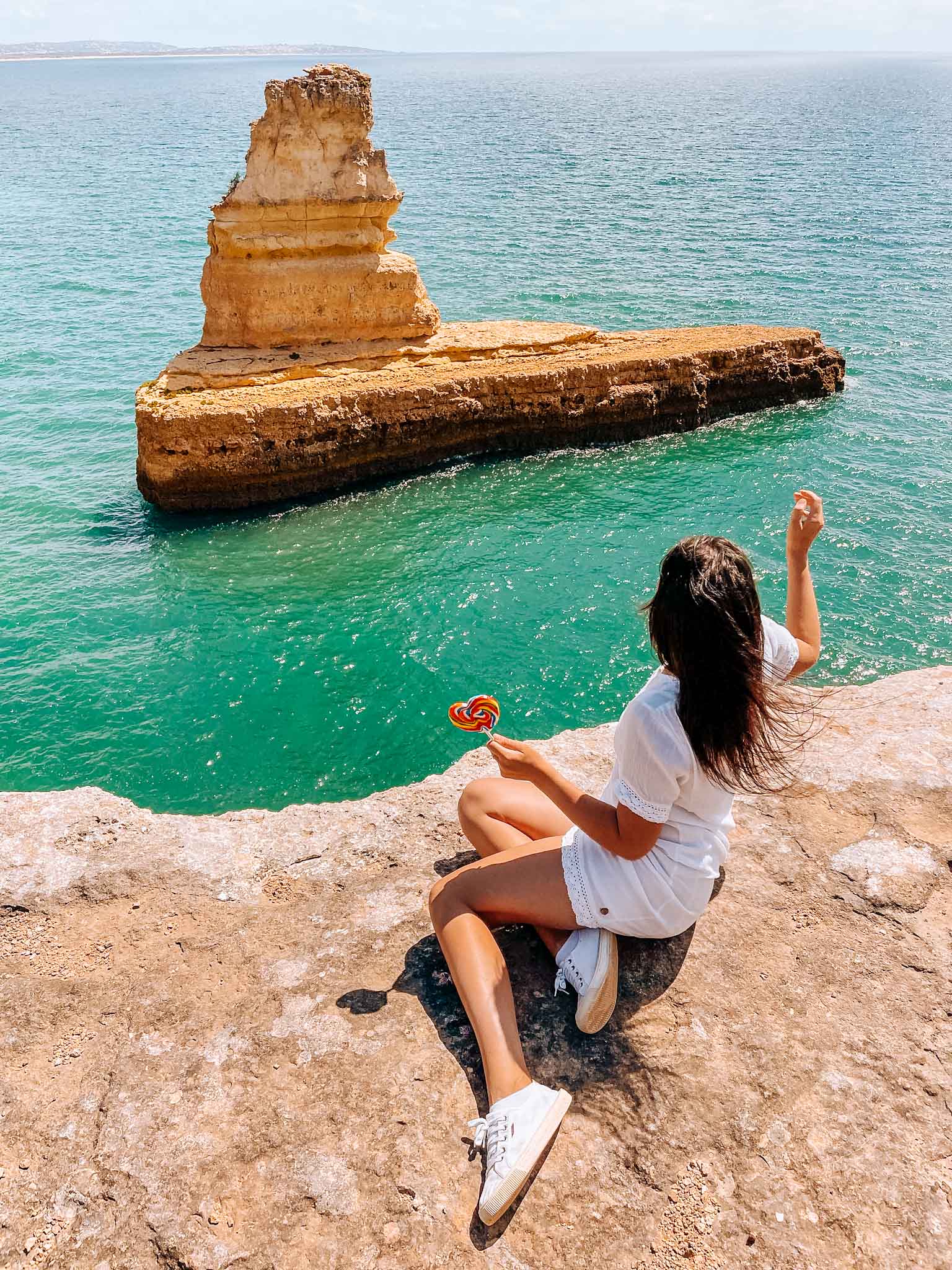
Yellow Submarine Rock is amongst my favorite hidden gems in the Algarve, Southern Portugal! It’s basically a large, uniquely shaped rock formation that resembles a submarine floating in the ocean, which is how it got its name.
The best way to visit it is by admiring the submarine from the coastal cliffs (it’s a 20-minute walk from Praia da Marinha along the coast). It is too far into the ocean to get there on foot or by swimming.
Or you can join a boat tour from the nearby Armação de Pêra and visit it as part of a longer kayaking excursion along one of the best sections of the Algarve coastline. Either way, this is one of those cool, lesser-known natural landmarks that make the Algarve region so special!
Location: Yellow Submarine
12. Miradouro de Fafião
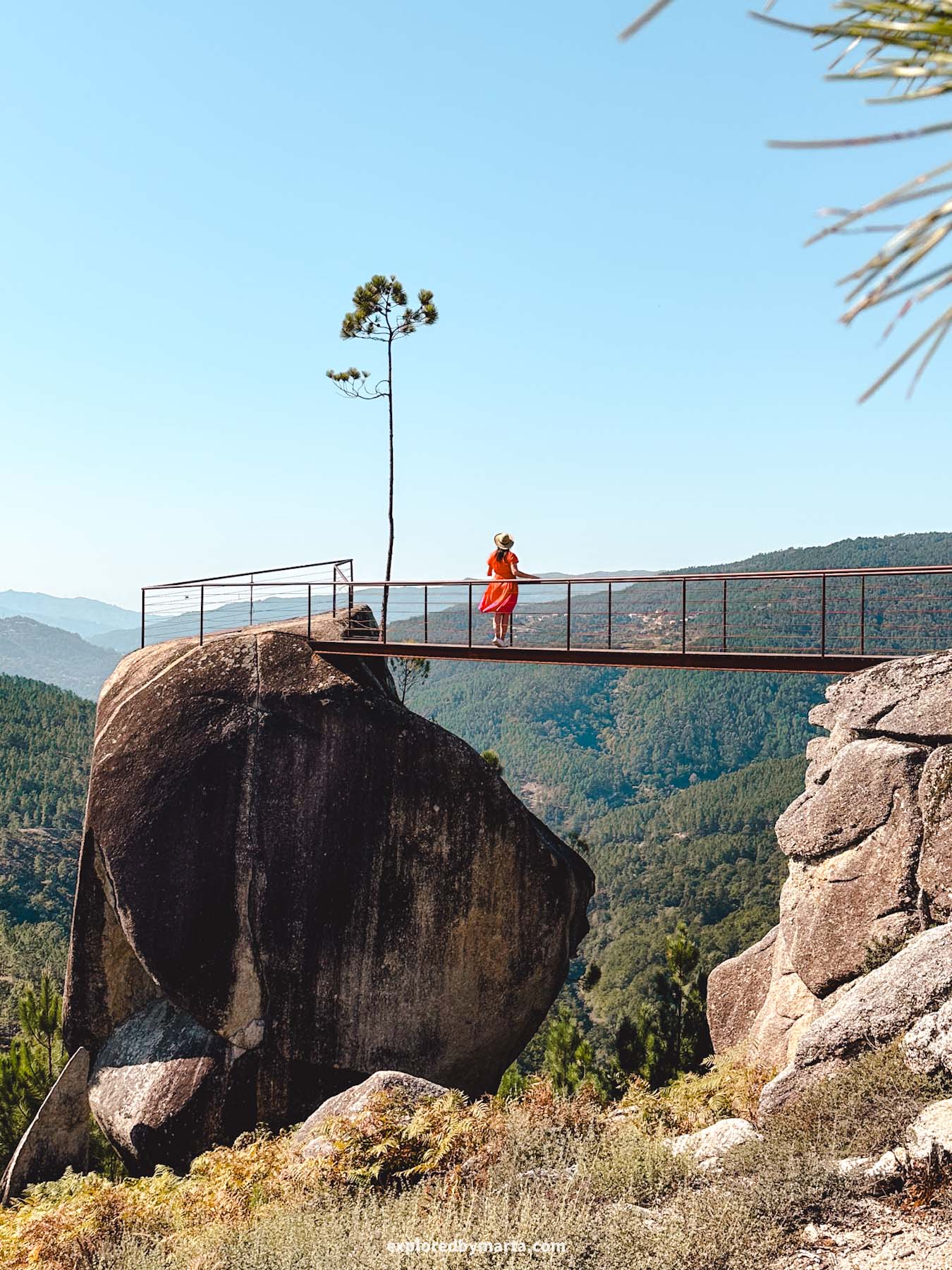
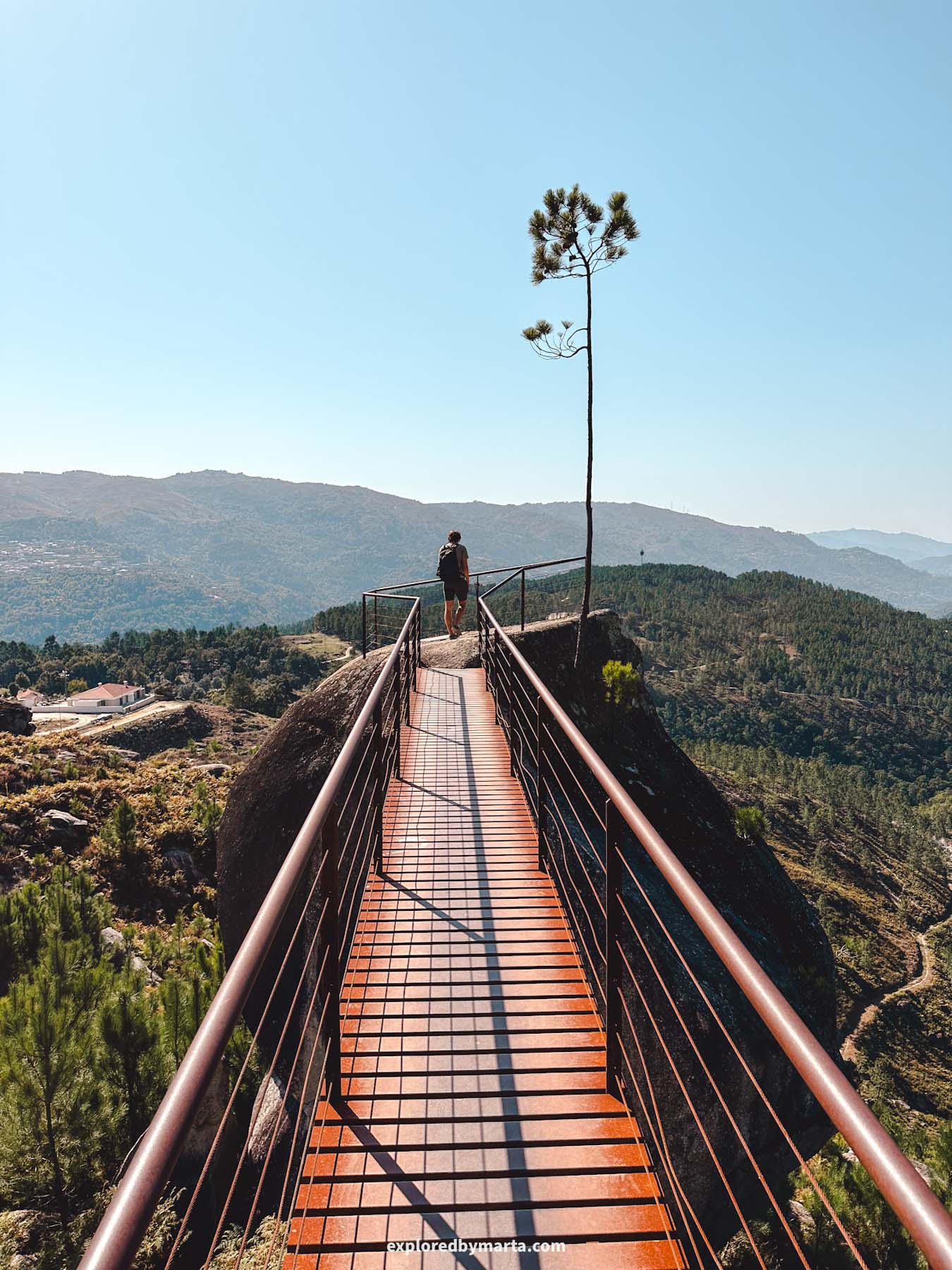
Miradouro de Fafião is a unique viewpoint located in the Peneda-Gerês National Park in northern Portugal. It is one of those truly wild and unforgettable places hidden from tourist crowds.
What makes it extra unique is that the viewpoint is placed on a massive boulder, and you can get there by a small pedestrian bridge.
Miradouro de Fafião offers some of the most dramatic panoramic views of the national park – the endless green hills, deep valleys, and rugged granite peaks as far as the eye can see.
Unlike many popular viewpoints in Peneda-Gerês National Park, Miradouro de Fafião is still off the beaten path, so you might find yourself completely alone there, just like we did. If so, then enjoy!
Location: Miradouro de Fafião
13. Monsanto, the most Portuguese village in Portugal

Stone caves and houses built above or under large boulders – this is the mysterious stone village of Monsanto, definitely one of my favorite places we visited in Portugal!
Voted as the most Portuguese village in Portugal, this ancient village attracts plenty of visitors, who crave a feeling of stepping back in time. Although it sees plenty of daytrippers, in my opinion, it still remains a hidden gem in Portugal.
Some of my favorite things we did in Monsanto include climbing up to the 12th-century Castle of Monsanto, visiting boulder caves and boulder houses, as well as tasting the famous cherry pastel de nata – pastel de cereja.
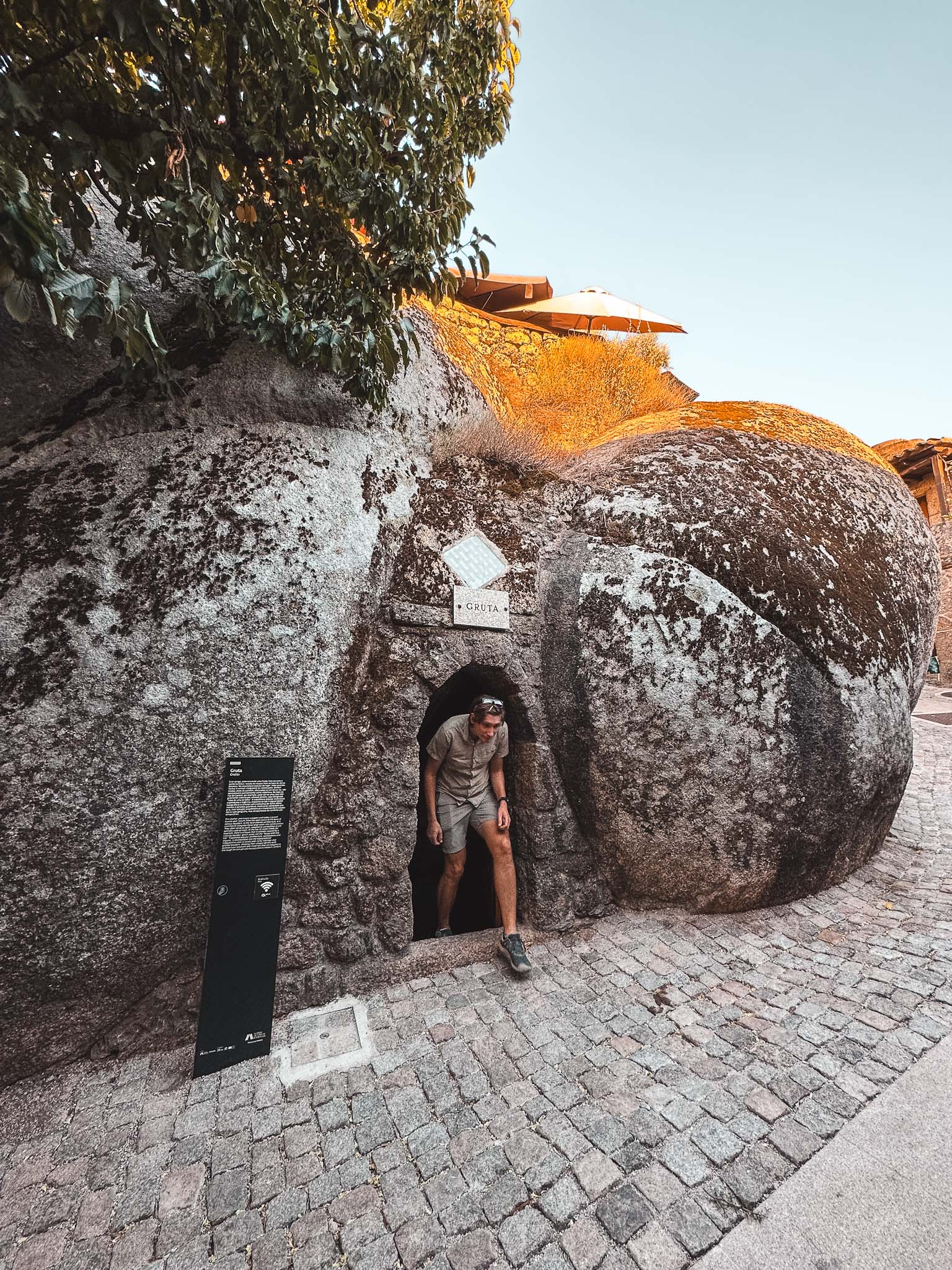
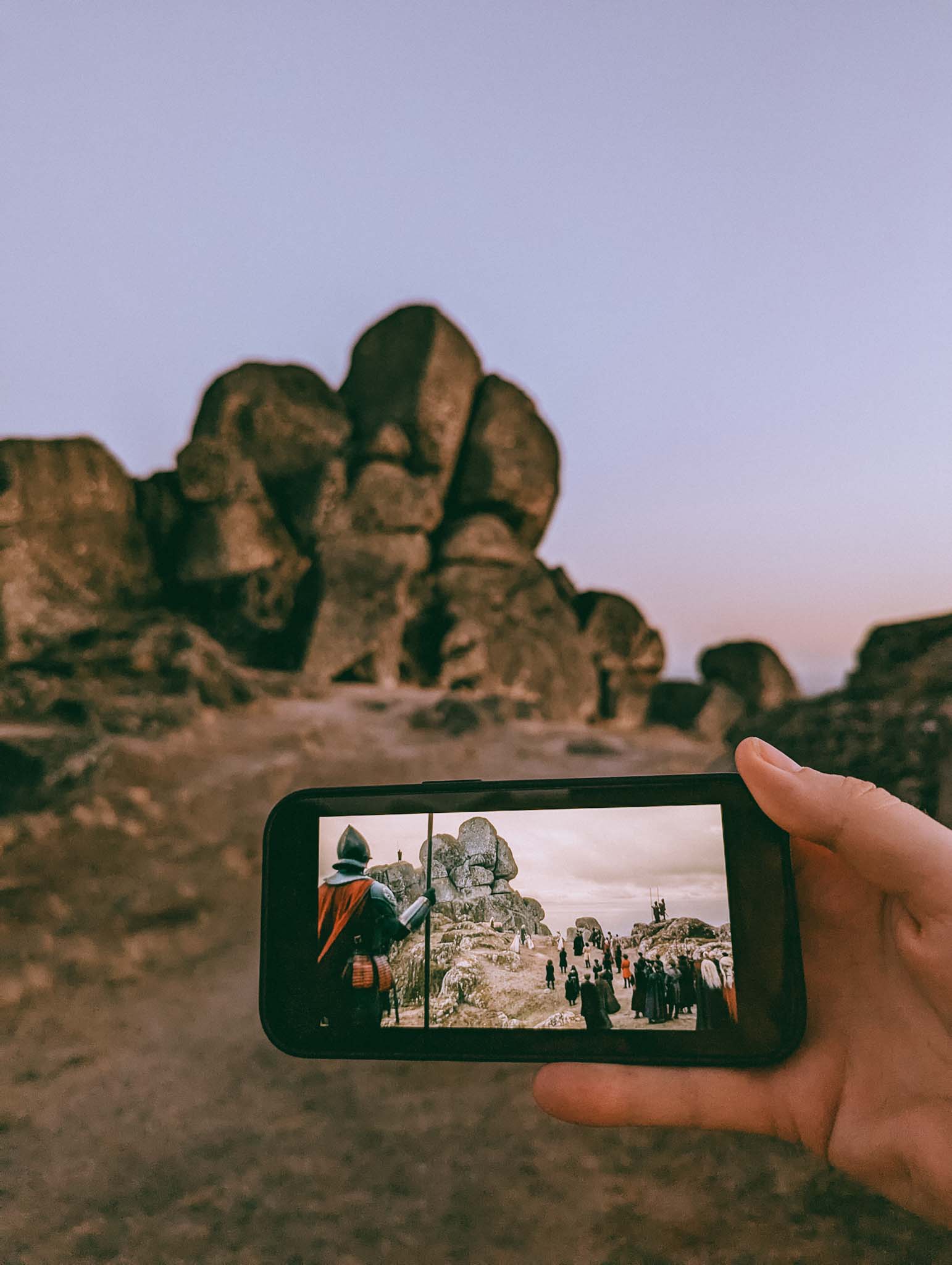
The village got extra fame after the well-known TV series House of the Dragon filmed a couple of scenes right in this village. Namely, they filmed Daemon and Rhaenyra’s wedding here on a foggy day, as well as Rhaenyra’s coronation.
Probably my favorite thing to do in Monsanto was hunting the best viewpoints. The village sits on a hilltop 763 meters (2,503 ft) above sea level, offering panoramic views over the surrounding area.
We saw the most beautiful sunset here! Sadly, it was made more beautiful by the smoke from the forest fires. See the orange layer above the ground in the first photo?
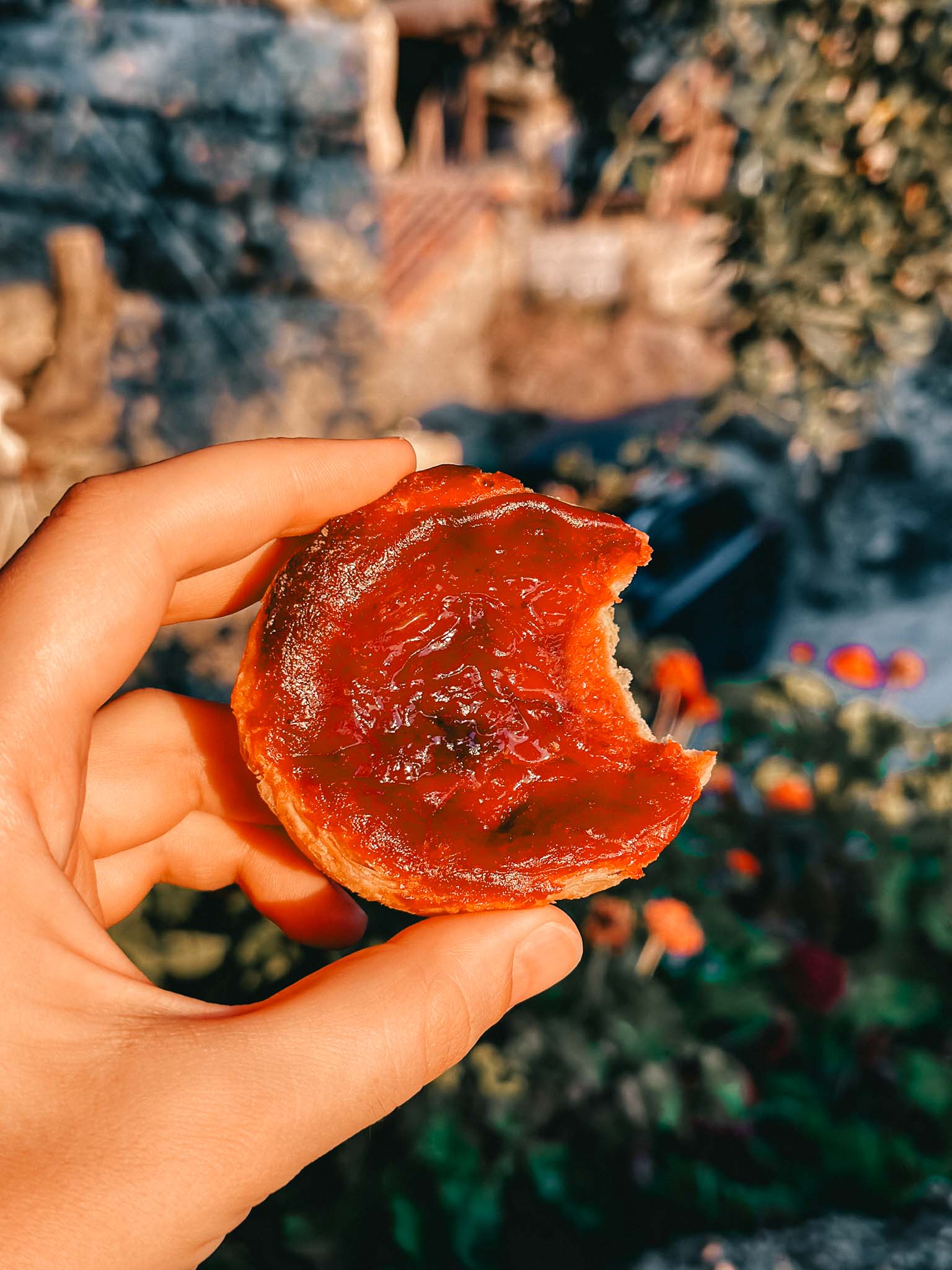
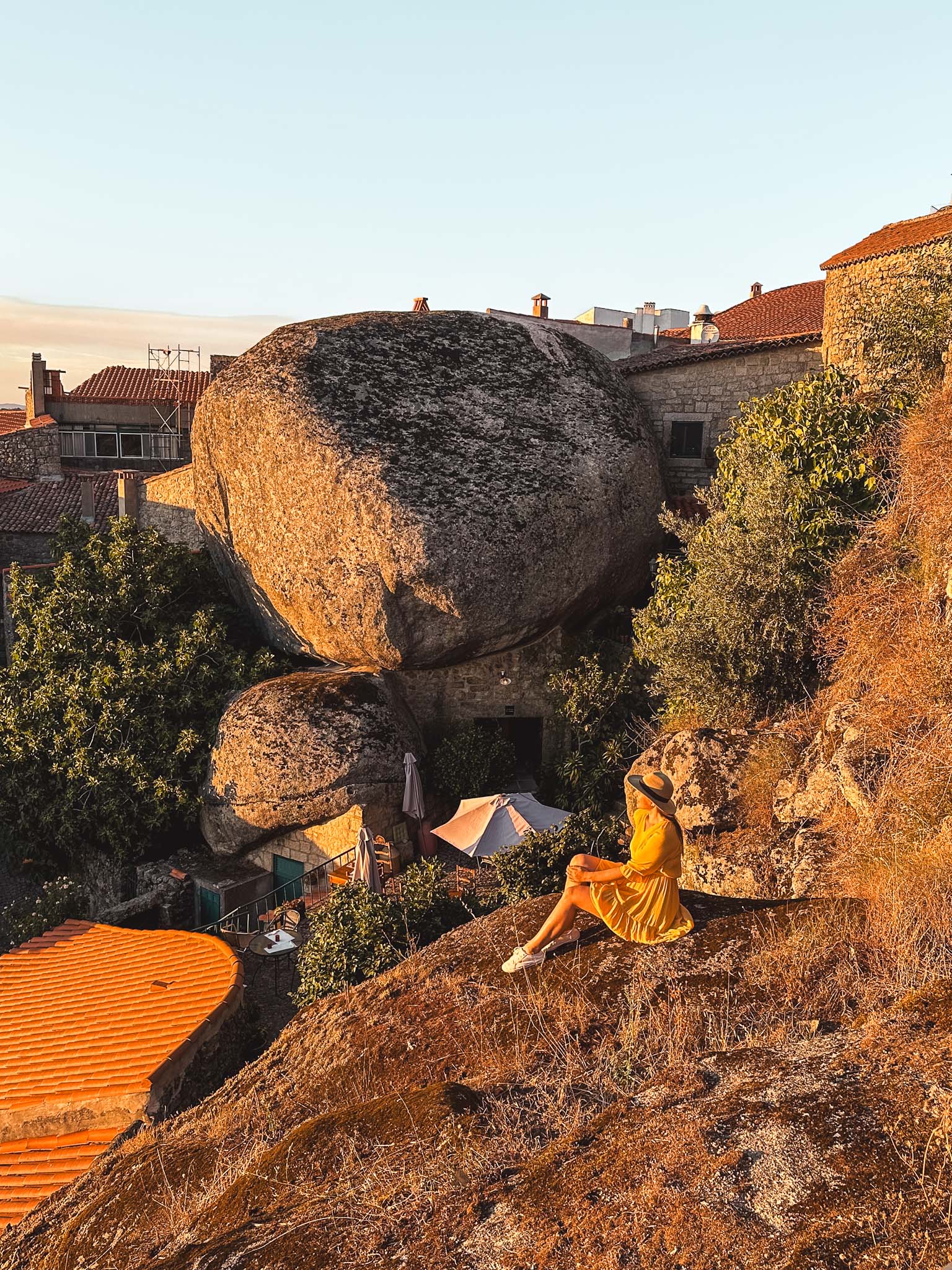
Monsanto is one of Portugal’s best-kept secrets and very much worth a visit!
The stone village is located deep inland, about a 2-hour and 45-minute drive from Lisbon. It is the perfect destination to include in your Portugal road trip itinerary, or you can visit on a day trip from Lisbon.
Monsanto is small and gets a bit busy during the day, so I would recommend arriving here in the evening, staying the night there like we did, and then exploring the village the next morning before the buses arrive!
Location: Monsanto
14. Chapel of Bones in Évora

Chapel of Bones is one of the most unique hidden gems in Portugal, and one of the main attractions in Évora.
Many travelers know about the Chapel of Bones in Faro in Southern Portugal, but this one often goes unnoticed.
I was really keen to see this chapel and wanted to see if it really is as dramatic as it sounds. It definitely did not disappoint – all its inner walls, pillars, and ceiling arches are lined with human bones and skulls!
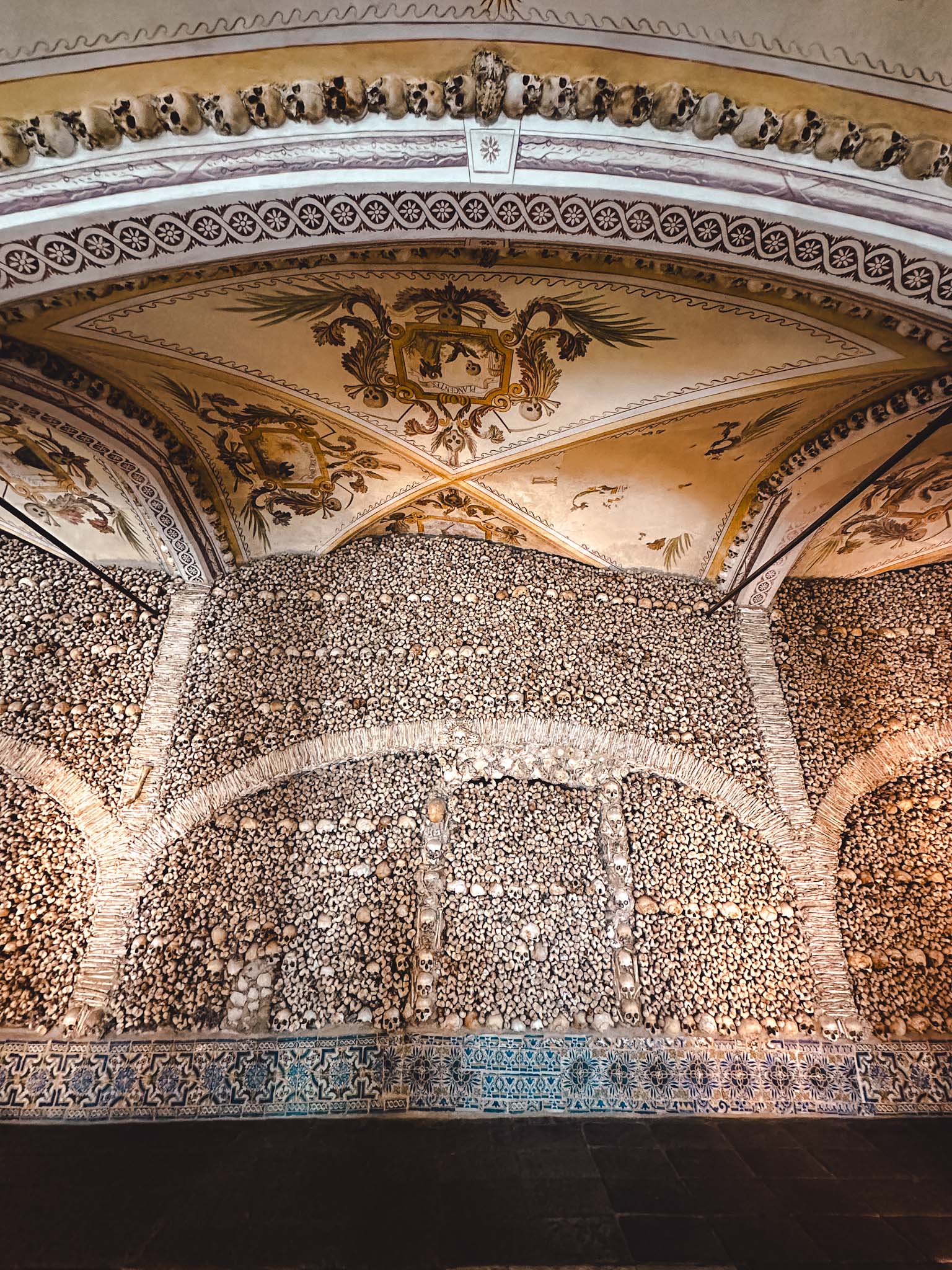
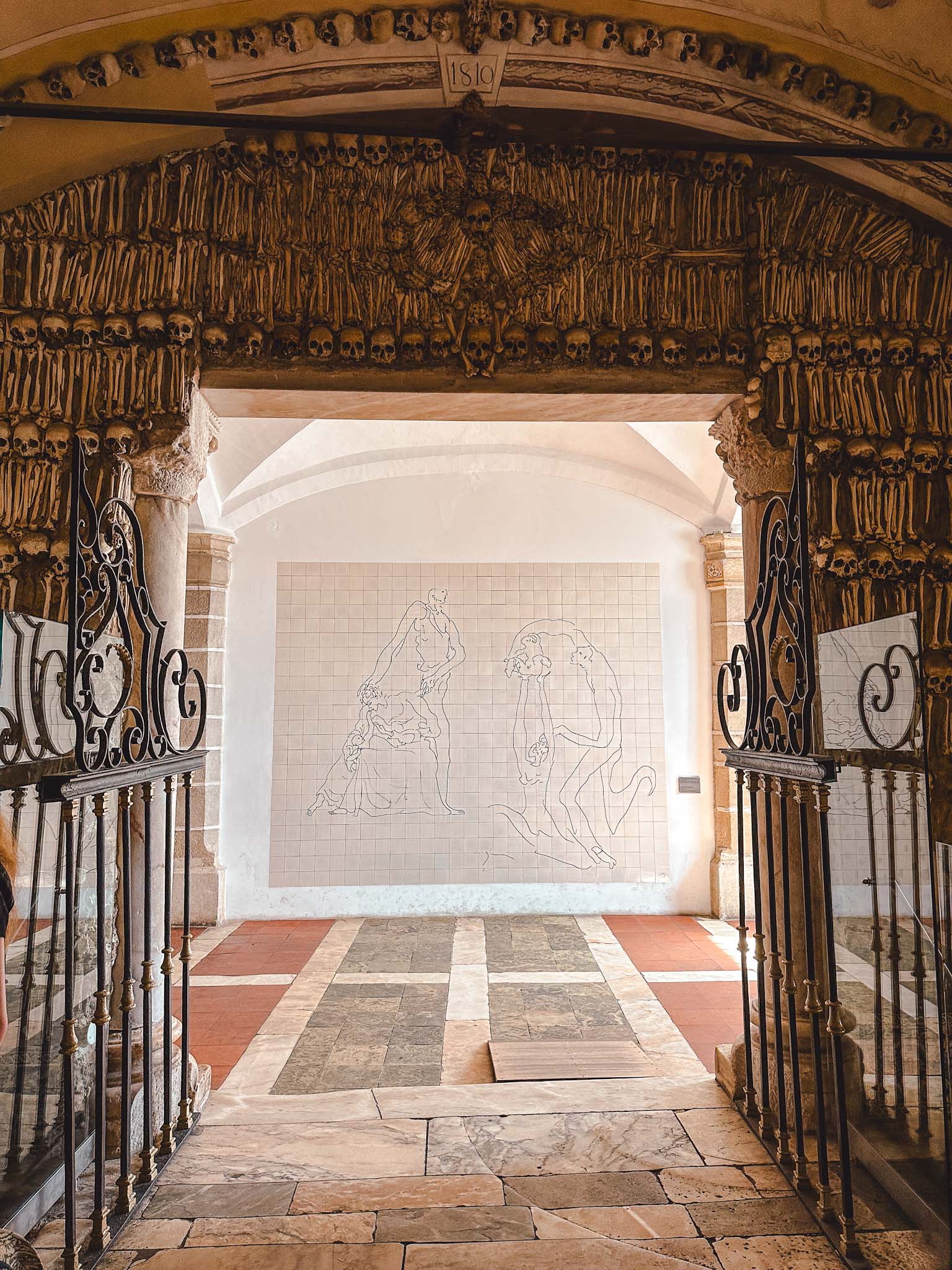
The Chapel of Bones is part of the Museum of Évora. The ticket costs a few euros and includes visits to the Évora Museum with its vast collection of religious objects, the Chapel of Bones, as well as the church of São Francisco.
The chapel is a built-in room inside the premises of the monastery and church complex, like a single room lined with multiple pillars, Portuguese tiles, and frescoes that decorate the vaulted ceiling, as well as bones from about 5,000 skeletons.
It is a strange feeling for sure, however, I tried to look at it as part of our historic heritage. This was something people did in those days, and it has to be looked at through their perspective, not mine, so then it was easier to take it all in!
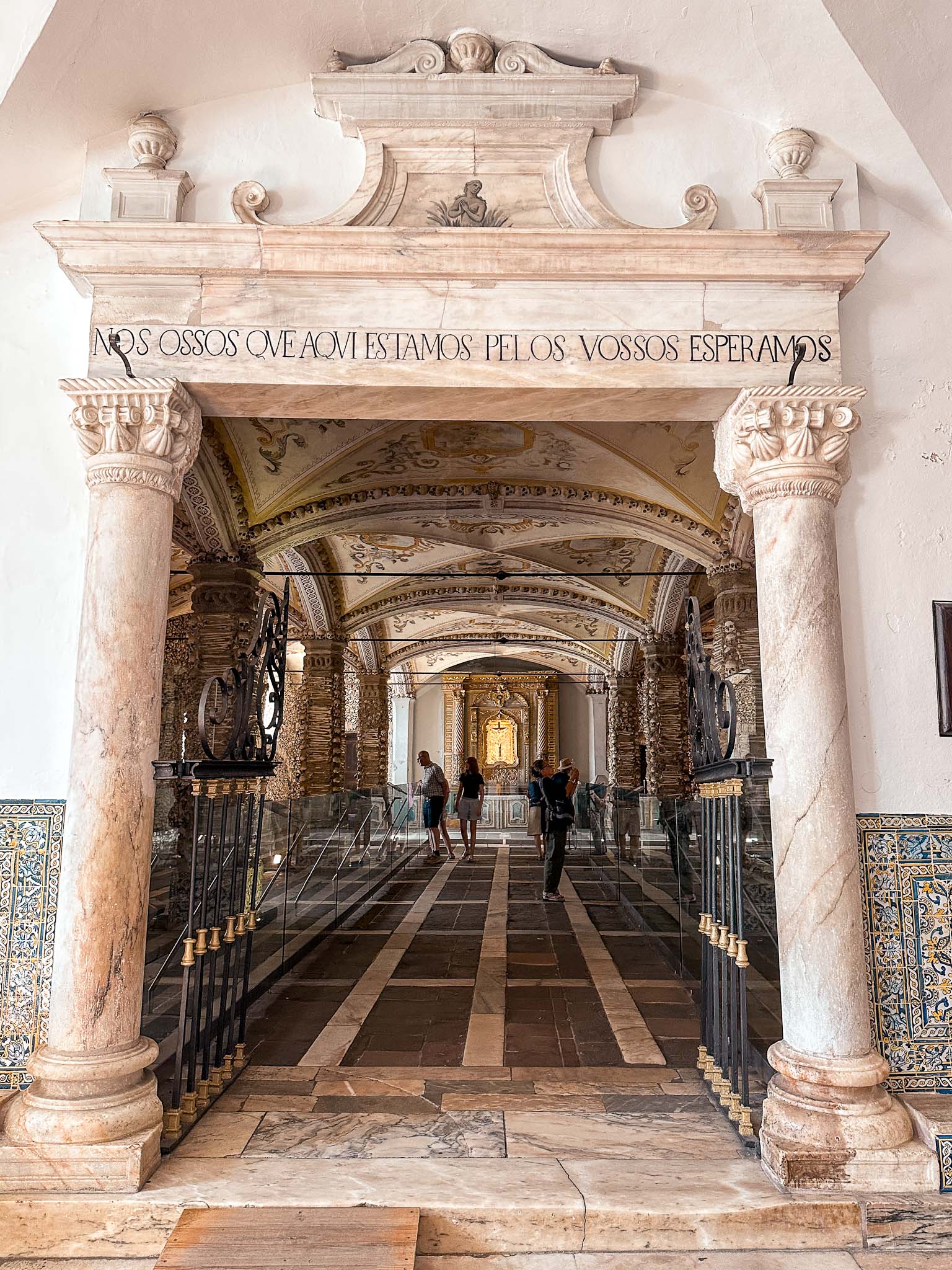
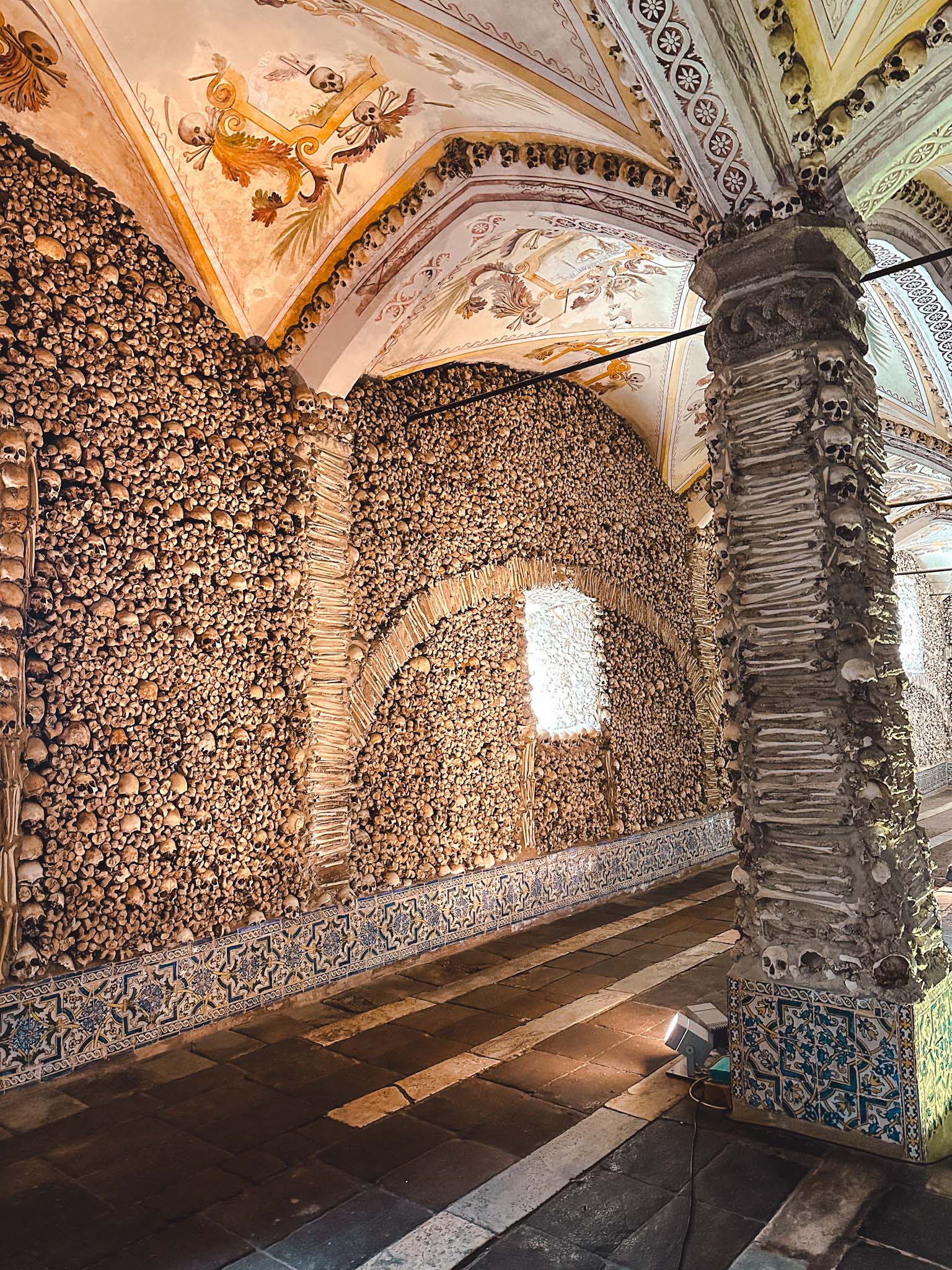
The Chapel of Bones was built in the 17th century and is definitely the star of the museum.
If you are wondering where all the bones came from, then there isn’t a crazy horror story – Franciscan monks just took them from the exhumated corpses from the medieval cemetery in Évora.
Another interesting part about the Chapel of Bones is the inscription above the entrance that says ‘Nós ossos que aqui estamos pelos vossos esperamos‘ and translates from Portuguese as ‘We, the bones that are here, for yours we wait’. Creepy or not?
Location: Chapel of Bones
15. Chalet of the Countess of Edla in Sintra

The Park of Pena in Sintra hides one of the most incredible buildings you will see and one of my favorite hidden gems in Portugal, the Chalet of the Countess of Edla!
Not many travelers realize that a visit to this chalet is already included in the price they have paid for visiting the famous Pena Palace in Sintra! And I haven’t seen it mentioned in other Sintra travel guides.
Most tourists just see the colorful palace and rush away, but I highly recommend walking over to the charming Chalet of the Countess of Edla, a wonderful yellow Swiss-style chalet hidden inside the lush green forest.
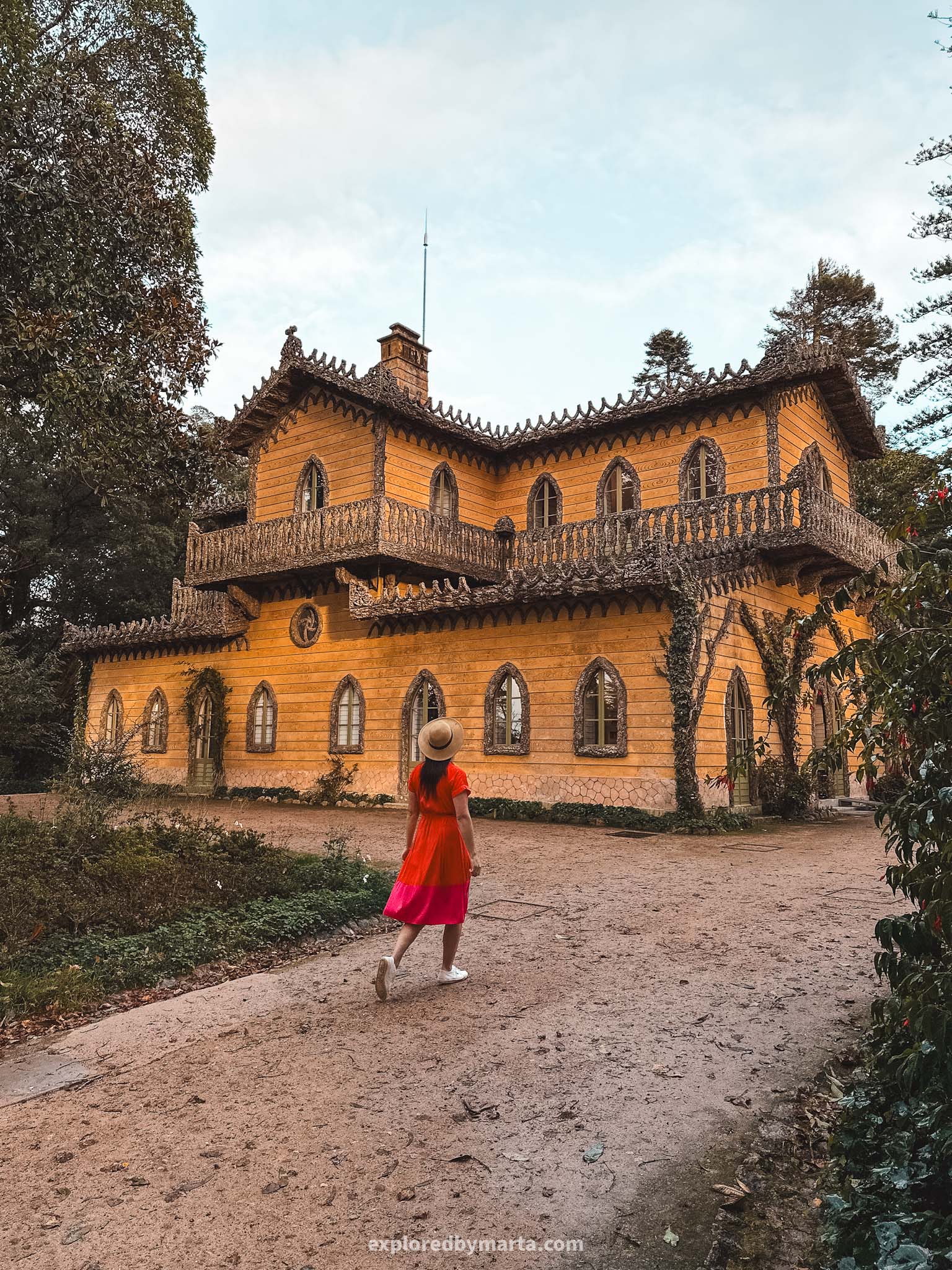
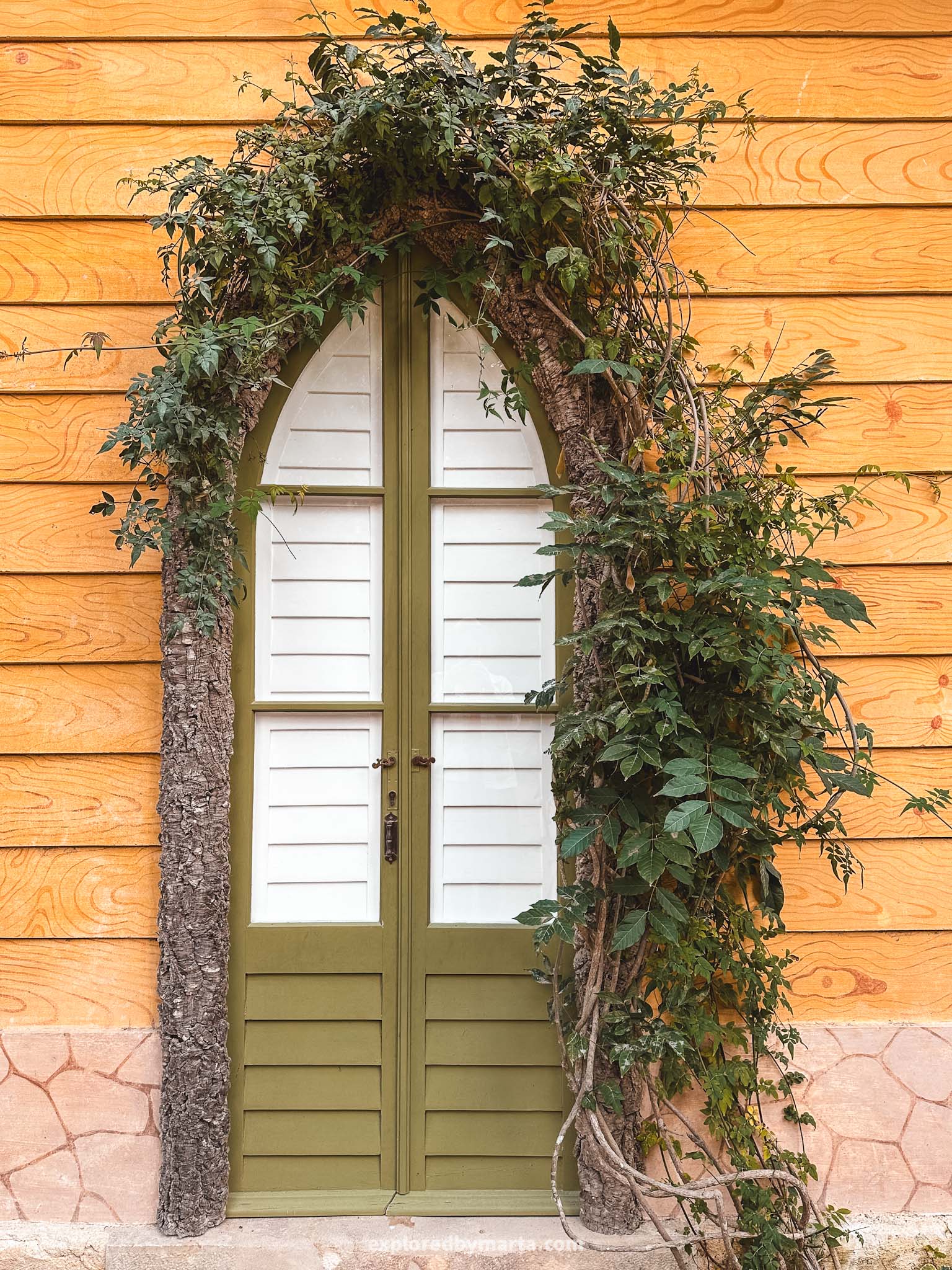
But here’s what’s so uniquely special about it!
The chalet’s balconies, windows, doors, and handrails are all covered with cork from the famous Portuguese cork oaks. This unique detail is something I haven’t seen anywhere else in Portugal.
Surrounded by lakes, fountains, and 200 species of plants, this chalet was built for King Ferdinand II of Portugal and his second wife, the Countess of Edla, during the second half of the 19th century.
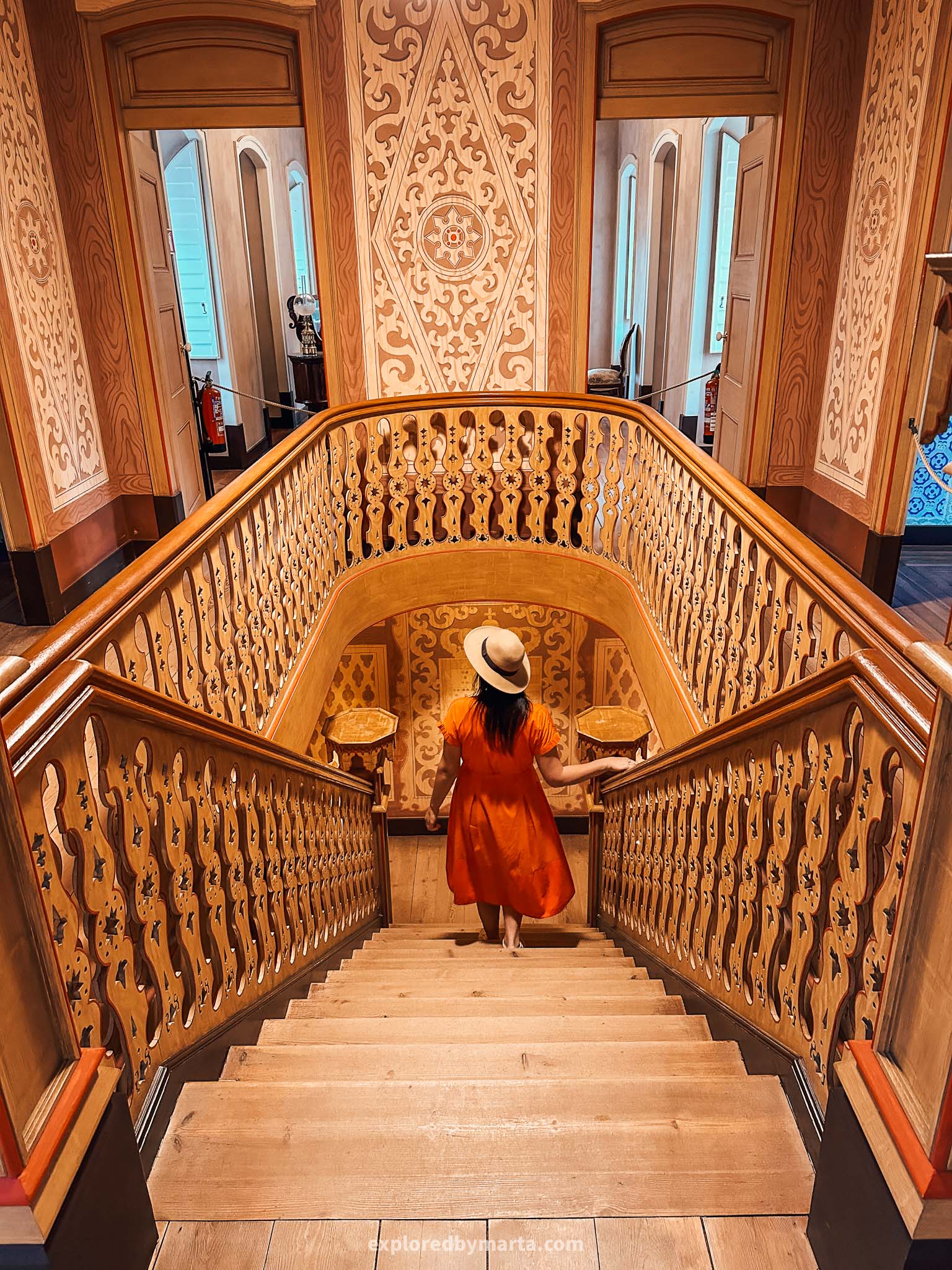

On the inside, you can visit different rooms on two floors – every room decorated in a different style, each one more unique than the others. The chaler is rather small, but definitely unique and captivating.
In the middle of the house, there is a beautiful stairway that connects both floors.
When we visited, there were practically no people around, as it is quite a walk away from the Pena Palace (about 1 mile/1.6 km). If you are not in a rush, I highly recommend taking a walk to the beautiful chalet.
Location: Chalet of the Countess of Edla
16. Marvão, one of ‘1000 places to see before you die’
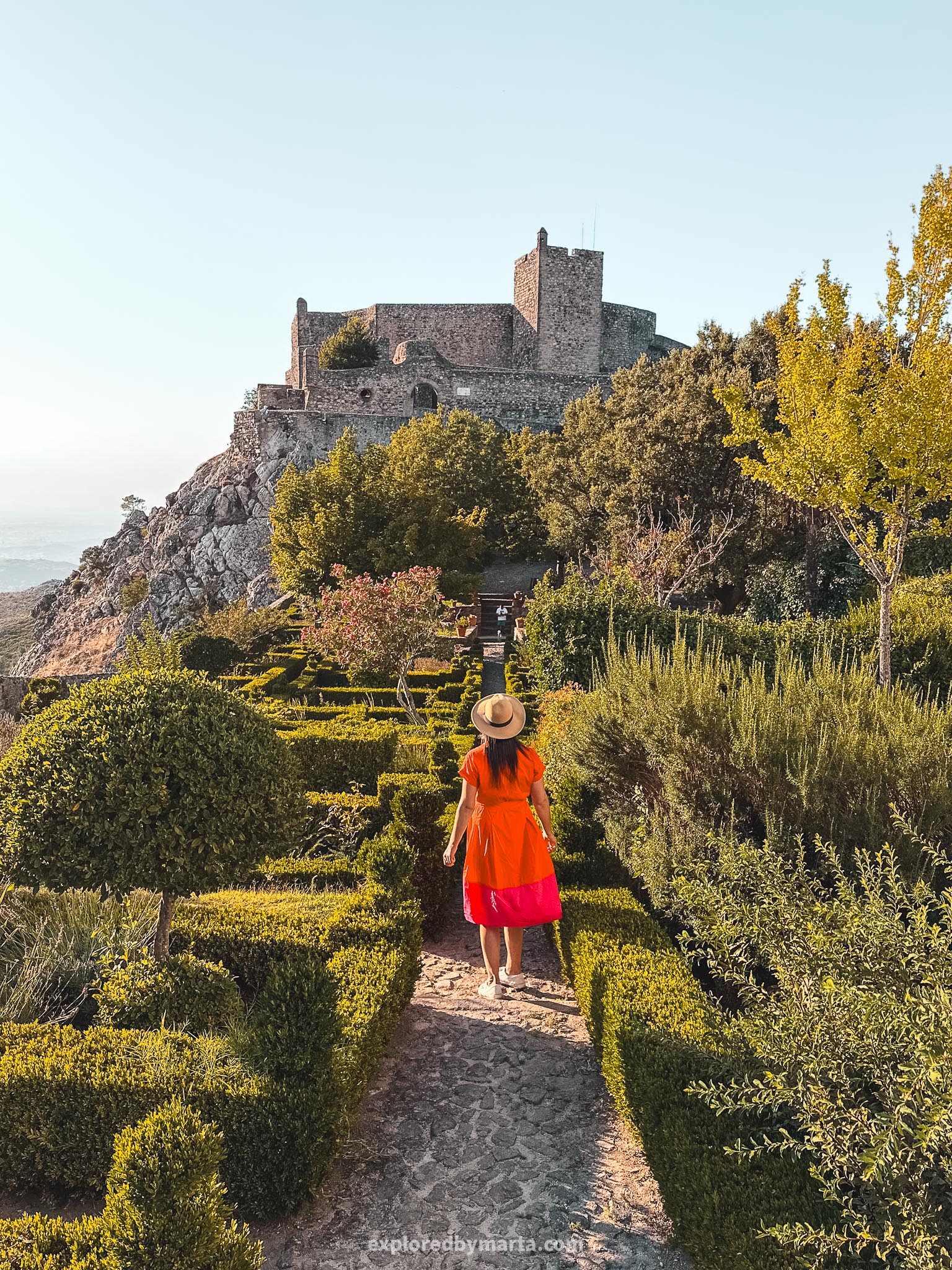
Marvão is one of Portugal’s most beautiful medieval villages, sitting 860 meters above sea level on a large quartzite rock in the Serra de São Mamede mountains in Eastern Portugal.
It is located near the Spanish border, a 2h 30min drive Northeast of Lisbon.
The village earned significant attention after it was listed in the #1 New York Times bestselling book ‘1000 Places to See Before You Die‘. With more than a thousand years of history, this village is a mystical place to discover.
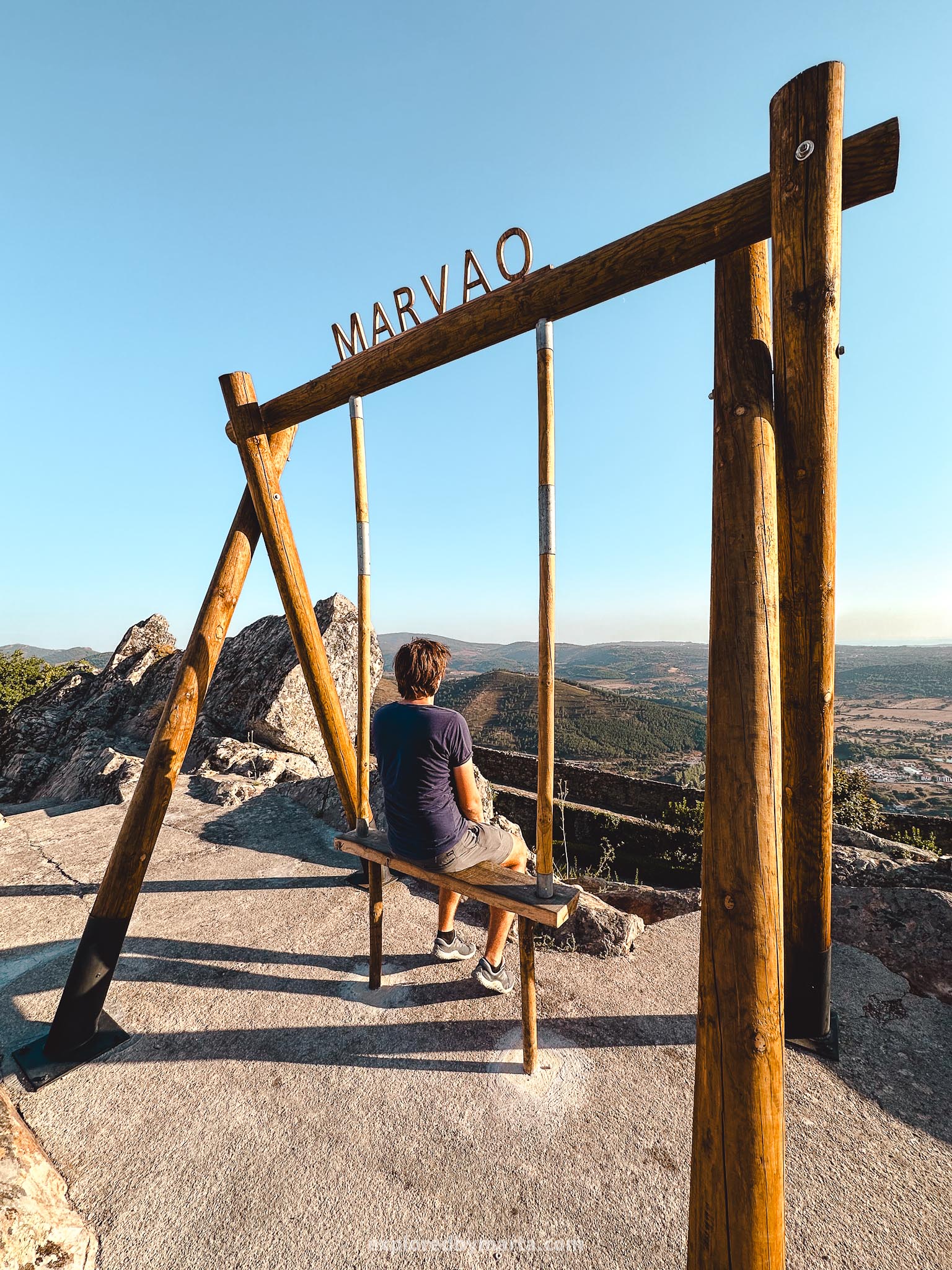
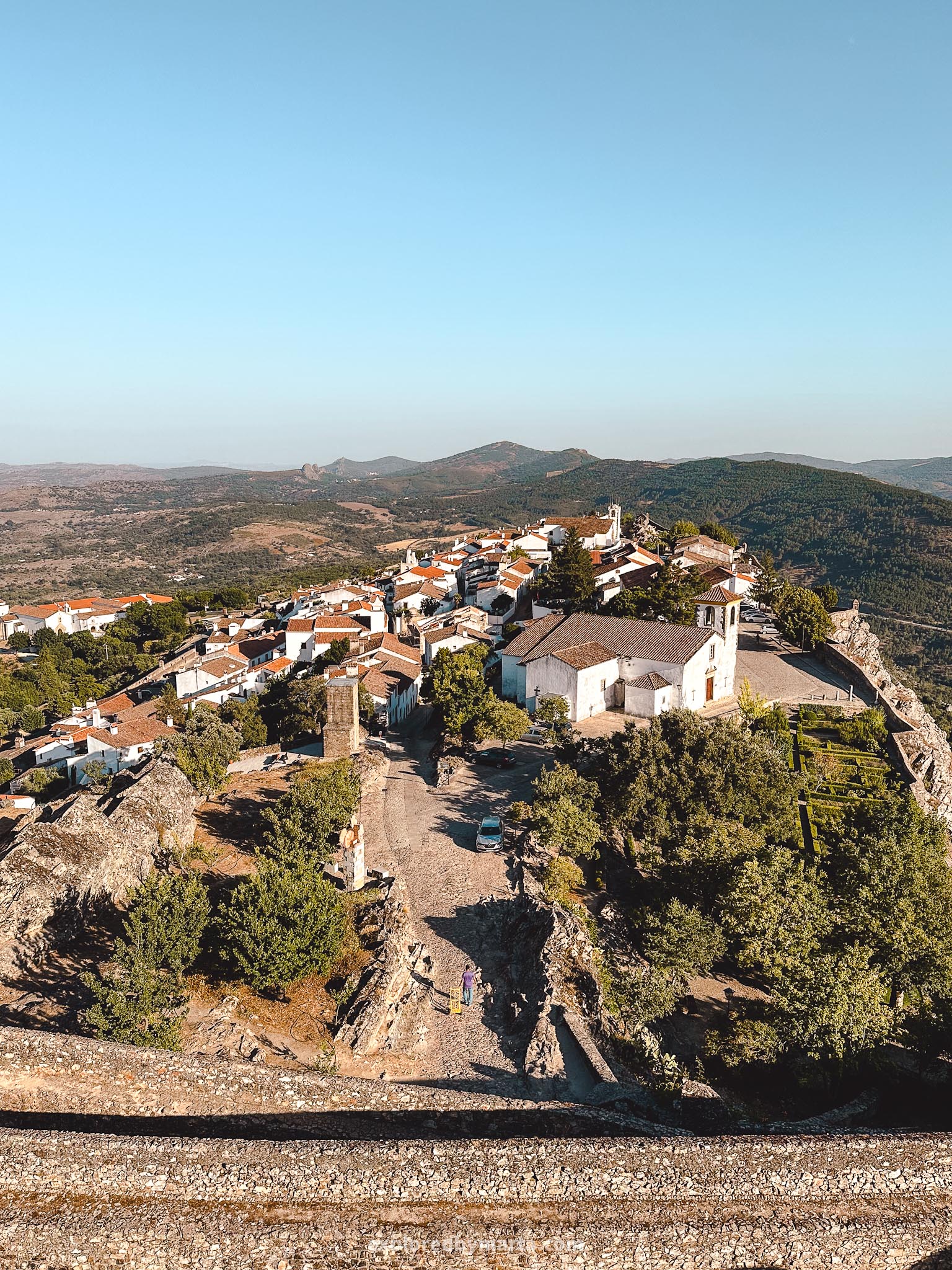
Marvão is a fortress with big stone walls completely surrounding the ancient village.
Once you step inside the fortification, you are thrown back to medieval times with those narrow cobblestone streets leading you into the maze of stone houses.
The most famous attraction in Marvão is the Castle of Marvão – a well-preserved medieval castle dating back to the 8th century.
You can access the castle’s walls, defensive towers, and courtyards for an entrance fee of 1.5 EUR. A total bargain, if you ask me!
Location: Castle of Marvão
17. Águeda, the City of Umbrellas
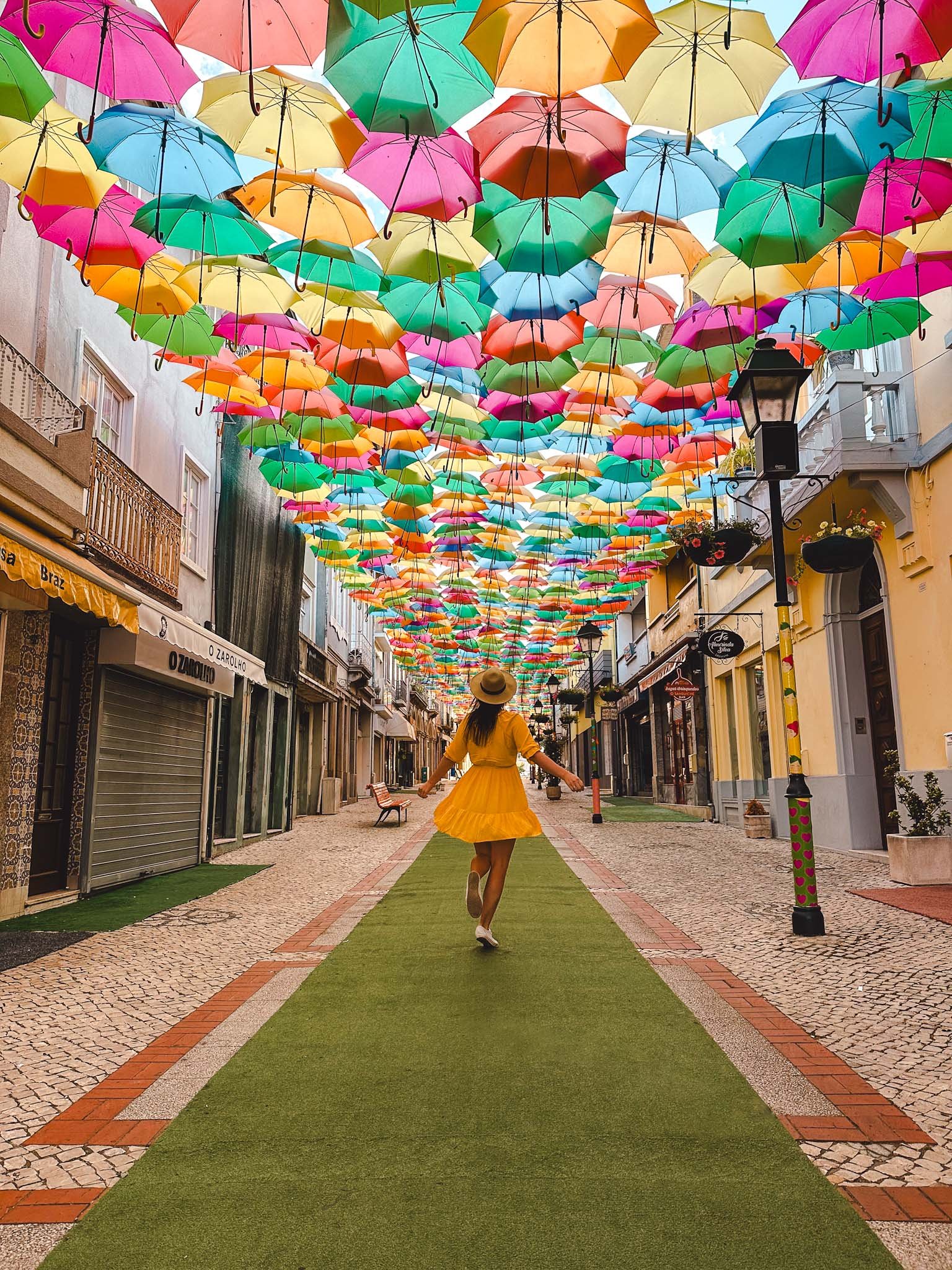
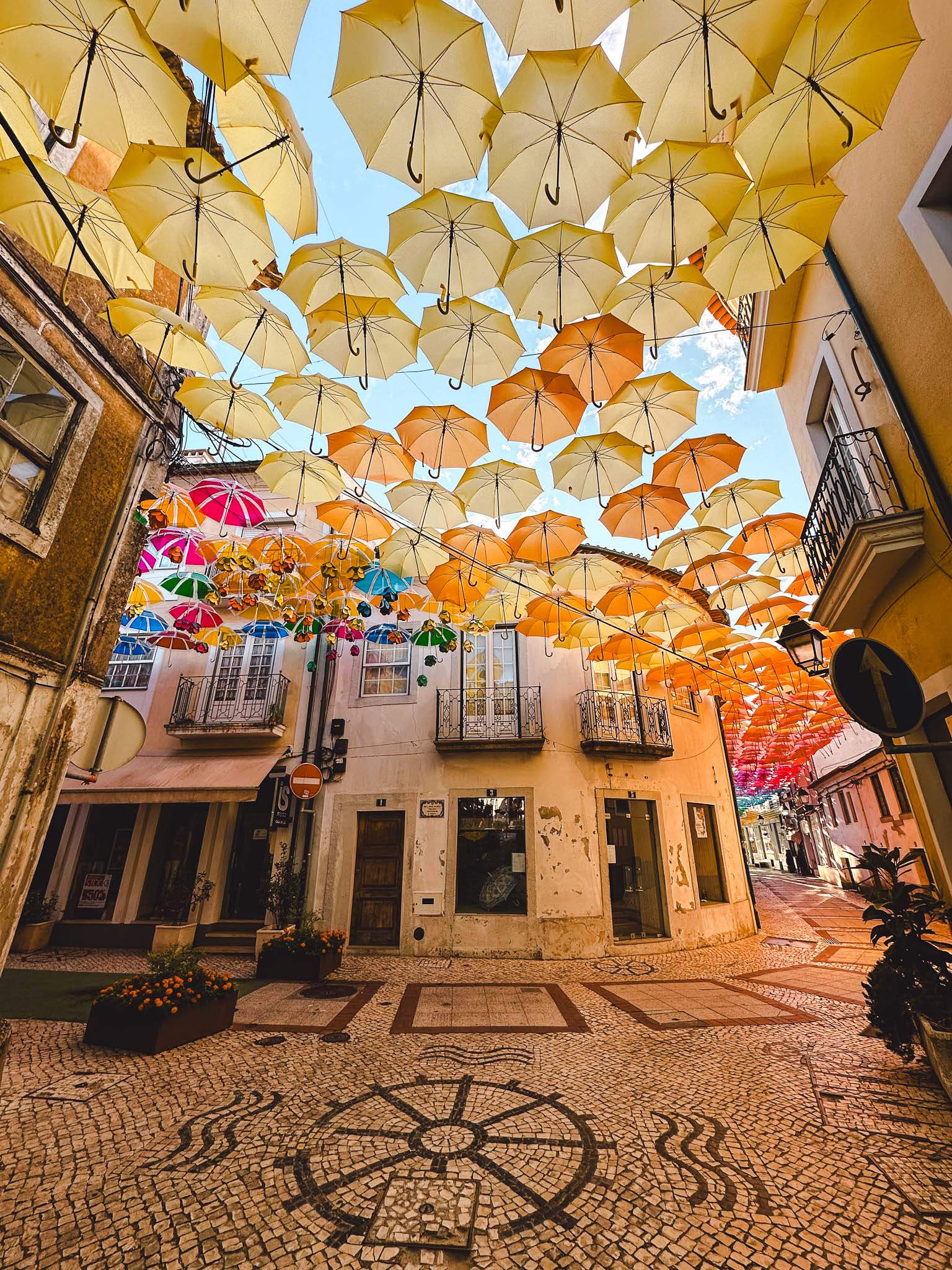
Águeda is a city in the Aveiro district, just a 30-minute drive away from Aveiro city. If you are visiting Portugal during the summer months (July to September), visiting Águeda is a must!
From July to the end of September, the city turns into a colorful spectacle, when the streets are decorated with thousands of colorful umbrellas as part of the globally famous Umbrella Sky Project.
It is one of the most unique hidden gems in Portugal and will be a memorable experience, if you time your visit right!
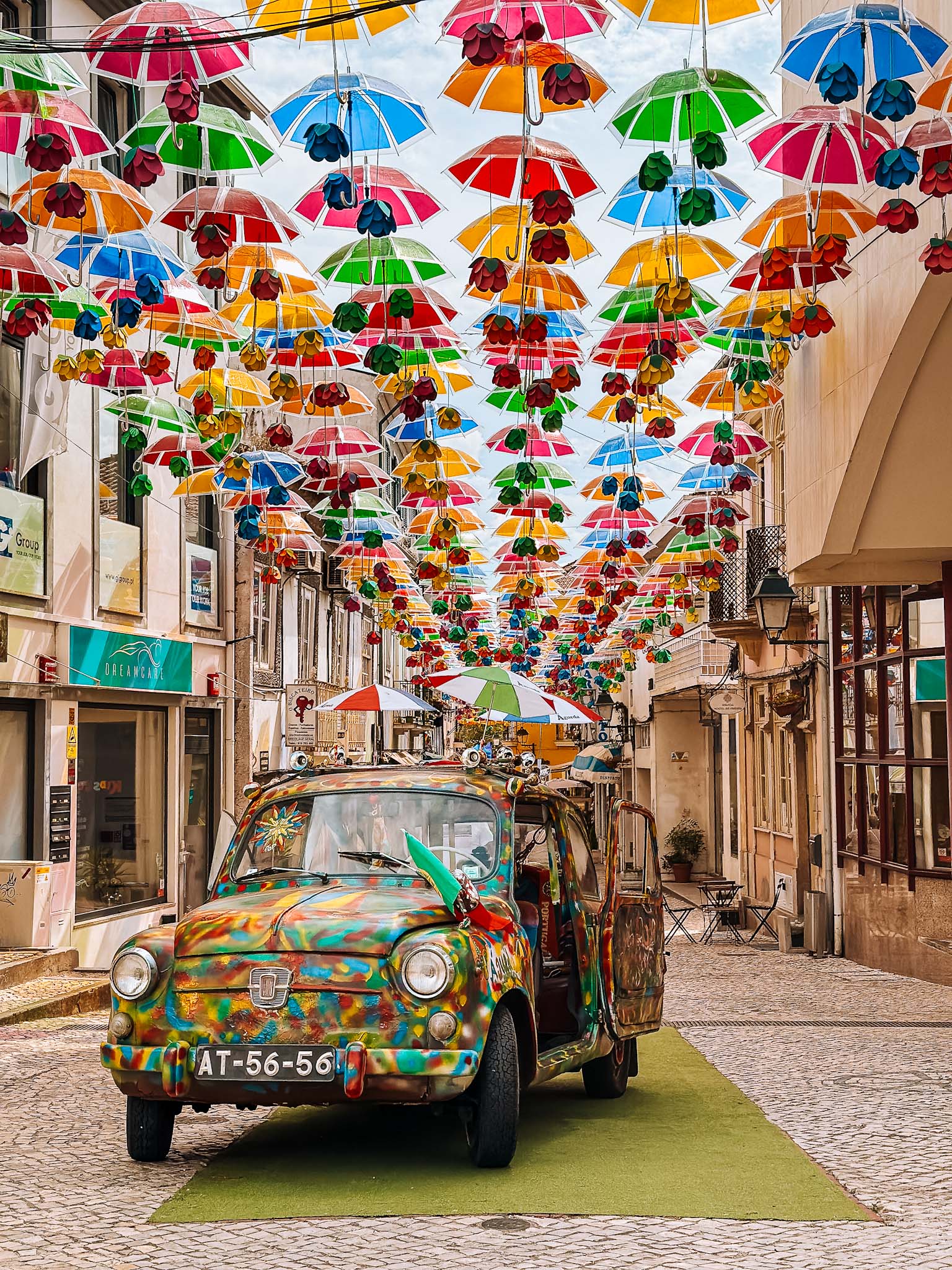
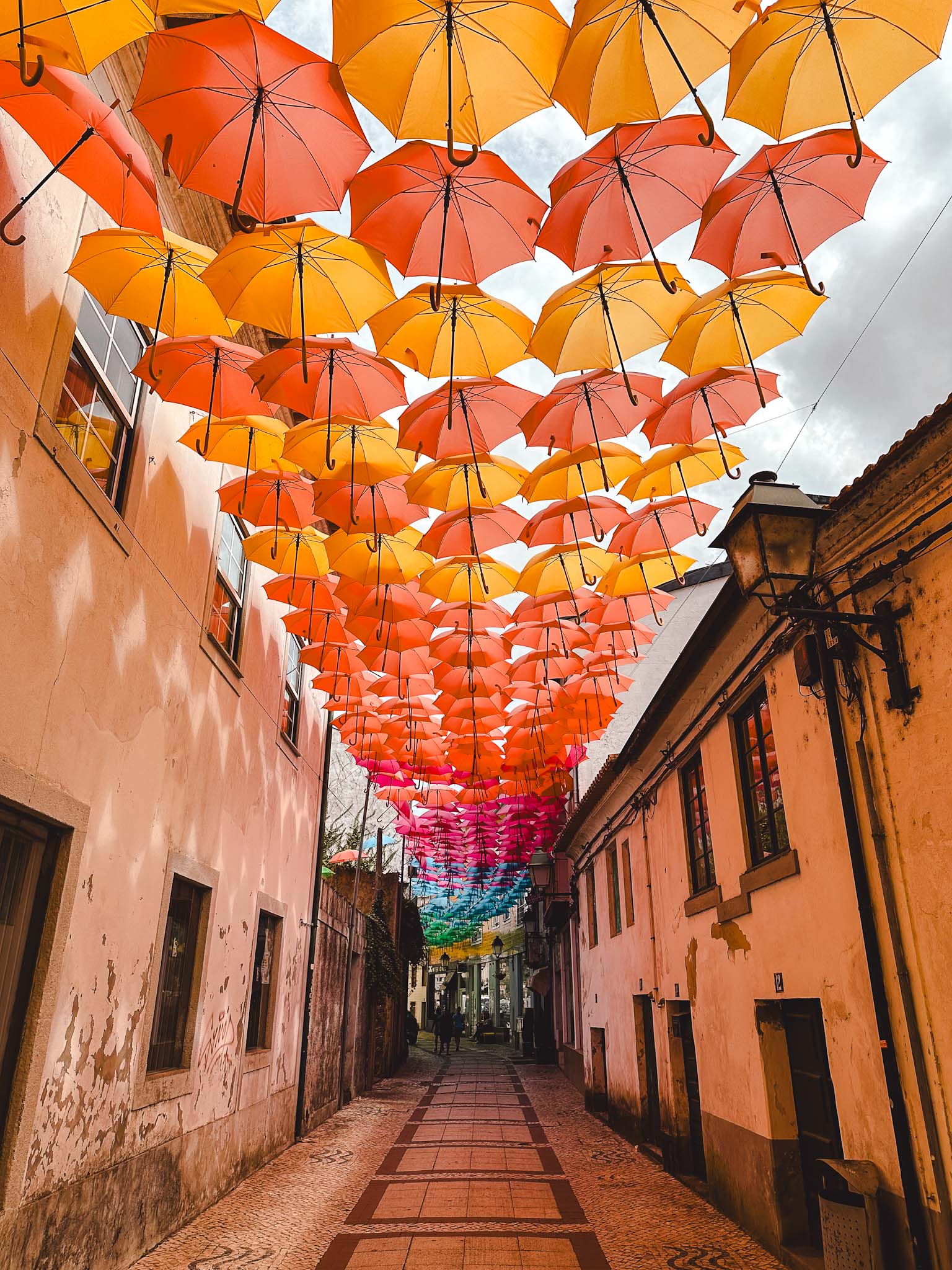
When we visited, I counted about five streets that were covered with colorful umbrellas and other decorations. Not only streets, but some houses and shops also had umbrellas on them.
There were colorful benches, even a decorative car on one of the streets, as well as other colorful decorations. I didn’t know about this place before our trip to Portugal, but luckily, we visited at the end of August, so everything was in full swing.
The best streets to go to see the umbrellas are Rua Luís Camões, Rua José Maria Veloso, Rua Jornal Soberania do Povo, and Rua Vasco da Gama. I also saw colorful decorations on Rua São Bento street.
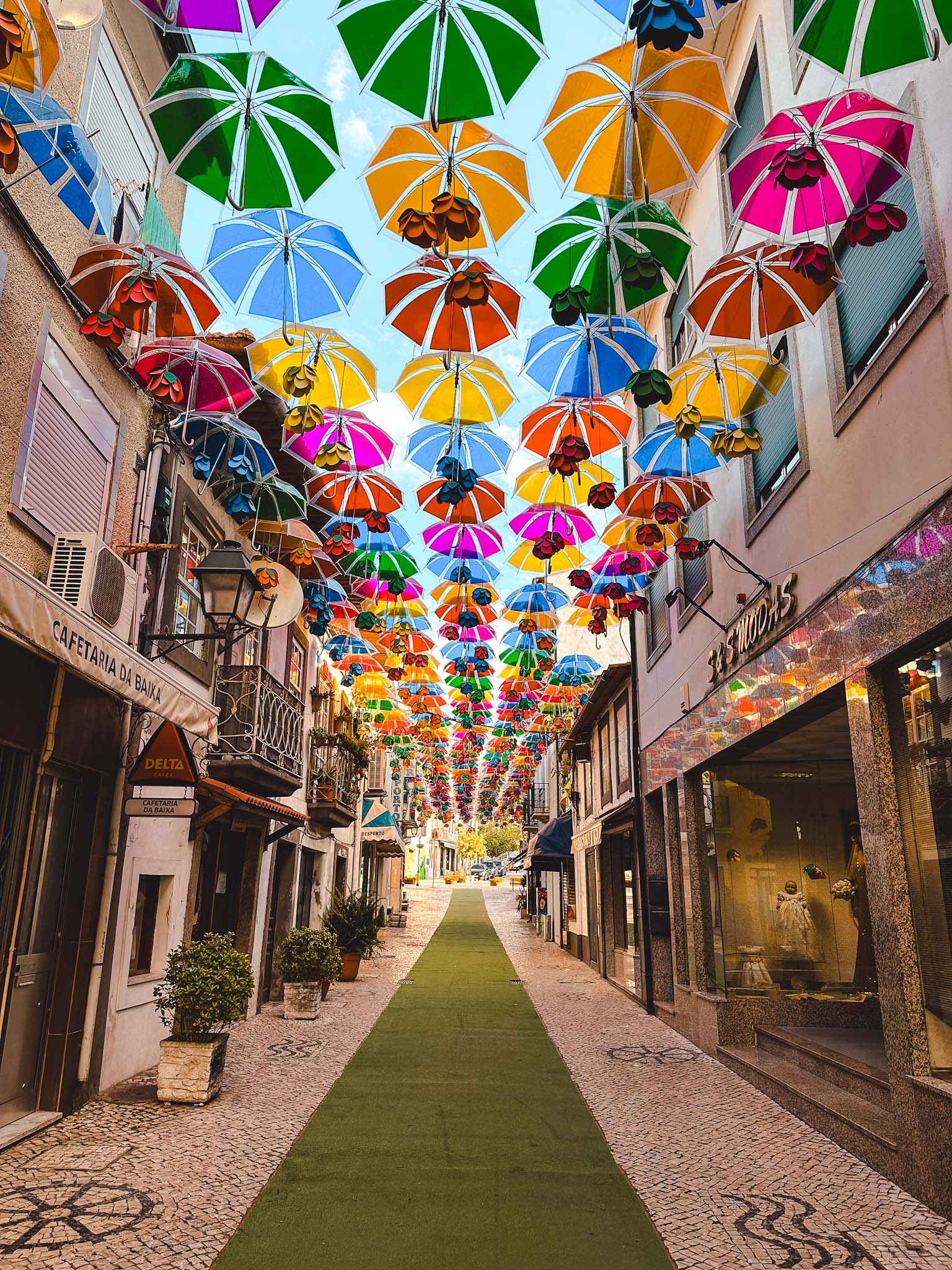

The most important thing to remember is that these decorations are part of the Umbrella Sky Project, an international initiative that takes place in many different cities around the world. In Agueda, this project can be seen from 1st July to 30 September.
They also create a special Christmas project that you can visit during December when the umbrellas are decorated with Christmas lights. If you want to be sure before you go, I recommend contacting Umbrella Sky Project on Instagram.
We loved visiting this place! If you can, I recommend arriving in the morning before the crowds wake up. This way, you’ll have all the streets to yourself like we did! But during the day, you can enjoy the place by sitting in one of the outdoor cafés under the umbrellas!
Location: Umbrella Sky Project in Agueda
18. Praia da Falésia in the Algarve

Praia da Falésia beach was one of those perfect sandy beaches in the Algarve that surprised me the most! Just look at those coastal cliffs! Have you seen anything like this?
The beach is known for its seaside cliffs, displaying vibrant colors like red, orange, and ocre contrasting with light yellow and white, making it a dramatic backdrop to your beach day.
Interestingly, the name ‘falésia’ means ‘cliff’ in Portuguese! When I stumbled upon this place on the internet, I knew I had to come here!
This beach is a massive 6 kilometers long, so plenty of space for all beachgoers. If you’re not interested in having a beach day, try hiking along the dirt trail that goes along the top of the cliffs. The views are unbeatable!
Location: Praia da Falésia – Parking lot
19. Granaries of Lindoso and Soajo
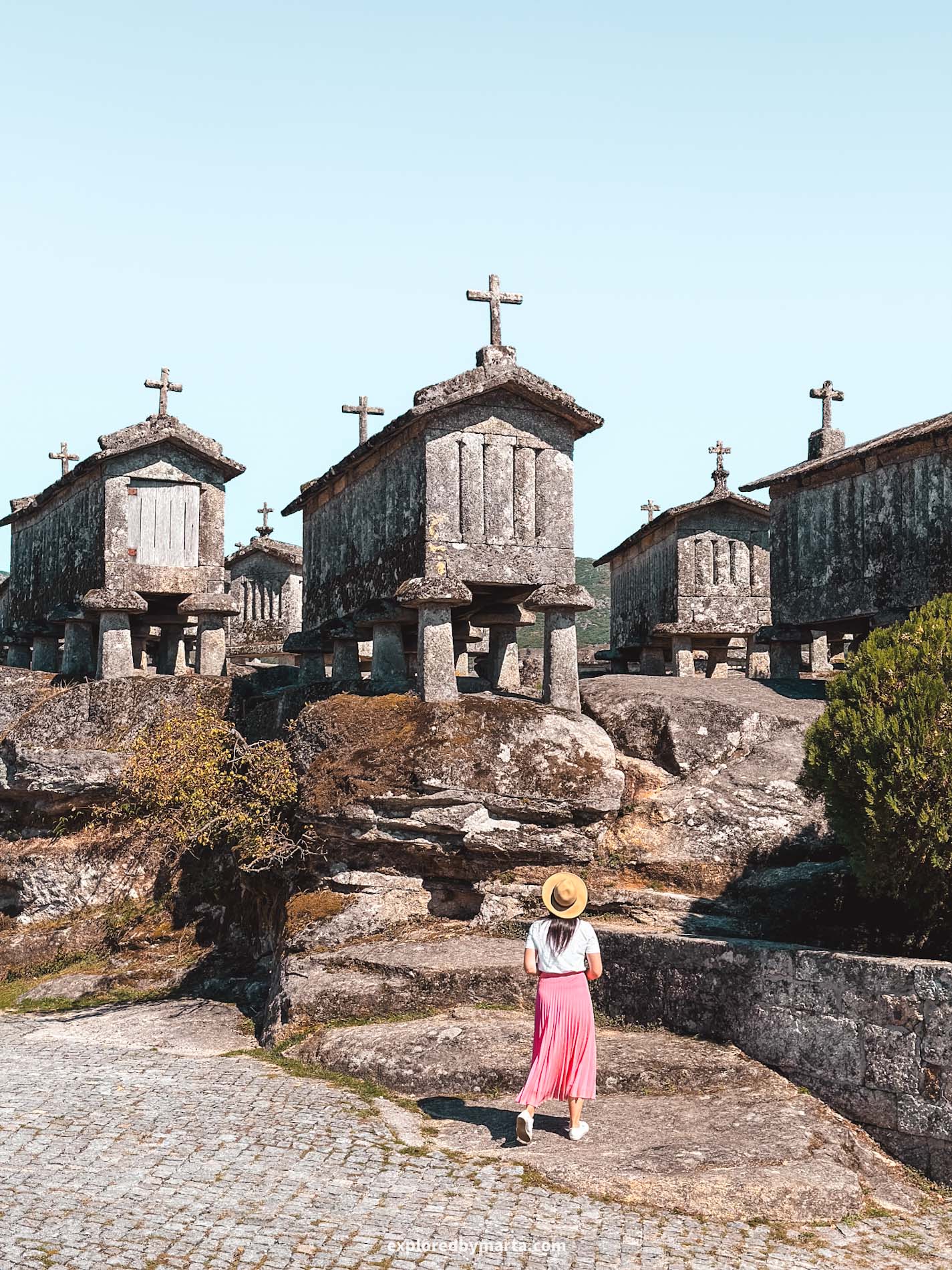
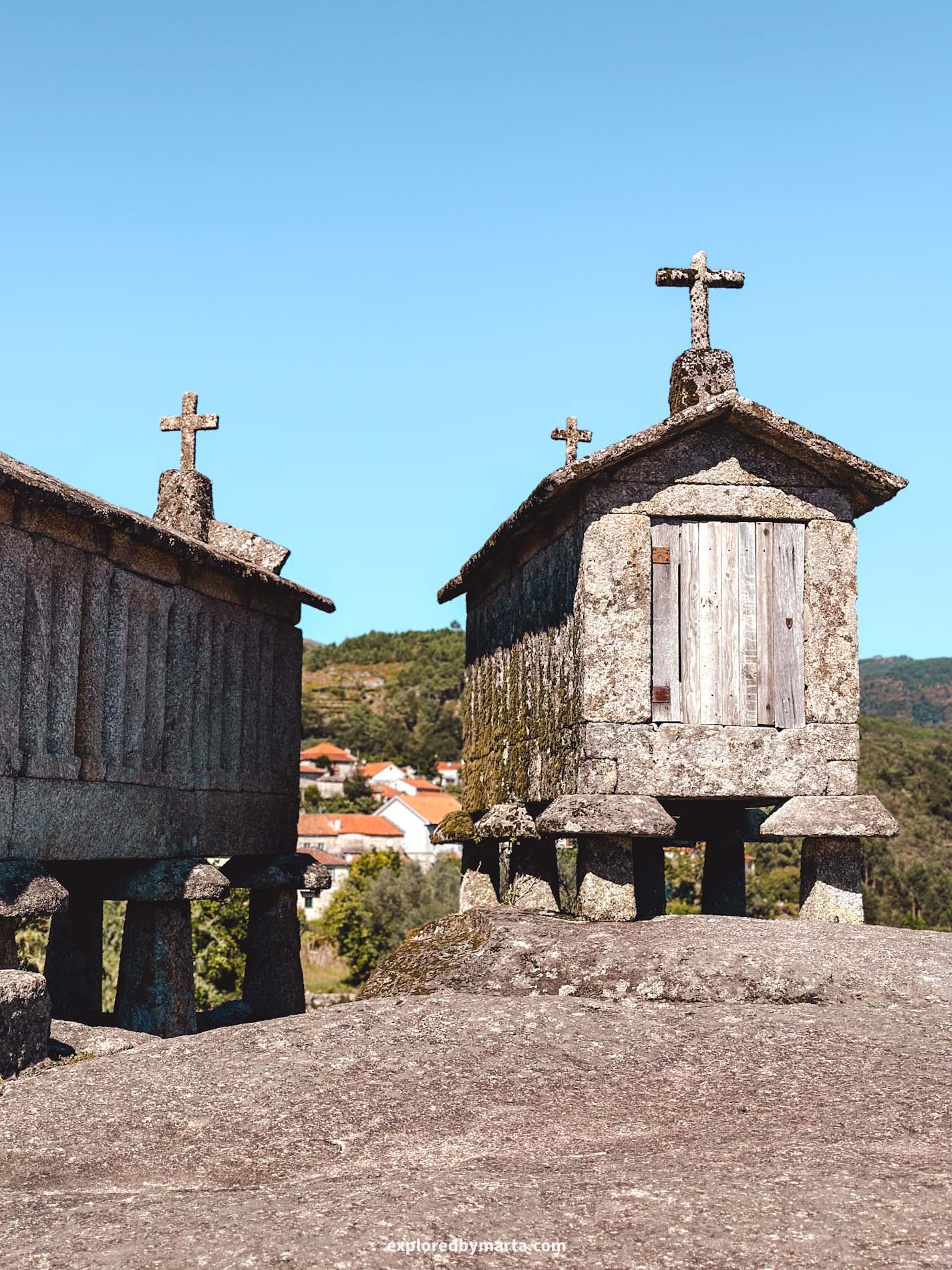
I really didn’t know what these things were. They looked like stone tombs to me with those crosses on top, to be honest. Turns out these are grain storage units typical in Northern Portugal and Spain!
If you, too, like learning about unique places, then head to Soajo or Lindoso, two nearby municipalities in Northern Portugal, where you can see and explore these granaries for free!
They’re just there – out in the open!
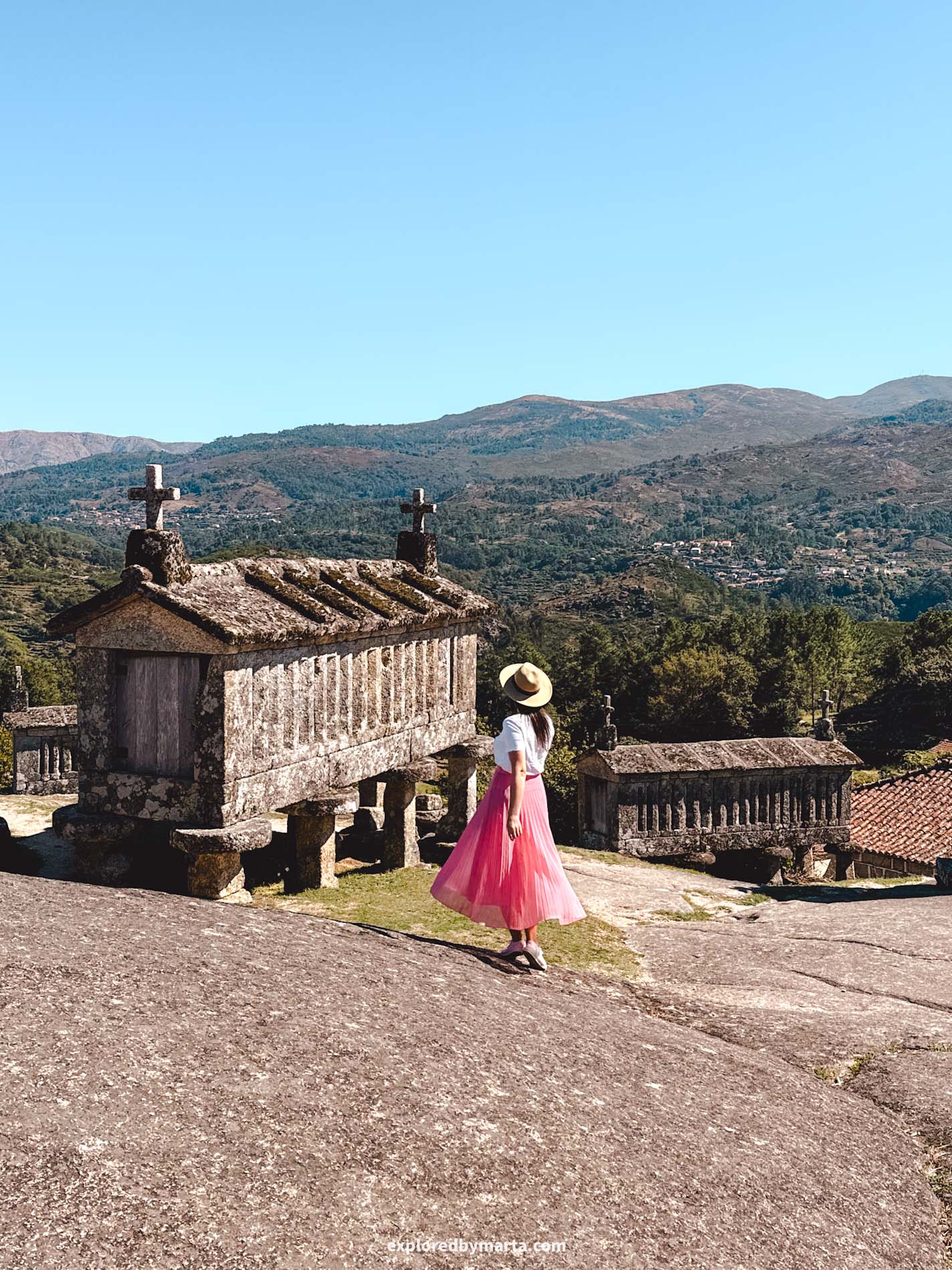

The granaries (‘Espigueiros’ in Portuguese) are built of stone and wood and placed on stone columns above ground so that the crops can ventilate and dry, and also to keep birds and rodents away from the crops.
We even saw some corn inside some of them, which means that locals are still using them! Or were they placed there on purpose? I don’t think so. Although I didn’t check all of them, I saw that many of them were full of stuff.
Talking about hidden gems in Portugal, I think this was one of the most unique places we visited, where I actually learned something new and saw something I hadn’t seen before! This is what traveling is for!
Location: Granaries of Soajo – Granaries of Lindoso
20. Coração da Pombeira
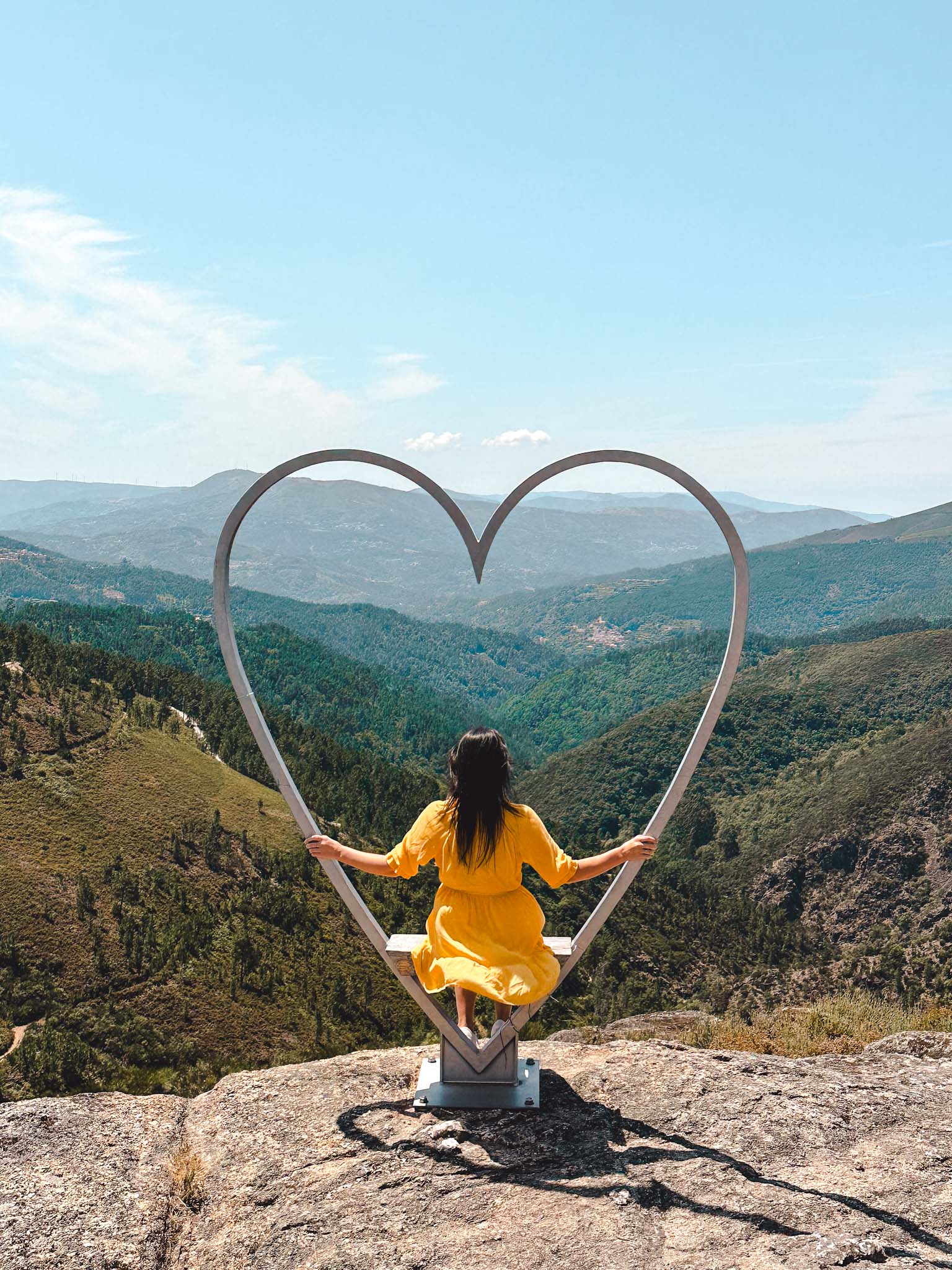
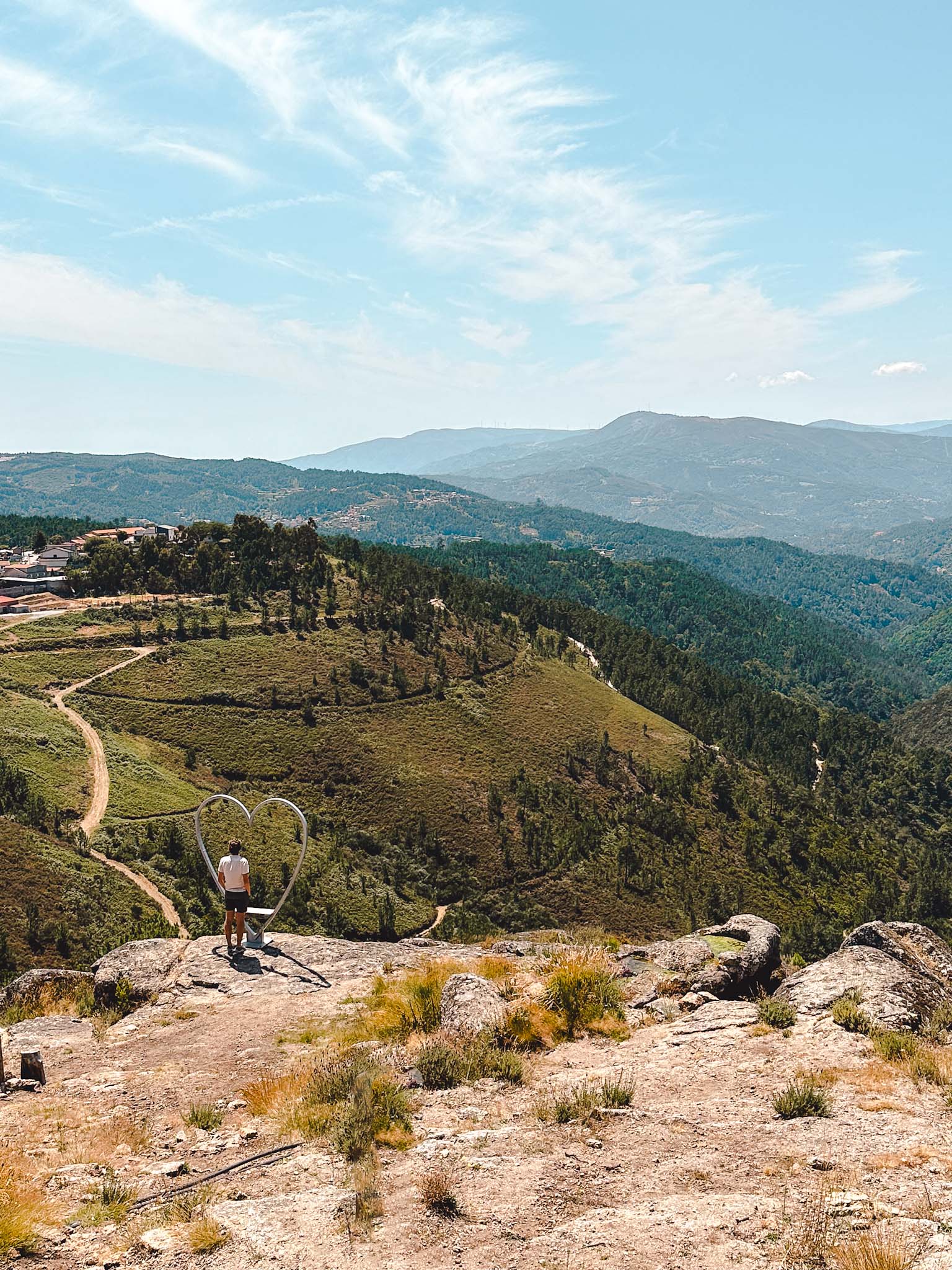
Coração da Pombeira heart is located on a hill in the Castro Daire municipality in Northern Portugal, overlooking the most mesmerizing natural landscape of the nearby hills and a valley between them. One of the most peaceful places I visited in Portugal!
I really enjoy these kinds of remote places that, seemingly, no one knows about, so it was definitely one of my favorite viewpoints we visited in Portugal!
The heart sits on a hill right next to the road. We parked our car at the bottom of the hill and then hiked about 5 to 8 minutes up. Although the climb is quite steep, it is not too long, and the view is rewarding. Imagine visiting this place during the sunset!
Location: Coração da Pombeira
21. The blue church of Igreja Paroquial de Cortegaça
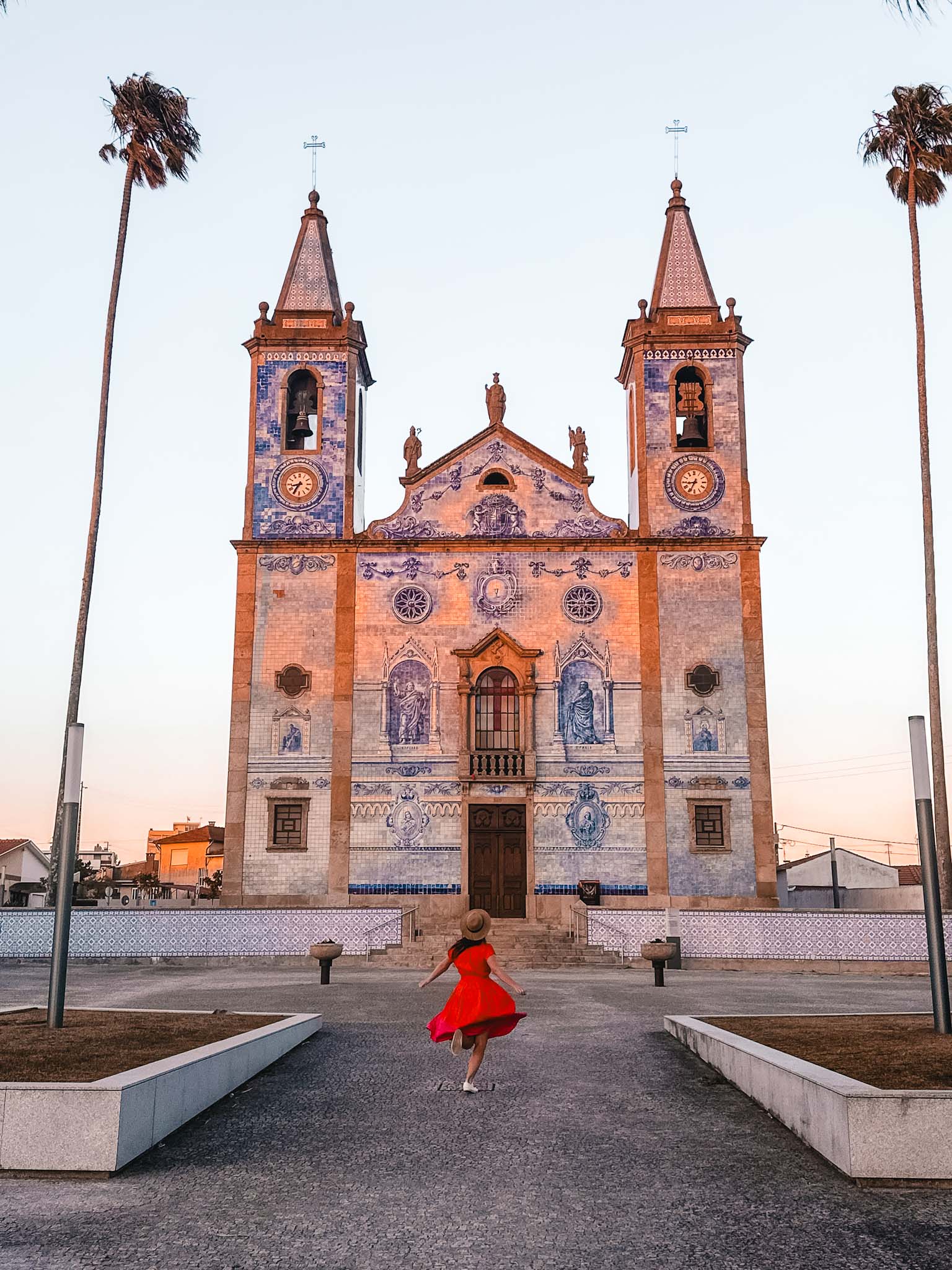
Located in the Cortegaça village in the Aveiro district is this wonderful sight you will remember forever – the stunning Igreja Paroquial de Cortegaça church, or the blue tile church!
The building that we see today was completed in 1918 and was built to replace the old temple, dating back to the middle of the 12th century.
But, really, if you build new places on top of old buildings, they should look just as impressive and unique as this church turned out, am I right?
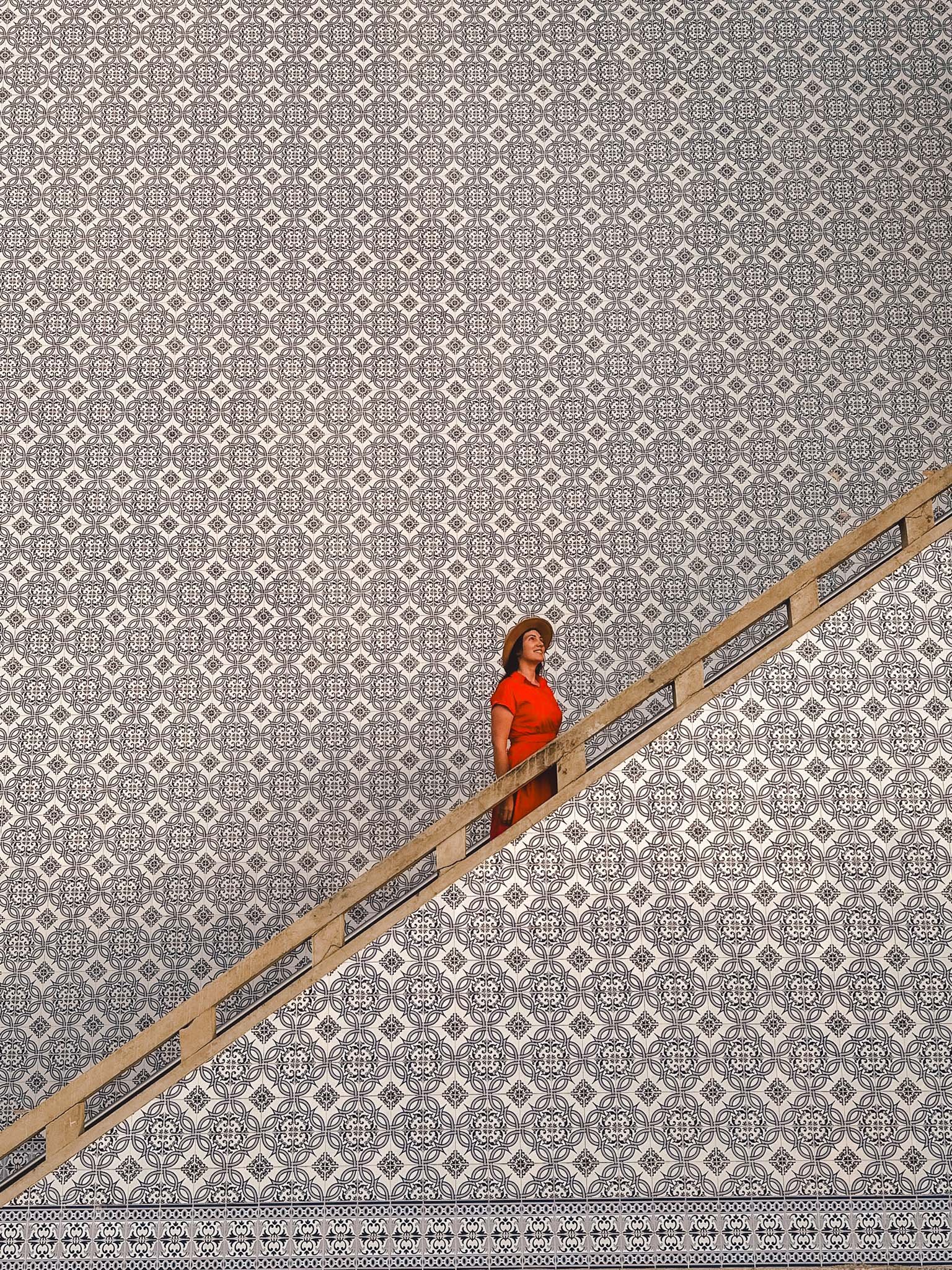
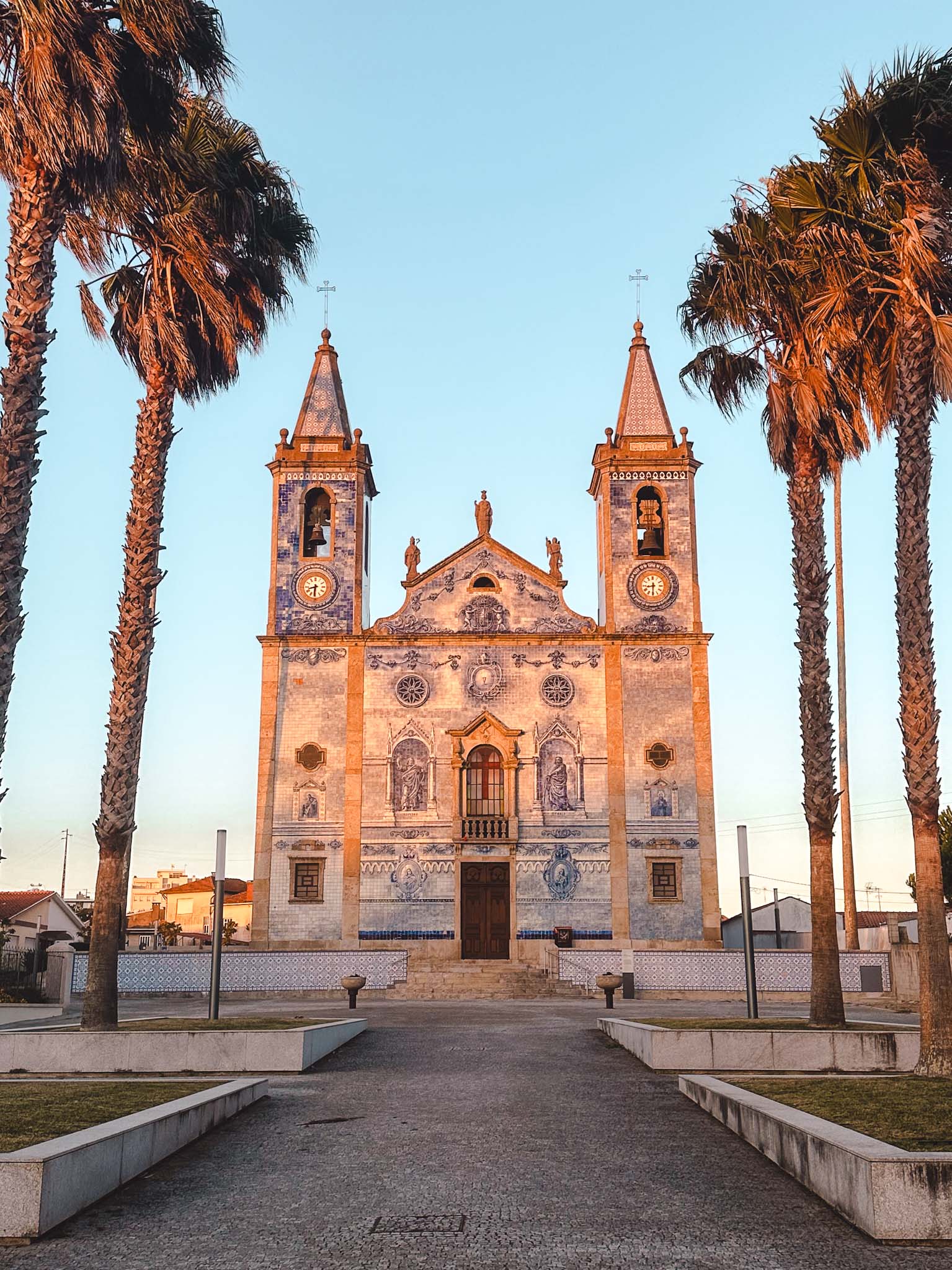
This striking church is located in a square at the end of an alley of palm trees. The incredible facade was covered with tiles between 1921 and 1923 and depicts religious figures.
The church also has two flanking towers topped with spires. I love the creativity that went into this church! I could only silently admire everything I saw here – it was magical!
This church is definitely one of the most exquisite examples of Portuguese tile artworks and one of the most beautiful churches in Portugal. And you must see it!
Location: Igreja Paroquial de Cortegaça
22. Santuário de Nossa Senhora da Lapa
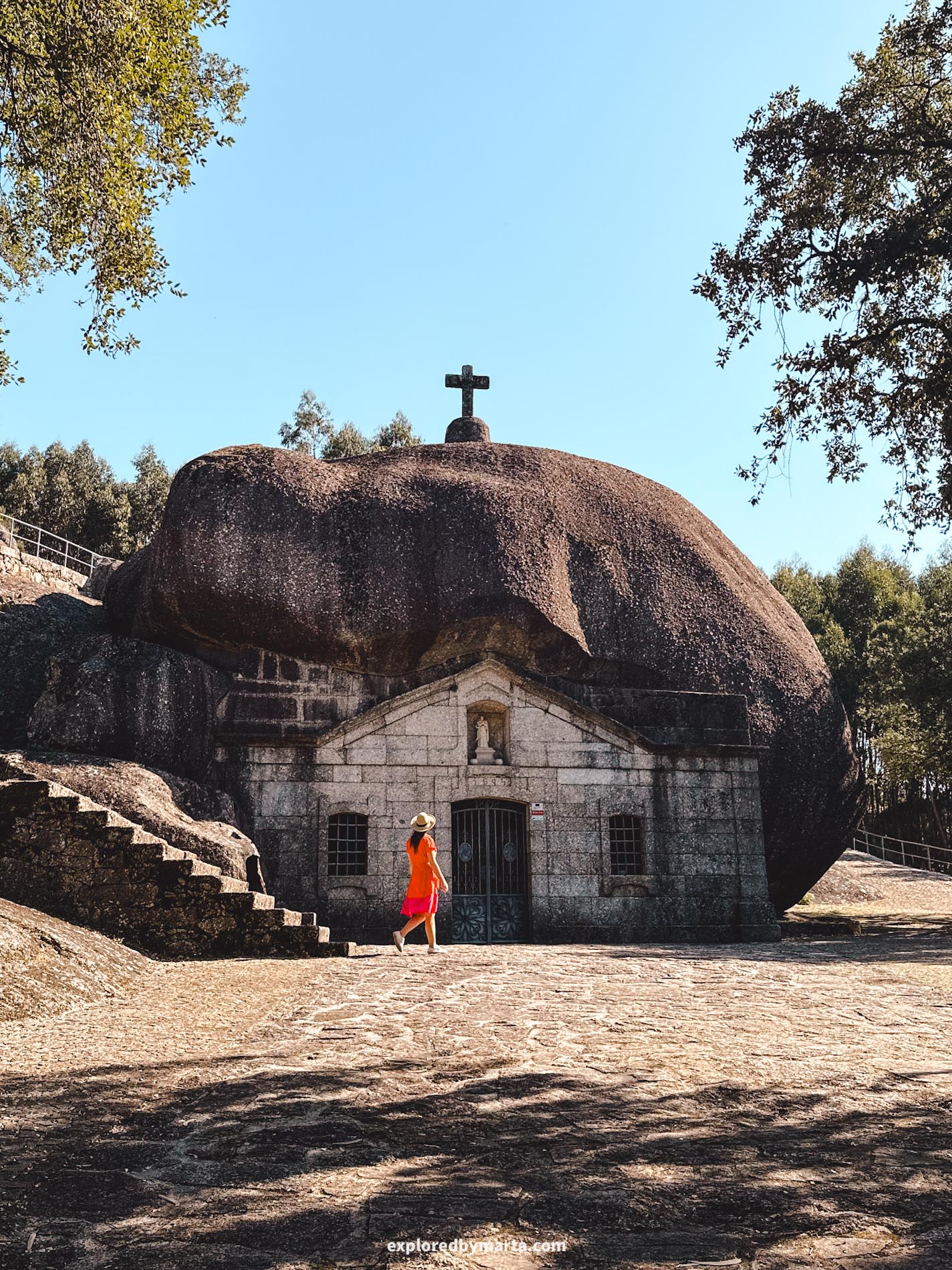
The Chapel of Our Lady of Lapa in the Soutelo municipality in Northern Portugal was one of my favorite discoveries during our travels around the country.
This original sanctuary was built at the end of the 17th century and stands out with its unique layout – the sanctuary was built inside a rock, which serves as the roof of the building.
The little sanctuary is closed, but you can go see it and peek inside through the gates.

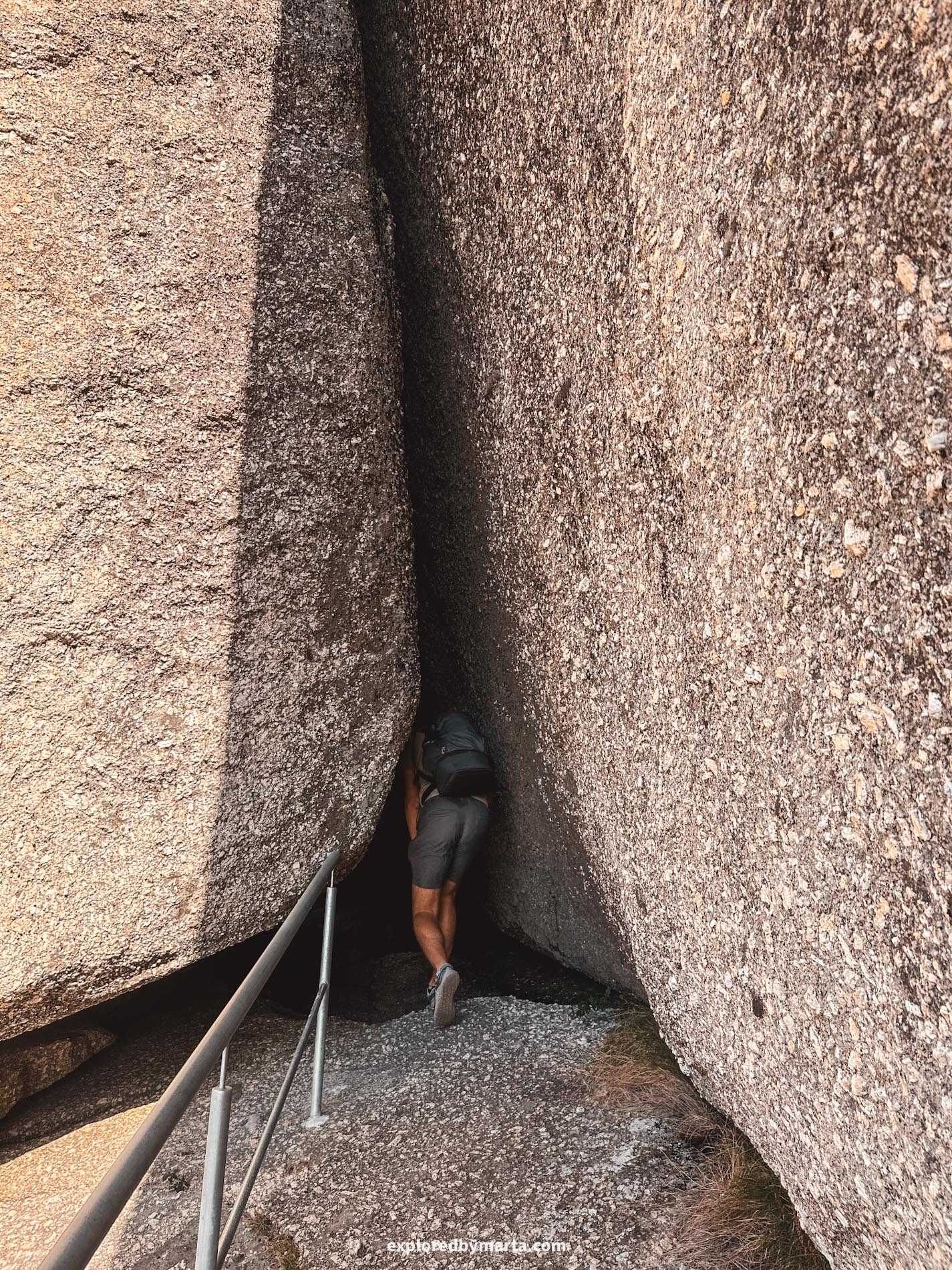
The chapel sits on the Penamourinha Hill and is accessible by car. We parked at a picnic area right before it and then walked to the chapel as well as the viewpoint above it on foot.
The viewpoint, accessed by a path carved into rock, offers panoramic views of the surrounding mountains and the lush greenery.
If you are ever going on a road trip to destinations like Braga or Peneda-Gerês National Park, the only national park in Portugal, consider stopping by this place!
Location: Santuário de Nossa Senhora da Lapa
23. Praia do Penedo do Guincho
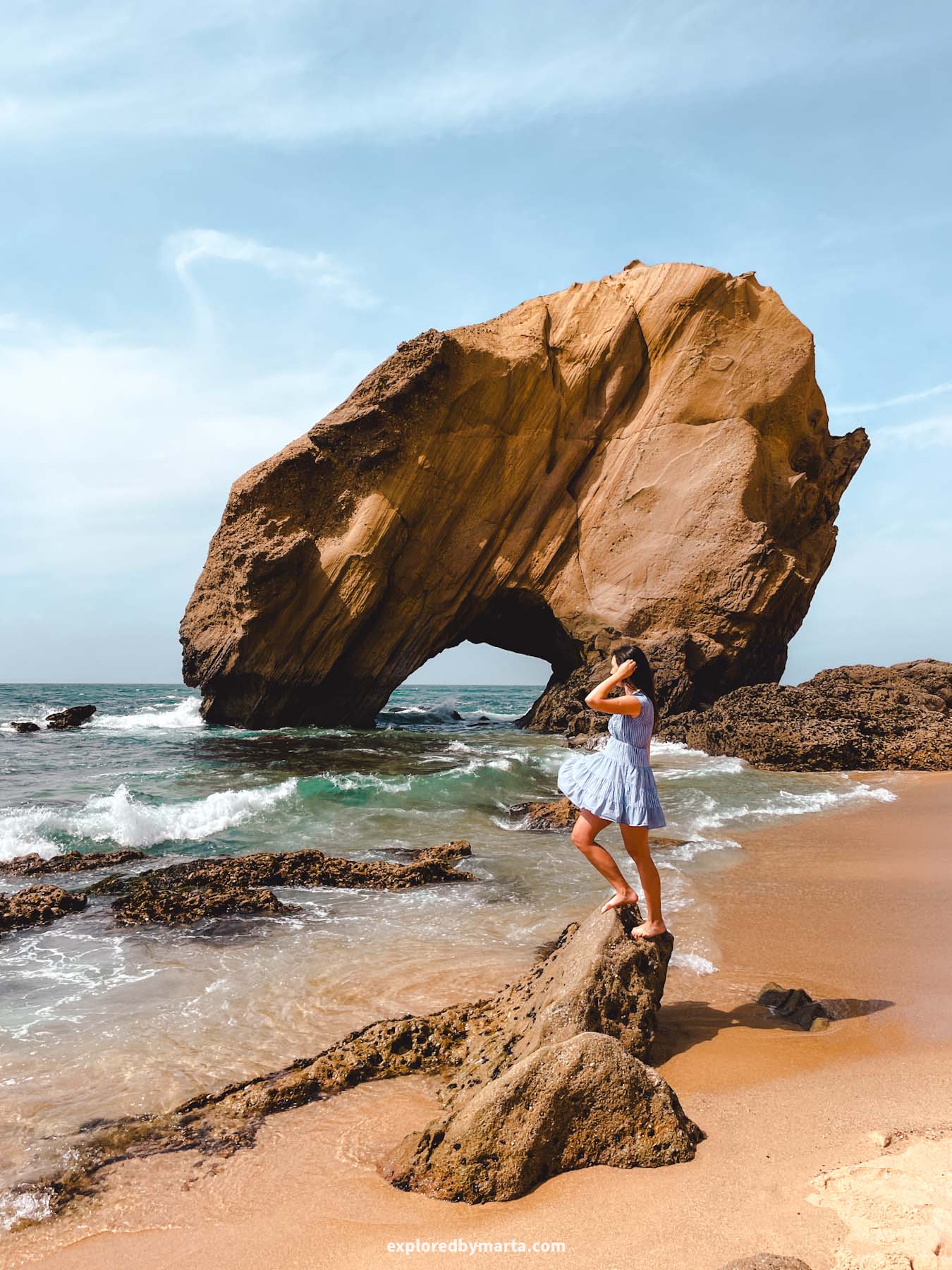
Praia do Penedo do Guincho is one of those beaches that still feels like a secret. Located a 1-hour drive from Lisbon on Portugal’s western coast, it’s known for its dramatic rock formations, golden sand, and wild Atlantic waves.
The beach takes its name from the massive rock sitting close by the shore (see photo above).
Praia do Penedo do Guincho is surrounded by cliffs and dunes, making it a great spot for those who love raw coastal scenery. The waves here can be strong, so it’s not ideal for swimming, but some people did jump into the water right by the shore.
Overall, we loved its wild, rugged beauty! Even tho we didn’t go for a swim, we thoroughly enjoyed relaxing by the coast and listening to the sound of the ocean. It is definitely one of the most unique beaches in Portugal!
Location: Praia do Penedo do Guincho
24. Miradouro da Serpente do Medal
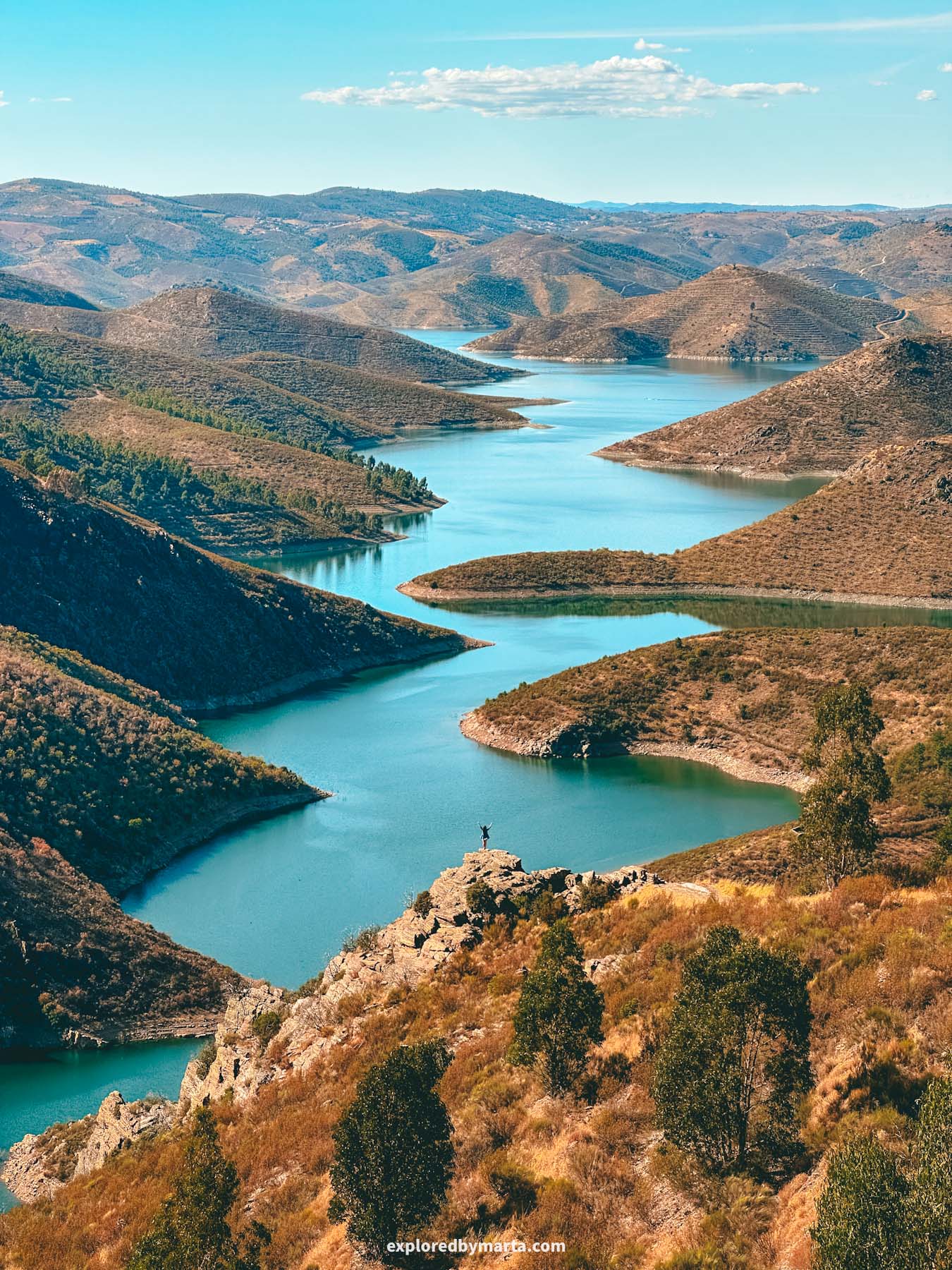

Welcome to the wild side of Portugal! Located in the far northeastern Portugal, Miradouro da Serpente do Medal is one of the remotest places you can find on the map. But it is also one of those unforgettable places that stay with you after the visit.
This viewpoint is reserved only for adventurers. If you are driving around Portugal and staying in different places along the way, maybe you can plan a visit to this iconic miradouro. Otherwise, it is just too far from any regular tourist routes.
Not only is it far removed from civilization, but you also need to manage a drive on gravel roads and then a 15-minute hike further downhill to reach this remote spot.
I mean, if you have a 4×4, you might be able to drive up to the viewpoint, but for a regular rental car, the dirt road is way too steep, in my opinion. We parked by the road about 1.2 kilometers before the viewpoint (right before the steep descent) and continued on foot.
The viewpoint is a rock outcrop next to the river, and it is known for its incredible natural beauty and for its unique view – the snake-shaped section of the Sabor River, another tributary of the Douro River.
I loved this place so much! Getting there through quiet rural roads surrounded by green hills and forests only added to its charm. And the fantastic view at the end was a cherry on top. It is one of my favorite viewpoints in Portugal!
Location: Miradouro da Serpente do Medal
25. Monsaraz, one of Portugal’s oldest settlements
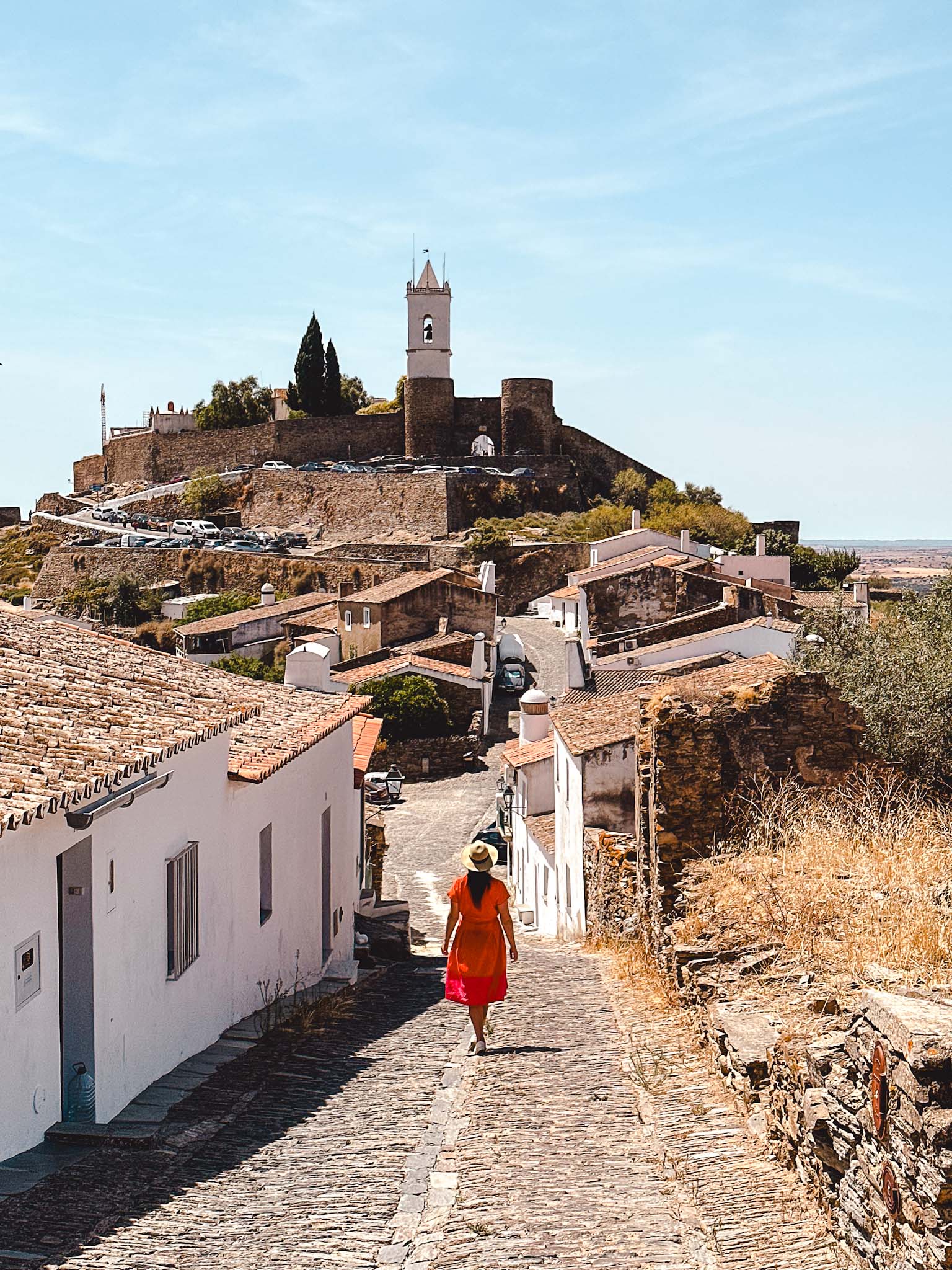
Monsaraz is a village in Évora district near the border of Spain. It sits on a scenic hill and is one of the oldest settlements in southern Portugal. The most important landmark in Monsaraz is the medieval castle – Castelo de Monsaraz.
Due to its strategic location near the border and its advantageous position on a hill, it was once an important stronghold during many military conflicts that the country has experienced over the centuries. Monsaraz was under the rule of many different forces.
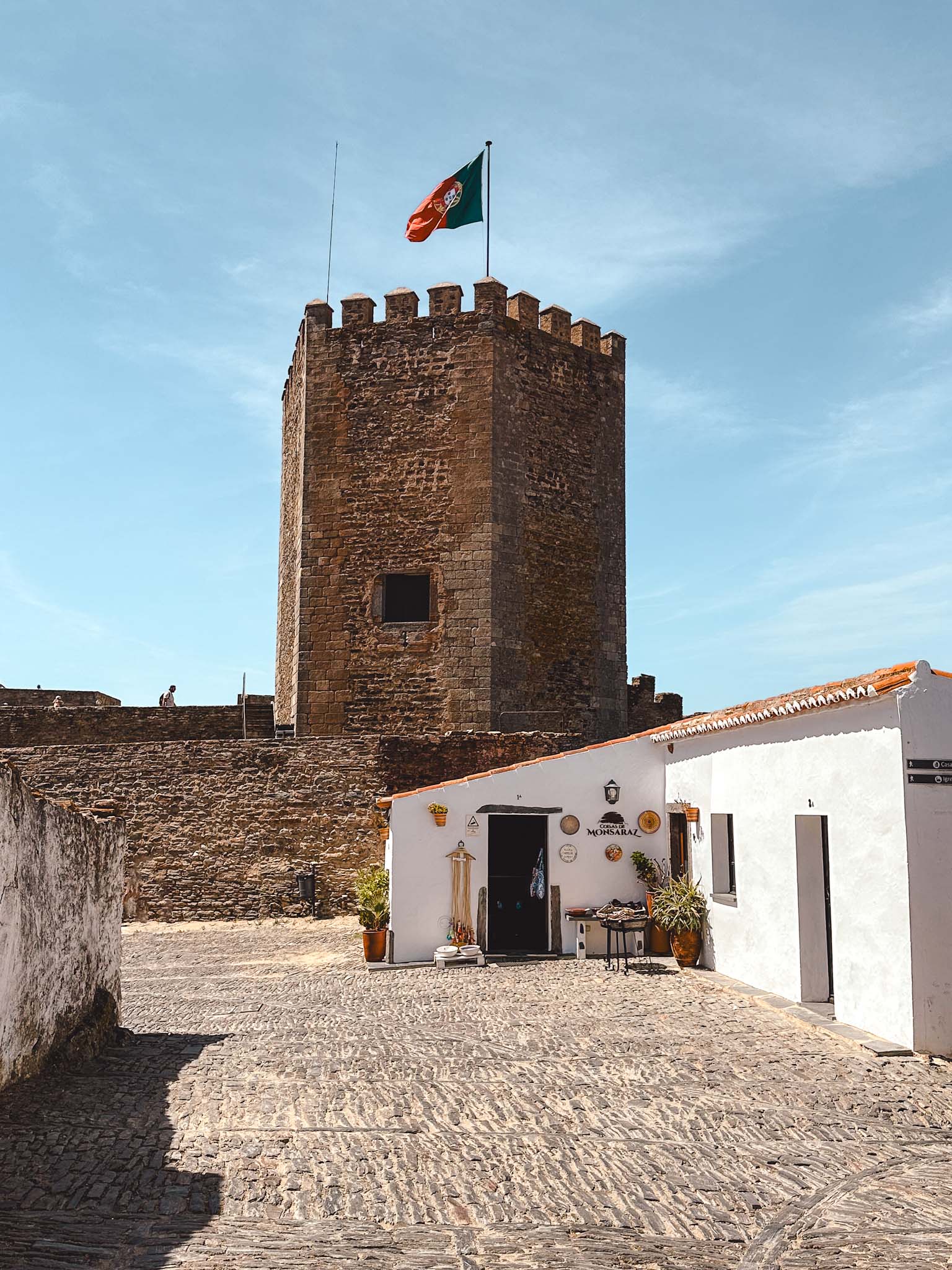

The imposing castle dates back to the 14th century. Much of what was built back then has still remained to this day. Walking around this medieval village felt like a time machine transporting me back in time.
You can visit the Castelo de Monsaraz for free. From the top of the castle walls, you will get amazing views over the surrounding area, especially the Alqueva water reservoir created by the Guadiana River – it is the largest artificial lake in Western Europe.
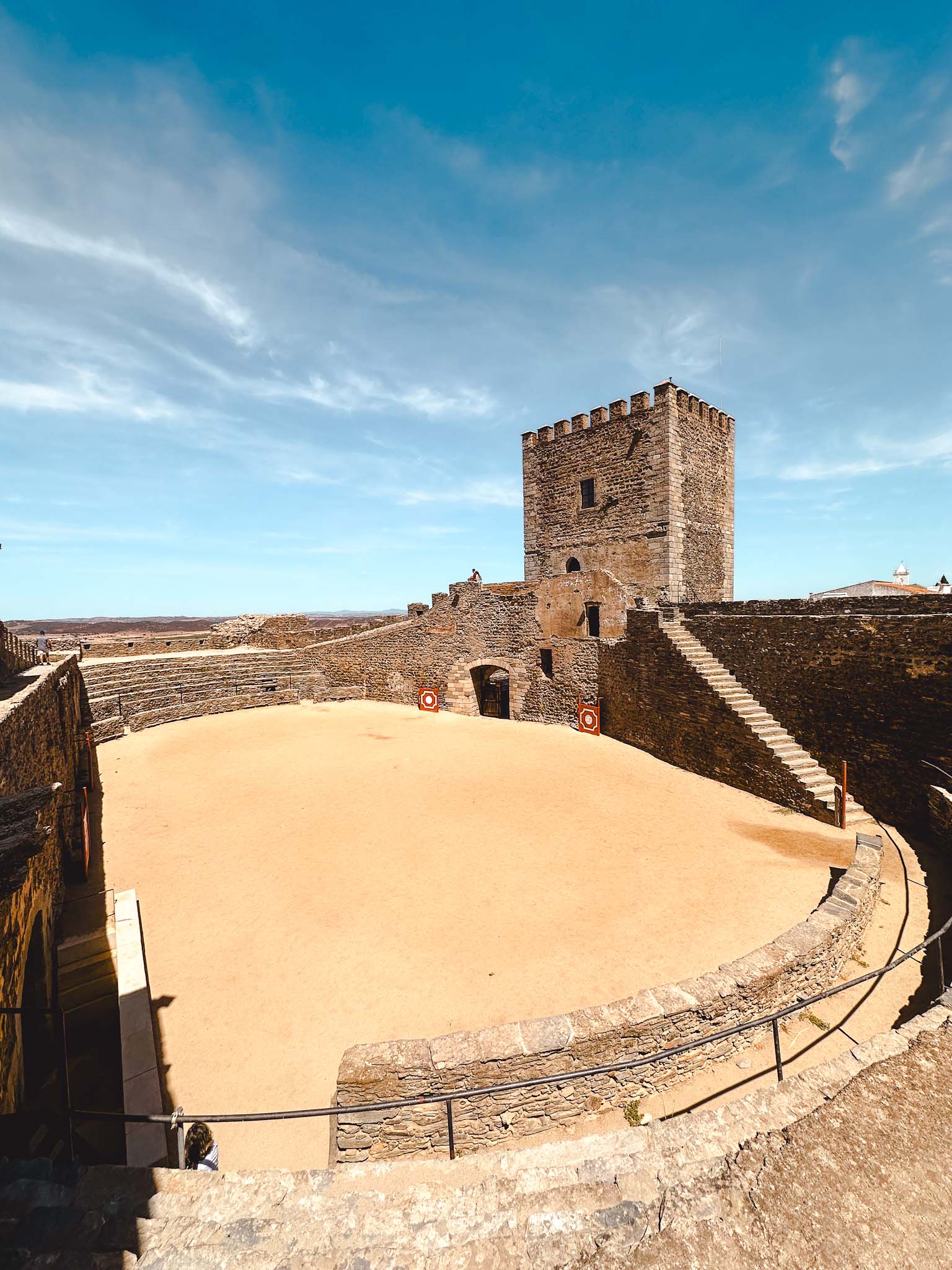
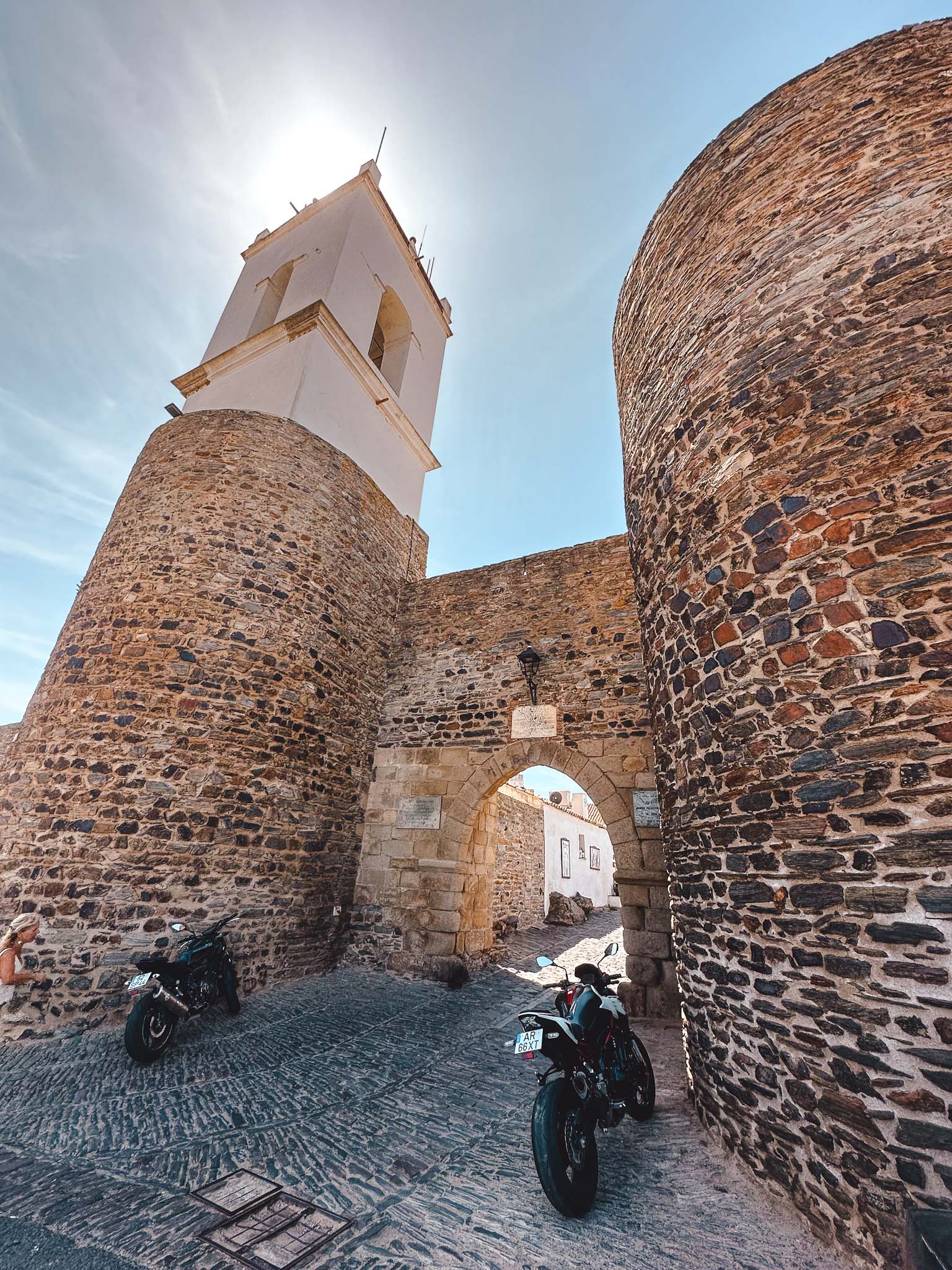
There is not much left of the castle itself, so the views over the area, climbing up to the defensive walls, and walking around them was all that we got there. The inner enclosure of the castle today is used as a bullring.
I loved walking around the medieval village. It has whitewashed houses, narrow cobblestone streets, and stone defensive walls with only a couple of entrances, so you have to check where you can enter this fortification.
You can’t drive inside the village, so you will have to park your car outside the walls and then climb up to the village on foot. See the parking location on Google Maps below. If you are into lost places from medieval times, then this is the perfect place for you!
Location: Castelo de Monsaraz – Parking lot
26. Baloiço do Mezio, one of the highest swings in Portugal
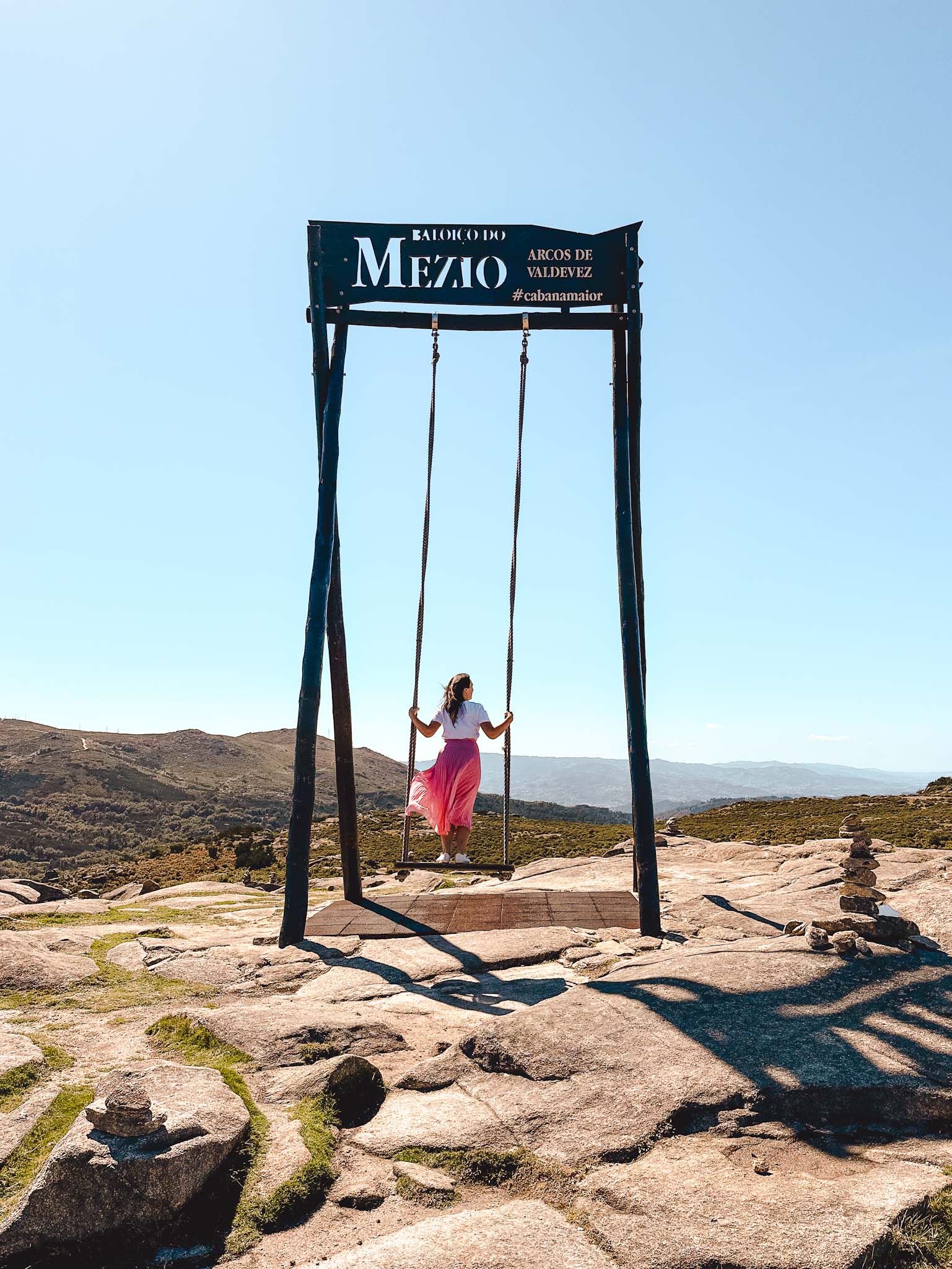
Portugal is known for having swings in the most scenic, remote places, so don’t be surprised if you see quite a few of them during your travels! Probably, the best swing in Portugal for the most panoramic views is Baloiço do Mezio.
The Mezio swing sits on a rocky mountain in the beautiful Peneda-Gerês National Park in the North of Portugal. You cannot imagine a more picturesque landscape than this!
The swing is easy to get to if you have a car. In case you are traveling around Northern Portugal, you must stop at this swing to admire the views! We left our car next to the road and then walked to the swing. It is about a 5-minute walk from the road.
Location: Baloiço do Mezio
27. Castelo de Almourol, the castle inside the river
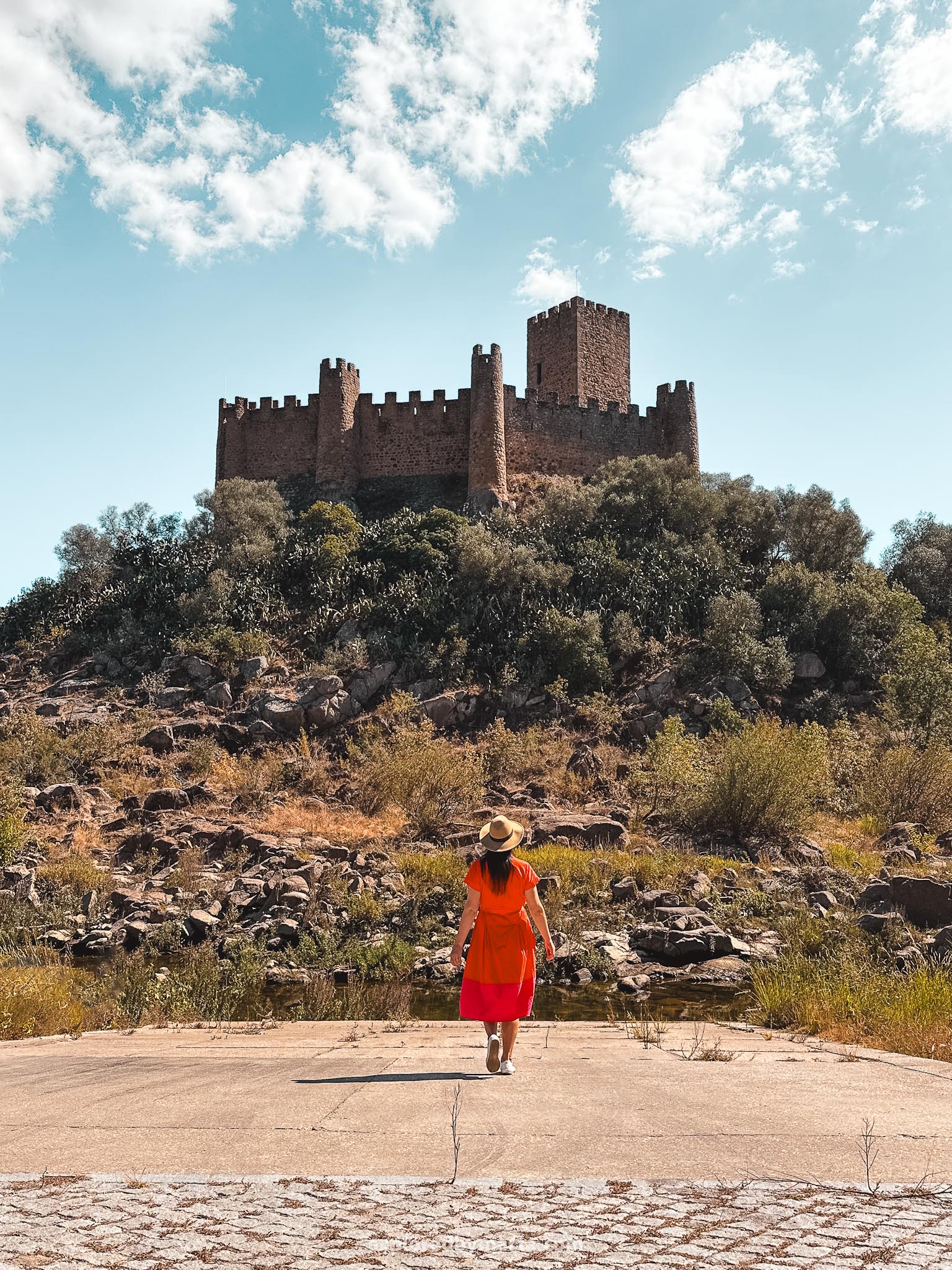
The Castle of Almourol is a medieval castle sitting on a small 300-meter islet in the middle of the Tagus River – the same river that flows through Lisbon and into the Atlantic Ocean – making it one of the most unique castles near Lisbon.
The Almourol Castle was built during the 12th century to protect the Southern border of the Portuguese lands against the Moors. At least, at that time, this location along the river was the border.
The castle, which is like a small fortress, was controlled by the Knights Templar, one of the most influential Catholic military orders.


It is believed that the castle was built on top of a military structure from ancient times that was later conquered by the Romans during the 1st century before our era. This makes it pretty special!
Visits to the castle are free; however, to get to the castle, you must take a boat that costs 4 EUR for a round-trip. It is forbidden to walk over there, even if the water level in the river is low.
Once you get to the island, you have about 40 minutes there to explore the castle before the boat arrives to pick you up. The boat trip takes only 5 minutes.


The visit to the Castle of Almourol felt like stepping back in time.
The castle has high walls and defensive towers where you can climb up and get a great view over the Tagus River. Be careful, as there are no fences protecting you from falling off the wall!
Although this is not among the most popular castles in Portugal, I loved visiting such a hidden gem with such a rich history. People who protected this hilltop fortress created the foundation of the Portuguese nation as it is today.
Location: Castelo de Almourol
28. The oceanfront Capela do Senhor da Pedra

The oceanfront Capela do Senhor da Pedra, one of the most picturesque chapels in Portugal, is a bit of a hidden gem, but it’s also not. Locals know about it very well, but not many tourist guides mention this unique place.
So why is it unique? The tiny 17th-century chapel is built on a rock outcrop in the most photogenic setting – right on the edge of the ocean in Miramar, a short ride south from Porto (you can reach it by train).
When the wind is bigger and the tide is high, the chapel is surrounded by dramatic waves that come crashing down against the rocks. It looks pretty epic! This place is both peaceful and wild!
But on a nicer day, this is a wonderful place to spend time at the beach. There’s a nice promenade nearby with cafés and small restaurants.
However, I’d also consider coming here in the morning for sunrise hues or in the evening to watch the sun go down into the ocean with waves painted in golden sunset views.
Location: Capela do Senhor da Pedra
29. Miradouro do Ujo

Miradouro do Ujo is a breathtaking viewpoint in Northern Portugal. It is located next to the Tua River, not far from where the Tua meets the Douro River (Tua is a tributary of the Douro River).
I love how dramatic the viewpoint is – the stairs are hanging over the deep river valley below, offering spectacular views of the green hills around it. It is literally floating in the air!
The viewpoint is the perfect place to pause during one of your road trips through Northern Portugal (which you will definitely do, am I right?).
It is also easy to reach by car, as the viewing platform is located right by the road. If you’re exploring the Douro Valley, this viewpoint could be one of the best places to capture the natural beauty of the region!
Location: Miradouro do Ujo
30. Fidalgo’s Works

Fidalgo’s Works, or Obras do Fidalgo, is one of the most unusual and fascinating hidden gems in Portugal.
Located in the small village of Vila Boa de Quires, this a bit mysterious 18th-century structure looks like something out of a fantasy movie.
The site was meant to be a grand manor house for a wealthy nobleman (fidalgo=wealthy nobleman), who, apparently, wanted an extravagant residence. However, the project was never completed.


Today, what remains are ruins of a beautiful, detailed stone facade. Some say it is one of the most beautiful Baroque facades in Northern Portugal.
Although the site is now on private land, you can still see it up close from the road. They often host weddings, concerts, and other private events in front of these timeless ruins (as you can see from stacks of chairs left in front of the ruins, haha).
Can you imagine what this mansion could have looked like?
Location: Obras do Fidalgo
31. Santuario de Nossa Senhora da Peneda

The Sanctuary of Nossa Senhora da Peneda is one of Portugal’s most scenic and peaceful religious sites, hidden far away in the Peneda-Gerês National Park in the country’s far north.
The mountain sanctuary is surrounded by dramatic granite mountains, lush forests, and a waterwall right next to it, which creates the perfect retreat.
We did a couple of road trips around the national park and decided to stop by along the way. This place was so quiet and serene!


Built between the 18th and 19th centuries, the sanctuary is often compared to the famous Bom Jesus do Monte in Braga because of its impressive Baroque staircase.
However, it is not nearly as grand as the one in Braga. But it is definitely much more peaceful and quiet, haha!
The staircase climbs up the hill and is beautifully decorated with statues. At the top of the hill, you will find the iconic mountain church. Entrance to the church is free, but it does have opening hours, so make sure to check that before you come.


The views from the sanctuary are spectacular, and the surrounding landscapes are breathtaking. Just look at that massive rock mountain with a waterfall next to the church!
Each September, the Sanctuary of Nossa Senhora da Peneda hosts an annual pilgrimage that attracts thousands of visitors. But I’d rather go there at a different time to enjoy the peaceful atmosphere.
Either way, if you are an individual traveler and love exploring quiet but beautiful places like this, then this hidden sanctuary is the place for you! And you don’t have to be religious to enjoy architecture, nature, and stunning scenery!
Location: Santuario de Nossa Senhora da Peneda
32. Baloiço do Monte de São Pedro Fins

Yes, I loved finding swings in beautiful locations in Portugal, and Baloiço do Monte de São Pedro Fins is one of my favorite swings in the country!
It is an unusual-looking swing with a circular seat hanging in a wooden frame, with its name carved into wood and placed on top of the swing. It actually doesn’t swing at all, haha.
The best part of Baloiço do Monte de São Pedro Fins swing is the view. Located just 20 kilometers North of Braga, the swing overlooks Caires parish in the Braga district.
We experienced the most magical sunset on this hill, and probably that’s why I have such fond memories of this place.
Getting to the swing is quite easy by car. You can drive to the very top of the hill. The road gets preeettty steep, but it is paved, so we had no problems getting there. The swing is located just 100 meters from the parking lot.
Location: Baloiço do Monte de São Pedro Fins
33. Santuário de Santa Maria Madalena de Falperra


Here’s another cool spot near Braga and one of my favorite finds in Northern Portugal – Santuário de Santa Maria Madalena de Falperra.
This incredibly beautiful sanctuary is located just outside Braga, and was designed by the famous André Soares, one of Braga’s most important Baroque architects, who has designed many landmarks in the city and around it.
The beautiful Baroque church is surrounded by the lush green hills of Falperra, and might not be as famous as Bom Jesus do Monte or Sameiro, but it’s absolutely worth a visit for its stunning Baroque facade and peaceful setting.


The ornate stone facade is the most beautiful of all the churches we’ve seen in Braga! Do you agree that this tiny chapel has a more beautiful facade than the famous Bom Jesus do Monte, or am I the only one who thinks so?
This 18th-century church features intricate carvings and statues, and it is actually known as one of the best examples of Baroque style in northern Portugal. There you have it!
We didn’t get to visit the inside of this small church, but the views from the hill were more than enough. Plus, there was nobody around besides us, so if you love hidden gems, this is a great spot to include in your itinerary!
Location: Santuário de Santa Maria Madalena de Falperra
34. Barragem do Varosa


Barragem do Varosa is a peaceful hidden gem located in northern Portugal, not far from the town of Lamego, so if you visit Lamego’s majestic sanctuary, you might want to stop by this place!
Barragem do Varosa is a scenic dam and reservoir surrounded by green hills and rocky landscapes.
And it actually is a pretty impressive dam. Built on the Varosa River, the 76-meter-high dam was opened back in 1976. It is over 200 meters long.
I especially loved its zigzag staircase running down one of its sides. You can also see panoramic views of the Varosa River valley, where the water flows into a rocky river canyon.
If you are into industrial architecture, you’ll love how peaceful yet powerful this place is! We stopped here for a 10-minute pause during our road trip and really enjoyed this scenery.
Location: Barragem do Varosa
Happy exploring!
Portugal’s rich heritage, breathtaking landscapes, and diverse attractions make it a must-visit European destination for every traveler. This captivating Southern gem transports you to a world of limitless wonder and discovery.
From ancient villages, majestic castles, and cobblestone streets in vibrant cities to picturesque mountains, scenic rivers, and tranquil vineyards in the countryside, there is an abundance of places to explore in this bucket-list country.
Over time, we have spent almost a year in Portugal and explored everything it has to offer! I hope you enjoy your time there as much as we did, and I hope you get some travel inspiration from this blog post for your travels, too! Cheers!
PIN FOR LATER!



Hi Marta
Super useful, beautiful photographs, well written – It is helping me plan my Portugal trips a lot. Binge reading your Portugal posts. Thanks
Thank you, Sahana! Have a great trip!